

A Memorable 3-week Canadian Rockies Itinerary: An RV roadtrip
A roadtrip to never forget: a 3-week canadian rockies itinerary with an rv.
This trip was one to remember. Thinking back about it, I’m still so pleased I’ve been able to do this trip. An RV road trip through the Rocky Mountains, Canada. How great does that sound? In between assignments for my job, end of September 2018, I’ve been able to go on a 3-week Canadian Rockies trip, a road trip with an RV. Before the trip, I’d done a whole lot of research on the route, the best places to stay, what hikes to do, and what other places to visit to draft up the perfect 3-week Canadian Rockies Itinerary. Visiting the Canadian Rockies was a dream coming through and I did want to get the most out of these 3-weeks in the Canadian Rockies. All my personal experiences and prior research are covered in this extensive travel guide to the Canadian Rockies through British Columbia and Alberta.
Day to Day travel plan (itinerary):
Day 1&2: Vancouver Day 3: RV pick-up and drive to Whistler Day 4: Hike Garibaldi Lake Day 5&6: Drive and Well’s Grey Day 7 t/m 10: Discover Jasper National Park Day 11&12: Driving the Icefields Parkway
Day 13&14: Lake Louise Area Day 15&16: Banff National Park Day 17: Yoho National Park (Emerald Lake) Day 17&18: Kelowna Day 19&20: Vancouver
A travel map to the canadian rockies
|| start your canadian itinerary in vancouver (2 nights)
Vancouver is the starting point of our RV road trip covering the regions of British Columbia and Alberta. Vancouver is a great city with a wonderful food and drink culture. You can enjoy yourself here for a couple of days exploring different parts of the city, visiting Granville Island, exploring Yaletown, discovering Stanley Park, and heading towards Downtown Eastside to explore many craft beer breweries. We stayed here for 2 nights, which meant we had 1 full day to discover Vancouver, as on the 2nd day we had to pick up our RV for the trip.
We stayed in GEC Granville Suites Downtown , which was a perfect and affordable hotel in a central location.

|| Whistler area and garibaldi lake (2 nights)
We picked up our RV from Fraserway. We had a hotel pick-up that brought us to Delta, the area where we could pick up the camper. This took a while, as there was some paperwork to do, using the camper was explained, and of course some waiting time. We loaded our suitcases in the RV and around noon – we were ready to go!
From Delta, we drove towards Whistler where we found a Walmart on the way and decided to do our groceries. We tried to buy as many preservable foods as possible for the 3 weeks (say hello to pancakes in the morning, frozen fruits, crackers, soups, and more). Next to that, as huge craft beer fans, we found a BC Liquor Store and bought some supplies. After this, we continued to our first RV park called Whistler RV Campground.
We stayed two nights at Whistler RV Campground, as we wanted to do the hike towards Garibaldi Lake , which in my opinion was the most beautiful trail near Whistler. You’ll read everything about it in my Garibaldi Lake report.

|| A LEsser known national park: Well's Grey (2 nights)
Well’s Grey is one of the relatively lesser-known National Parks. However, coming from Vancouver and Whistler, you don’t want to drive straight to Jasper National Park. On the one hand, because it is just too far for a single leg, on the other hand, because you have this spot in between and you of course don’t want to get sick of full days of driving too soon.
We decided to spend two nights in Well’s Grey and stayed at the Dutch Lake Resort & RV park , which is located at, surprise surprise, the Dutch Lake. From here, we used one day to discover Well’s Grey and visit the, in my opinion, main highlight, Helmcken Falls. While you are at it, definitely also continue to Dawson Falls. We drove around in the park and actually, this was the only time we saw some black bears! after touring around in Well’s Grey, we went back to the campsite, enjoyed the views of the Dutch Lake, and prepared for the next drive.

|| Travel guide to Jasper national park (3 nights)
On to the next destination! We drove past Mount Robson and continued to Jasper National Park. We’ve stayed 3 nights at Wapiti Campground. Another option nearby is Whistlers Campground and from what I’ve seen and researched, the two don’t differ too much. However, at the beginning of October, the only campground open was Wapiti. From Wapiti it takes about an hour to walk to Jasper Town (Whistlers is slightly closer). As we loved to have a beer in the city center, we went on foot in the evening. During the day, there are some RV parking spots near the city center. Perfect when you want to go for lunch, want to check out the tourist office, or need some groceries. We’ve had some lovely food and drinks at Earl’s Kitchen in town and don’t forget to visit Jasper Brewery when you are into craft beer.
We’ve stayed 2/3 days in Jasper, as there is enough to do! Maligne Lake & Spirit Island were our highlights, but there are also many hikes to take in the park. We did the Valley of the Five Lakes hike. More below!
Maligne Lake & Spirit Island
Maligne Lake is stunning. This is one of the only places where we did a tour, which is also needed to visit Spirit Island. I’ve written a specific guide on what to expect from the Maligne Lake Cruise and all the practicalities you’ll have to know. From the Maligne Lake, you’ll have the opportunity to visit the Maligne Canyon, however, I wouldn’t necessarily recommend this one. After your cruise on Maligne Lake, you can also continue the day with the Bald Hills trail, Opal Hills trail, or any other hike starting from the lake.
Btw, did you know Maligne Lake is the perfect place to spot a Moose?

Hiking in Jasper National Park
Like all the national parks in the Canadian Rockies, Jasper National Park is home to many great hikes. We’ve done the Valley of the Five Lakes trail the day we arrived and headed to Pyramid Lake on the other full day we had. Both were stunning as the pictures show. However, there are more hikes. Read about the top 10 hikes in Jasper here.

|| Driving the icefields parkway (1 to 2 nights)
Now it gets slightly complicated. Well, at least for me to describe the route. The pictures don’t lie, it was VERY snowy when we drove the Icefield Parkway. This was the second day we drove the Icefields Parkway as the first day we couldn’t see anything as a snowstorm was going on and it was very very cloudy. But, what I would normally recommend: take your time for the Icefields Parkway as it is stunning and a new view shows up around every corner.
You can find an overview of all stops worth visiting along the Icefields Parkway here.

|| Exploring the Lake louise area (2 nights)
The Lake Louise Area might be one of the most popular ones of the Canadian Rockies. Lake Louise is home to the famous lake, surprise, Lake Louise but also to Moraine Lake which might even be prettier. The area is also home to some great hikes such as the Lake Agnes hike and Plain of the Six Glaciers. Both do have a nice tea house on the way, which is pretty unique if you ask me. As you might have read by now, the weather wasn’t too good so we weren’t able to do most of the hikes and couldn’t visit Moraine Lake. Good excuse to head back right?
Want to read about the Lake Louise area in more detail? Check out this In and Around Lake Louise Travel Guide.

|| banff national park (2 nights)
Time to head to Banff National Park! It was quite fun to be back in a small city, head to a craft beer bar (it’s a hobby) and enjoy some nice food in a restaurant. As it was snowing like crazy, we used Banff as a place where we were still able to do something, as hiking became impossible. So, now you are wondering, what to do in Banff while still enjoying our 3-week Canadian Rockies itinerary?
We went to the Banff Hotsprings for a relaxing experience in a hot spring while looking over a big layer of snow. Another recommendation about Banff, is the Banff surprise corner, rewarding you with a great view.
We had a lovely Cheese Fondue dinner at The Grizzly House , enjoyed some cocktails at the famous Park Distillery, and enjoyed our beers at Banff Ave Brewing Co.
Looking to spend a little more time outside and around Banff, there are several lakes/hikes to take. Head for example to the Vermillion Lakes, Lake Minnewanka or take some more time to hike the East End of Rundle Trail (6 hours).
We haven’t gone up with the Banff Gondola, however, I’ve heard good stories. The gondola rewards you with beautiful views from the top of Sulphur Mountain. Buy your tickets here.
A great place to spend the night is the Tunnel Mountain Village II Campground, it isn’t the most charming location, even though you have a great view of the mountains around, but it only takes about 20 minutes to walk to the city center, which is quite nice! There is also a resort part of Tunnel V illage if you prefer more luxury as a break.

|| yoho national park (1 or no nights)
I have to admit, Yoho National Park didn’t swipe me off my feet. The only place we did visit was the Emerald Lake , of which I saw stunning images on Instagram, but the weather conditions caused the chalet to be closed and the Lake not to be as beautiful as normally. However, we still took the hike up ( Emerald Lake Basin Trail ) which took around 3 to 4 hours. We went to the Yoho National Park visitor center for more inspiration, however, we decided to leave it with this and continue our journey towards Kelowna. However, Yoho is still a great place on the way when coming from Banff, so if you want to spend the night, I would recommend Kicking Horse Campground. We decided to drive a little bit further and stop around Revelstoke where we relaxed during the afternoon and spend the night at Revelstoke Campground, which is pretty modern and where you also have the opportunity to stay in chalets.
|| Wine Tasting in the Okanagan valley: kelowna + OSOYOOS (2 nights)
It’s time for some wine! An area I wanted to visit was the Okonogan Valley, famous for its wines and to balance out the nature in our 3-week Canadian Rockies Itinerary. We decided to spend 2 nights in the area of which we spend one in Kelowna. We knew someone there and were able to park the RV in front of the house and enjoy a great Thanksgiving dinner! In Kelowna, we spend a good bit of the afternoon at Mission Hill, famous for the Oculus wine, where we did a tour and were able to see the property, discover the wine cellars and of course taste their best wines.
The next morning we drove down south a little bit more (towards Penticton) and did spend some time discovering the area and tasting wines at smaller locations. Unfortunately, I don’t remember the place where we spend the night around here.
The next day, we continued south even further and drove towards Osoyoos to spend another night and discover the wineries close. I would recommend just driving around and the wineries can provide you with a map of other wineries in the area. There are plenty! We went to for example the Burrowing Owl (amazing Cabernet Franc), Nk’mip cellars, Moon Curser Vineyards, La Stella Winery,

|| vancouver (2 nights)
When heading back to Vancouver, we stayed for one night at the Burnaby Cariboo RV park, which we got for free when renting our RV. We decided to do this, so we could hand in our RV at the set time in the morning, but wouldn’t have to risk driving here. on the way, we got some Four Winds craft beers (FAVOURITE!) to spend our last night in front of the RV with.
The next day, we headed to Delta, to hand in our FraserWay RV after which we headed to Vancouver, where we stayed the night in Yaletown. We discovered Yaletown, visited Yaletown Brewing, and head an amazing sushi dinner at Minami, which is sushi I’ll never forget!
We stayed again in GEC Granville Suites Downtown , the perfect place to end this holiday.
Final notes on a 3-week RV itinerary through the canadian rockies
And that was it, the end of our 3-week RV roadtrip through the Canadian Rockies. An amazing and unforgettable experience, if only because of the crazy weather we had and icicles of 1,5 meter hanging on the mirrors of the RV. Unfortunately, we weren’t able to see some locations and do as many hikes as planned, but it was a great experience. I would love to go back once, go camping and discover the area off the beaten tracks.
PIN FOR LATER:

YOu may also like:
- 28 July 2024
Visiting Fairytale Canyon in Kyrgyzstan – A Travel Guide
Privacy overview.
Paradox Travel
Free travel itineraries, reviews and recommendations
- Oct 11, 2018
- 13 min read
The Ultimate Road Trip Itinerary for the Canadian Rockies
Updated: Jan 24
A 6-week hybrid road trip from California to Jasper showcasing the areas most scenic hiking trails and photography spots

Our targeted destination was the Canadian Rockies – we had been there once before on a self-guided group cycling tour and vowed to go back to explore it on foot. My husband and I are both avid hikers, love the mountains but currently live in California - that’s a long way away from Banff and Jasper. So we plotted a course that would take us, over 6 weeks, through some of our favorite, scenic, active-travel locations in California and Idaho on the way out, and then bring us back through Yellowstone, Glacier, Grand Teton, and the Eastern Sierras on the return. Yup. That’s a tall order. But my husband being a professional photographer had already researched key spots that he wanted to capture and so started mapping it out as a day-by-day route. We planned meals, hikes we wanted to do, and when we would take rest days. We also threw in some really cool heli-hiking adventures, a backpacking overnighter in Jasper and a few stays at some amazing alpine lodges to mix it up. As chance would have it, forest fires were raging through Northern California and most of the Canadian Rockies for several weeks while we were there, resulting in smokey skies and poor air quality. So we had make the difficult decision to change our plans, which resulted in leaving British Columbia early, skipping Waterton and Glacier National Parks and heading south sooner in search of clearer skies. But that’s the beauty of camper van travel - your house is where you park it and changes in plans can be easily made without losing too much money.
This itinerary may be too long for some readers to complete at one time. But it can also be easily done in segments. So take any information and ideas that you can from it – the trails, the campsites, the photo inspiration – and if you don't have six weeks to travel like we did, then customize an itinerary to fit the travel time that you do have available.
2017 Mercedes Sprinter Van – 4x4 ; 19’ long; diesel engine, gets 14-17mpg; 14-15 gallon water tank; 2 solar panels, AC and DC power; shower head (between rear doors out back with snap-on curtain); hot water heater; d/c space heater; electric penthouse canopy; sleeps 4 ( but 2 adults have most room); outdoor canopy; automatic sideboards; off road lights; air compressor; fridge; sink; microwave; lots of storage. Code name: the Stover Rover. See more photos in our extensive review of this camper van.
Thinking of Buying a Sprinter Van? You can try ours out HERE!

Time of year
August to mid-September. If we did this trip again, we’d probably start mid-September. August, despite having the warmest temperatures in Canada and with the least chance of rain, is also prime forest fire season.
BOOK Canadian National Park campsites far in advance!
Free camping is not allowed in Banff and Jasper National Parks, so finding spots with low risk of being caught, is more challenging. And if you do get caught, the fines are stiff. Reserve unique accommodations like Assinaboine Lodge and Canadian Mountain Holidays Heli-hike lodges far in advance as well.
The Route/ Initial plan

The Route/ the modified plan
As I mentioned, after two weeks of tolerating smokey skies with a positive attitude, we decided to head south sooner than we had originally planned. At the time, Waterton National Park was closed due to smoke and fires and Glacier National Park wasn’t faring much better. Some of our reserved campsites had 72 hour to 7 day cancellation windows and we were able to get most of our deposits back. We headed south, directly to Jackson, Wyoming with hopes that forecasted rain would improve air quality at Grand Teton National Park. Luckily, it did. Our next deviation in plan was bypassing Saint George,Utah and heading towards the Eastern Sierras, passing through Great Basin National Park and Cathedral Gorge State Park en route.
Average daily cost
We monitored three areas for this on a weekly basis: Food (groceries, restaurants, beer and wine), Gas and Miscellaneous spending not pre-planned for/pre-paid for ahead of time (gear, occasional hotels, souvenirs, etc). We grocery shopped for breakfast and snacks items and cooked at least three dinner meals a week. We did not skimp, ate at some wonderful restaurants on occasion, and even bought some good bottles of wine and averaged $145/day or $1021 US/week . Gas was actually the smallest average weekly expense, and food/restaurants/wine expense was the highest. Which means, if we needed to or really tried we could do it for much less .

Other expenses
Campground fees, park passes -$760 in including refunds for our changed plans, we were able to free camp several nights on BLM land or forest service roads throughout the trip. But predominantly chose campgrounds close to where my husband wanted to get sunrise or sunset shots, without a long drive. This is an area of expense that can be modified according to budget and/or availability of free camping spots.
Extras – cost of staying at Mount Assinaboine lodge, heli-hiking at Bobbie Burns lodge, and the aerial tour from Jackson are not included. These are extra features subjective to individual travel budget.
Stop 1 - Lake Tahoe
Drive time (approx.) – 7 hours
Camp/lodging options – DL Bliss State Park , Emerald Bay State Park , William Kent campground

NOTES – we loved DL Bliss campground – beautiful, well–laid out, and we paid for a premium site close to the beach and lake (146-153). The best sites at Emerald Bay are in the lower lot (#51 and higher) . The layout of William Kent campground was functional but only one bathroom was operational and there were no showers.

Recommended activities, trails or sites – Rubicon Trail , Desolation Wilderness day hike to Eagle lake and Velma Lake (about 11 miles RT to both), rent SUPs or kayaks up near Sunnyside. Sunnyside bar/restaurant is a popular afternoon hangout but can get busy.
Click here for hotel options in South Lake Tahoe
Click here for hotel options near tahoe city.
Stop 2 - Boise, Idaho
Drive time - (approx) 8 hours
Camp/lodging options – hotels and Mountain View RV site near airport. There are more but they are further away from the center of town. You can try your luck at Lucky Peak State Park but may have to pay a fee to park there. It can be crowded and overnight parking/ camping is not advertised but ...?

NOTE – we had friends we were visiting en route, so it made sense for us to stay a few nights. Boise is a great place to get any supplies, groceries and break up the drive, before heading further north to Stanley (where there are fewer facilities)
Recommended activities, trails or sites – trail run or mountain bike in the Boise Foothills – there is a large trail running and mountain bike community here! Bike or walk the Boise greenbelt , or check out BSU campus and its famous blue turf. There are small cafes and wine bars you can bike to, on the river down near the Whitewater Park . Check out the small shops and eateries in Hyde Park , and the many great restaurants and cafes downtown on 8th street and Bodo. Alive After Five is a beer garden/free music night on the plaza all summer long. Saturday mornings, there is a great Farmer's Market downtown. There is a reason we lived here for ten years – it's a happening city!
Disclaimer: There may be some affiliate links on this page, which means when you click I get a small percentage of the purchase at no extra cost to you. However, my philosophy is ‘you get what you give’, so for every booking or purchase made through these links, Paradox will contribute 20% of the profit to one of the charities highlighted on our site. So not only does this facilitate the continued sharing of great travel tips and recommendations, but your purchase will contribute to something bigger than the both of us. Thank you.
Some of my favorite Downtown Boise Hotels - Hotel 43 , Hyatt Place Downtown, The Modern, The Inn at 500 Capital and The Boise Guesthouse
Click here to see current prices and more hotels in Boise
Stop 3 - Stanley, Idaho
Drive time (approx) - 3 hours
Camp/lodging options – We got lucky with drive-in at Redfish lakes Mount Heyburn campground.

Others: Stanley Lake , Iron Creek are popular but there are several more. Just search online and plan ahead of plan to free camp on service roads.
There are many free camping spots /off-service roads - see here .

NOTE – Stanley books up early for the summer! We waited too late and only had walk-in only or trail head camping. Prime campsites around Redfish lake need to be booked FAR in advance. There are a few campgrounds that save some sites for FCFS, and we got lucky at Mount Heyburn camp, arriving on a Wednesday midday. But every morning after that, cars were lined up in the road by 6am, waiting for potential slots to open up.
Recommended activities, trails or sites – Sawtooth Lake hike , off Hwy 21, is a must-do! Spectacular trail to a gorgeous alpine lake. About 4-5 hours RT. Alice Lake/ Toxaway loop - a beautiful 19 mile loop, recommend overnight backpacking to do this in 2-3 days.
Stop 4 - Missoula, Montana
Drive time (approx.) – 6 hours
Camp/lodging options – we found a forest service road just west of Paradise , MT and camped over night free. There are several campgrounds in the Missoula area.

NOTE – We chose to free camp as we were simply breaking up the drive with a functional overnight stop. We also re routed up through HWY 95 and Cranbrook due to Canadian that had HWY 93 at the border severely backed up with traffic.
Click here for hotel options in Missoula
Stop 5 - Invermere, Fairmont Hot Springs
Drive time (approx.) 5-6 hours
Camp/lodging options – campgrounds were full on the date we were here, or had 2-3 night minimums. We stayed at Fairmont Mountain Bungalows – cute, small, basic cottages with stocked kitchenettes and shower, etc. But if you book further ahead then get a campground. There are plenty of them off HWY 95.

NOTES – border crossing day. Make your life easier: no guns, no fresh fruit, no mace, (bear spray was okay), only two bottles (750 ml ) of booze per person.
Recommended activities, trails or sites - Fairmont Hot Springs Resort is popular but crowded. We preferred Lussier hot springs , which a beautiful, natural spring by the river. It's a bit of a drive to get there, but a lot less crowded.
Click here for more hotel options near Invermere
Stop 6 - Banff
Drive time (approx.) - 3 hours
Camp/lodging options – 2 nights at Tunnel Road Village , 2 nights at Johnston Canyon
(we booked late, so couldn’t get 3-4 nights at one place)

NOTES – Tunnel road camp was closest to Banff, you could ride a bike into town but there is a steep hill on your return to camp. Water and dumping station here as well.
Johnston Canyon was a more basic campground, but had potable water as well.

Recommended activities, trails or sites – Takkakaw Falls , Iceline Trail (incredible views, but steep, forested path for the first few miles, then open and rolling terrain) Banff Springs Hotel back patio for drinks or dinner ( light Mexican) , walk the town in the evening, Cory pass/ Mt Edith trail ( difficult hike but rewarding views, I'd recommend hiking it clock-wise)
Click here for hotel options in Banff

Stop 7 - Bow lake and Peyto Lake lookout
Drive time (approx.) 2 hours
Camp/lodging options – Mosquito Creek or Silverhorn Overflow site , a seven minute drive north of Peyto Overlook

NOTE - Silverhorn Campground: NO potable water, bathrooms but no showers, basic campsite and cheap, best for those who are self-contained, no hookups. Basically, a nice place to overnight park or camp in a pinch.

Recommended activities, trails or sites – stop at Bow lake en route, but go back in the evening for sunset and especially in the morning just after sunrise! We did the same for Peyto Overlook , stopped en route, but went back for sunrise . It was so worth getting up for, just to avoid the crowds here! At Bow Lake, you can park up near the lodge, great place for picnic, or coffee in the morning.
Click here for hotel options near lake Louise
Stop 8 - Mount Robson Provincial Park
Drive time (approx) 3.5 hours
Camp/lodging options – Drive in at Mount Robson River campground
NOTES – reservations recommended, some drive-in spots. We timed it well and got lucky, arriving ~ 3pm

Campsites along the Berg Lake trail fill up 6 months in advance! This is a popular back-backing circuit for a reason: gorgeous trails, incredible views, terrific campsites (level platforms for tents), covered picnic tables and even a few pit toilets/outhouses along the way. Even if you only have a few days, consider heli-porting in, stay 1-2 nights at a site near Berg Lake, and then hike out.

Recommended activities, trails or sites – Overnight or multi-day backpacking. Robson Heli-magic transport to Berg Lake and hike downhill 14-15 miles.
Click here for hotel options near Mount Robson
Stop 9 – Jasper
Drive time (approx) 1 hour
Camp/lodging options – Whistlers campground

Recommended activities, trails or sites : Skyline trail , Maligne lake - if the weather permits, take a boat ride out to Spirit Island or rent kayaks.
Click here for hotel options in Jasper
Stop 10 – Bow Valley/ Mount Assinaboine
Drive time (approx) - 4 hours
Camp/lodging options – Bow River campground
Click here for hotel options in Canmore

NOTES - For this segment, we decided to stay two nights up at Assinaboine Lodge .
Our route was partly dictated by the dates that were available to reserve. This is such a unique lodge, accessible only by a 15 mile hike over Wonder Pass or chopper ride in and out. A lodge stay includes meals and wine/beer is available for purchase. This lodge books up very early, so plan ahead. On check–in day, pickup was at Mount Shark helipad in Spray Valley, so we selected the closest campground.

Recommended activities, trails or sites – There are so many wonderful hikes from Assinaboine lodge! Or you can simply sit, relax and enjoy the view.
STOP 11 – Lake Louise
Drive time (approx) 2.5 hours
Camp/lodging options – Lake Louise campground . **NOTE** if your camper van has a pop-up canopy like ours does, you will need to reserve in the tent campground (not RV) due to bears in the area. Their safety laws treat any vehicle with soft-side sections, the same as a standard tent. This 'tent' campground is surrounded by a metal fence as added bear protection. Rangers will enforce this, even if you do not have your canopy up . There are also a few other campground options on the Bow Valley Parkway 1A within 10 minute drive of Lake Louise.
Click here for hotel options in Lake Louise

NOTE : this area in the summer can feel like a zoo and quickly gets packed with tourists, forcing late arriving vehicles into overflow parking and long shuttles lines to get to see these areas. Best advice: GET UP EARLY! Wake up, drive to the parking lots where you want to be, then go back to sleep for a few hours . Believe me, its worth it.
Recommended activities, trails or sites – Moraine Lake , rent canoes on Lake Louise , hike the Plain of Six Glaciers and Agnes tea house loop , have a nice dinner or cocktail at the Fairmont , check out the cool bookstore in Fairmont hotel. From Moraine Lake, hike to Sentinal Pass or the Consolation Lakes

Stop 11 – Radium, then Heli-hiking in the Bugaboos/ Purcell Mountains
Drive time (approx) - 90 minutes
Camp/lodging options : Canyon RV resort, then three nights at Bobbie Burns lodge with Canadian Mountain Holidays(CMH ) .
NOTE : a stay with Canadian Mountain Holidays includes pickup and helicopter transport up to their lodges. Our heli-pad for the Bobbie Burns lodge was near the town of Parsons. Go here to read my in-depth review of our experience with CMH .
Click here for hotel options in Radium Hot Springs

Recommended activities, trails or sites – Every CMH lodge has several options to choose from, depending on your hiking ability and desire. We chose tow of the longest day hikes: Mount Nimbus and Conrad’s Glacier, both of which had some pretty exciting via ferrate. We loved this stay and plan to return. Highly recommend if you have some room in your travel budget. Go here to read my full review of CMH heli-hiking .

Stop 12 – Fernie (where we changed plans)
Camp/lodging options – Fernie RV Resort , other campground options listed here . Free camping options listed here .

NOTE : Fernie RV Resort is a very modern campground, with really nice showers and laundry. They even have cruiser bikes for rent to get into town. When we booked, it was the only location with camp spots available, as we waited so late. However, it ended up being a beneficial stop as we were ready for a good shower and needed to do some laundry. Fernie is well known for its mountain biking trails. But this is where the forest fire smoke got to us, and we changed plans. We were only here one night.
Recommended activities, trails or sites – mountain biking , check out Maiden Lake or go hiking to Fairy Creek Falls or Mount Proctor.
Click here for hotel options in Fernie
Stop 12 – Jackson, Wyoming
Drive time (approx) - 10 hours We made this drive over 2 days (5 hours each), with an overnight midway at a drive-up campsite near Butte, Montana.
Camp/lodging options – Once in Jackson, we free camped on a forest road near Shadow Mountain, got a hotel room in Teton Village, Jackson Hole one night, and then stayed at the trail head of another early morning shoot.
Other options: Gros Ventre campground, Jenny Lake campground and a few others . Free camping options found here .

Click here for hotel options in Jackson
Recommended activities, trails or sites – Jenny Lake, rent kayaks or hike around the lake , take the ferry across and hike up to Lake Solitude , Surprise Lake hike or any of the hikes starting within the valley are also great. Rent bikes at Dornan's and pedal the extensive bike path to Teton Village or Jenny Lake, how about a plane tour of the area, including a scenic flight over of Yellowstone and the Grand Prismatic?

Stop 14 - Great Basin National Park
Drive time (approx) - 8 hours - we split this up and stayed overnight halfway at a drive-up campground overnight.
Camp/lodging options – camping at Wheeler Peak, Lehman Creek
Lodging –at the Whispering Elms Motel and campground (has rooms as well as RV and tent campsites, the Star Gazer Inn .
Click here for hotel options near Great Basin National Park

NOTE : Great Basin National Park has one of the darkest night skies with lowest light pollution in the country. For this reasons, Wheeler and Lehman campgrounds fill quickly.Baker is the closest town and there is really not much to it. But Kerouac’s restaurant is an anomaly and a hidden gem for a tasty meal.

Recommended activities, trails or sites – Lehman Caves , the Bristlecone Pine trail , Wheeler peak scenic drive, Wheeler Peak summit trail
Stop 15 – Cathedral Gorge state park
Drive time (approx) - 2 hours
Camp/lodging options – Cathedral Gorge campground

NOTE - this was a really cool place! And the campground is terrific, with showers and walking trails to the hoodoos. A great location for starry night or sunset photography.
Click here for hotel options near Cathedral Gorge
Stop 16 – Mammoth/ Convict Lake
Drive time (approx.) - 5.5 hours
Camp/lodging options – Twins Lakes campground , Lake Mary campground , Convict Lake campground
NOTE - Convict Lake was my favorite. It was less crowded, and a gorgeous place to hike, fish or kayak.

Recommended activities, trails or sites - Devil's Postpile hike (if you want to drive down yourself, you will have to go before 7am. Afterwards, they close the road to cars, and only allow shuttle buses), rent a kayak, paddle board or go fishing at Convict Lake. Hike the trail around the lake or venture further into the mountains on the Mildred/Dorothy Lake trail .
Click here for hotel options in Mammoth Lakes
Stop 17 – Home to San Luis Obispo
Drive time 6-7 hours
Feel free to check out some of our other travel itineraries
From all other world (as well as another area where i love to give a lot of free stuff away), if you like van-camping, check out some of the other cool road trips we've done in our sprinter van , are you a photographer looking to hone your skills my husband's a pro and hosts affordable online classes as well as a terrific speaker series with tips from other world-class professionals that will enhance you skill and creativity., check it out.
Stay tuned – we are already planning our next adventure in the Stover Rover....

- Stover Rover
Recent Posts
Marvelous Montana
The Ultimate Fall Colors road trip through Colorado
Highlights of Southern Spain

Two Weeks In The Canadian Rockies – An Epic Road Trip Guide for Motorhome Travellers and Nature Lovers (2024 Update)
April 11, 2023
Table of Contents
Thousands of kilometres of breathtaking mountain valleys and icefields three times the size of Paris, as well as more unique photography locations than you can visit in your lifetime. That’s what awaits you on my road trip itinerary around the Canadian Rockies.
Canadian Rockies Two-Week Road Trip Overview

What type of traveller is this Canadian Rockies road trip perfect for?
Do you like to venture onto backcountry trails? Are you up for some hiking adventures? This Canadian Rockies road trip is designed for those who love to be outside and don’t plan on seeing the Rockies through the window of their car.
This road trip is mainly designed for Motorhome travellers, but don’t worry. You can easily follow along with a regular car and book accommodation. I included hotel recommendations for each destination.
When is the best time to do this road trip?
The ideal travel time for this Canadian Rockies road trip is between June and August when the nights are warm(ish) and the campsites are operating.
Though campsites reopen in May and remain open until September, during shoulder seasons, I recommend that you opt for hotel stays. The nights can still be freezing in May or September.
Finding an open campsite may be difficult any time before May or after September. If your main objective is to hike, aim to go between mid-June and mid-October.
Where does this road trip start and finish, and what area s does it visit?
The itinerary starts and finishes in Calgary – the nearest international airport hub, and takes you through Banff National Park, along the Icefields Parkway and up to Jasper National Park.
From Jasper, you will return through Yoho National Park and finish in Kananaskis Country Provincial Park near Canmore.
How much time do I need to complete this Canadian Rockies road trip?
The optimal time for this road trip is 14 days, but it can also be shortened or prolonged depending on the time you have planned for your holidays. However, you need at least seven days to get a good taste of what the Canadian Rockies offer.
More Canadian Rockies itineraries

Are you travelling from Vancouver? You may find my other custom itineraries helpful:
- Vancouver to Calgary through Canada’s Epic Landscape or
- The Ultimate 3-week road trip across Western Canada, starting and ending in Vancouver
The Canadian Rockies road trip map
Above, you can find the map of the whole itinerary. If you click on the top left of the map, you will find separate layers marking the route, photography spots, hikes, points of interest and campsites.
How to use the map?
Click the check box next to the layer’s name to hide and show different layers. You can also click on the icons on the map to see the names of the places I have marked.
I will be talking about them as I break the itinerary down daily.
Canadian Rockies Road Trip: The Logistics

What’s the best way to travel around the Rockies?
I’ve spent many months travelling through the Rockies in my minivan, which I converted into a tiny motorhome.
Understandably enough, if you choose Canada as your holiday destination, you won’t have time to do what I’ve done. In this case, if you want to follow this itinerary, you must rent a car or a motorhome.

Rent a Campervan with Motorhome Republic
There is a wide array of campervan rental companies in Calgary, and going through them all to find the best option will almost certainly give you a headache. To ease up your planning, try the Motorhome Republic.
It’s an excellent RV search engine that will help you choose a camper van tailored to your needs by scanning the top Motorhome rental companies in the area.
TIP! The rough estimate of this itinerary is 1500km. You must know this when booking your campervan, as you must prepay for your kilometres.
Rent a Compact Car with Discover Cars
This itinerary is optimised for camper vans but could quickly be done in a regular car, providing you bring camping equipment or stay in hotels.
If you are looking to rent a compact car , try Discover Cars, the World’s best car rental search engine.
Park Entries and Fees: National Parks Discovery Pass
This itinerary crosses several national parks, including the famous Banff and Jasper. Visiting a Canadian national park requires paying entrance fees.
If you are travelling for more than seven days, consider investing in a Discovery Pass, which is cheaper than buying daily passes. For example, the family/group pass covering up to seven people in one vehicle costs CAD$151.25 per year.
To avoid waiting in lines, purchase the pass online on the Parks Canada website before your trip. You can also buy one at the entry toll gate just a few kilometres past Canmore at the entrance to Banff National Park, which you will be crossing on this road trip.
TIP! Make sure to have your pass on display in the car at all times.
Information about staying at Parks Canada campgrounds

An ample variety of campsites along the spots listed in this itinerary. Most of them have been equipped with toilet and shower facilities and plug-in options for those travelling in bigger motorhomes requiring re-charging.
The cost of staying at the campsites in 2024
The cost in the Province of Alberta is usually around CAD 35 per site per night. Each site is permitted to hold up to 6 people and a maximum of two cars.
There’s an option of buying a fire permit for an additional fee. The permit also includes the firewood, so it’s an easy decision. What’s a campsite without a fire, right?
Tip! If there are only two of you and you don’t hold a reservation, consider asking other travellers in the check-in line if they want to share a site and, subsequently, the cost. I did this a few times when the campsites were full.
When should we book the campsites in the Canadian Rockies in 2024?
If you travel during the peak summer months (June to August), you will find it very handy to book the sites well in advance, especially in the more popular areas like Banff, Lake Louise, or Jasper. After all, tourism has boomed here in recent years.
All bookings can be made on the Parks Canada Reservation Website , which usually opens in March.
Upon arrival at each campsite, you will be briefed about wildlife awareness and the measures you will have to undertake to keep wildlife safe.
Stocking up on groceries before starting the road trip
Once you’ve arrived at Calgary International Airport, pick up your car or campervan and head to the closest supermarket.
Although there are supermarkets in all of the road trip destinations, Calgary has the cheapest prices, so it’s better to stock up before you hit the road. Besides, once you get it over with, you will have more time to enjoy your holidays!
14-day Canadian Rockies road trip: day-by-day breakdown
When you become acquainted with your new home on wheels for the next couple of weeks, it’s time to hit the road. The main road from Calgary to the mountains is Trans Canada Highway 1, which will take you to your first destination – Banff.
Day 1-4: Banff and its surroundings
- Distance from Calgary International Airport : 143 km / 89 mi
- Travel time: 90-120 minutes

Many consider Banff the main hub in the Canadian Rockies. Its dream location, coupled with its incredible geological features, makes it a top hit on our road trip.
Its quaint high street gets pretty busy in the summertime, and so do many of Banff’s famous photography spots.
Best things to do in and around Banff
Sulphur mountain.

A series of relatively steep switchbacks for 5.5km (3.4 mi) will take you to the Upper Gondola Terminal on Sulphur Mountain. You’ll ascend 700m (2,300ft), which will take around 1-2 hours one way.
The views of Mount Rundle and Cascade Mountain are well worth the effort. If you are not up for hiking, you can take the gondola up and down instead. Whether you choose to hike or ride the gondola, you are up for the best views of Banff from above.
Banff Upper Hot Springs
The Banff Hot Springs, conveniently located near the lower gondola terminal, are a treat after a long day of exploring.
They are run by Parks Canada, and at around $17.50 / person, they’re a bargain. If you decide to hike up Sulphur Mountain, you can treat yourself to the hot springs afterwards. It will be a perfect end to a long day.
Join a lake cruise

A cruise along Lake Minnewanka is an excellent way to see the Fairholme Range and the iconic Mount Inglismaldie. They depart every 30 minutes from the boat dock near the car park, and prices start at 65 CAD per person.
Practice your photography skills.

Banff is any photographer’s wet dream. Amateurs, hobbyists, and professionals flock from all over the world to take their own version of photos from locations that have already been photographed to death.
The most extensive advice I can give when visiting photography spots in Banff National Park is to make the most of blue hour, golden hour, sunrise and sunset.
Bow Valley Parkway

Reserve one of the days you spent in Banff for the Bow Valley Parkway. It’s a beautiful stretch of road which hides many natural gems.
What to see along the Bow Valley Parkway
The Bow Valley Parkway is a mini version of the Icefields Parkway , but it still packs one hell of a punch. Although it’s only a 51km (32 miles) stretch of road, you can easily spend a day there.
Johnston Canyon

Since your time is limited, I highly recommend visiting Johnston Canyon. Make sure to get there early.
The morning light coming through the trees and shining upon some waterfalls in the early morning hours is a sight to behold—provided the weather is good, of course!
One of the best ways to explore the Bow Valley Parkway and Johnston Canyon is on an E-bike and walking tour with an experienced guide.
My favourite time of the year for visiting Johnston Canyon is in the winter when all the waterfalls are frozen, giving an impression of being in a fairytale ice castle. You can join a guided ice walk across the Johnston Canyon in winter.
Morant’s Curve

At first glance, it seems like just some train tracks running through a forest, but the famous Morant’s curve has become one of the photography hot spots. If you are patient enough to wait for a train to pass for some long exposures, you are guaranteed a great shot!
Please note that From March 1st to June 25th, travel is prohibited between 8 p.m. and 8 a.m. on the 17-kilometre parkway from Johnston Canyon Campground to the Fireside Picnic Area. This is to ensure the area remains a high-quality home for wildlife. Remember always to keep your eyes on the road at all times.
Accommodation in Banff
Once you arrive in Banff, you can stay at these campsites for the next few days.
My favourite, due to its location and the beautiful views it offers, is the Two Jack Lakeside campground . However, to be closer to the town centre, you should go to the Tunnel Mountain Campground .
If you would like to be in a more remote location , another great campsite to consider is the Johnston Canyon campground along the previously mentioned Bow Valley Parkway, which is a 30-minute drive from the township.
Banff International Hostel
What guests loved about it:
- Great loft space
Moose Hotel and Suites
- Beautiful decor
- The welcoming smell of the fireplace
For Luxury Fans
Rimrock Resort Hotel
- Unparalleled views
- Excellent attention to detail
Day 4-6: Lake Louise
- Distance from Banff: 57 km / 35 mi
- Driving time: 40 minutes

Although Lake Louise is a popular winter skiing destination, it is also famous in the summer for two big reasons: Lake Louise and the one and only Lake Moraine.
There’s not much directly at Lake Louise Village, but it’s an excellent central hub to explore the beautiful surroundings.
Things to do in Lake Louise
Lake Louise is a few minutes’ drive away from Lake Louise Village. I hope I am not confusing you here. The village and the lake have the same names. The lake’s shoreline is a perfect location for the countless hikes in the area .
If you don’t feel comfortable hiking alone, you can book a guided hike around Lake Louise.
Lake Louise lakeshore

The 4km (2.5 miles) 1-hour return flat lakeshore stroll gets you away from the hustle and bustle of the world-famous Chateau Lake Louise, built right on its shoreline, and gives you the perfect view of the surrounding mountains and glaciers.
The Plain of the Six Glaciers

Further along this path is the way to the much more impressive Plain of the Six Glaciers. It’s a longer 11km (6.8 miles) uphill 4-hour return, but it’ll transport you to some of the most pristine wilderness Canada has to offer.
You’ll be blown away by the towering peaks and frozen glaciers. Make sure your camera has enough battery and take some cash, too, because there’s a teahouse on the way there.
Discover Banff Tours runs guided hikes on classic trails around Lake Louise, including the Plain of the Six Glaciers.
Visit Lake Agnes Teahouse

If you’re feeling more energetic than the Lakeshore but can’t tackle the Plain of the Six Glaciers, the hike to Lake Agnes is a good middle ground. It’s a 7km (4.4 miles) uphill return that should take around 3 hours.
You’ll be treated to the view of Lake Agnes at the top, the sensational Mirror Lake, and several vistas overlooking the Bow Valley on the way.
Again, take some cash because there’s another tea house up there – the world-famous Lake Agnes Tea House.
Get a glimpse of the Moraine Lake

Moraine Lake is the most famous Canadian lake and one of the many renowned postcard pictures of the Canadian Rockies . Its turquoise waters glisten in the sun and are incredibly framed beneath the famous Valley of the Ten Peaks.
The Lakeshore stroll is one of my favourites as it offers fantastic views with minimal effort. It’s a 2.4km (1.4 miles) flat return, which only takes 40 minutes.
IMPORTANT (NEW IN 2023 ): Due to the high traffic volume, the road to Lake Moraine will stay closed for the entire summer season. Only shuttle and commercial buses will be able to bring visitors to its shoreline. Prebook your shuttle directly with Parks Canada or a private company I linked below.
Hike the Larch Tree Valley

Another one of my favourite hikes in the Canadian Rockies (especially during September) is the Larch Valley Trail. It takes you 400m above the shimmering Moraine Lake through the forest amongst all the Larch trees before opening out amidst the valley of the Ten Peaks.
If you’re there at the right time of the year (early fall), you’ll be amazed at all the different colours, but the surrounding peaks are enough to leave you speechless.
It’s a 10km (6 miles) 4-hour return to the Minnestimma Lakes and a 14km (9 miles) 6-hour return to the Sentinel Pass across the Larch Tree Valley.
Accommodation in Lake Louise
There are two campsites at Lake Louise: Lake Louise Tent and Lake Louise Trailer. Both have electric fences encircling the area to deter the abundant wildlife.
HI Lake Louise Alpine Centre Hostel
What guests loved about it
- Very friendly staff
- Great for meeting other travellers
Paradise Lodge & Bungalows
- Great location, a 15-minute walk from Lake Louise
- Rustic lodge feeling
Chateau Lake Louise
- Superb location right on the lake
- Choice of restaurants
Day 6-8: Icefields Parkway
Lake Louise Village marks the start of the Icefields Parkway (93N). This is the main drag connecting Lake Louise and Jasper, and you will spend your next two days there.

The 232 km stretch of road from Lake Louise in Banff National Park to Jasper encompasses what I consider to be the heart of the Canadian Rockies.
Travel past monumental glaciers, icy blue lakes, enormous mountains , and stretches of road that simply have to be seen to be believed. There are plenty of stops along the Icefields Parkway, so I believe you should spend at least a couple of days exploring it.
I have driven up and down this road countless times and still haven’t experienced everything!
This brilliant smartphone audio tour between Lake Louise and Jasper lets you learn everything about the incredible Icefields Parkway .
Watch as your audio guide points out must-see sights, attractions, breathtaking mountains, and glaciers you pass along the journey. Learn about the area’s early pioneers, animals, geography, and the historical events that led to the highway’s creation.
Accommodation on the Icefields Parkway
HI Rampart Creek Hostel
- Clean and functional kitchen
- Great value for money and location
Sunwapta Falls Rocky Mount ain Lodge
- Friendly and dedicated staff
- A rustic place far from the madding crowd
Day 8-10: Jasper National Park
- Distance from Lake Louise: 232 km / 144 mi
- Driving time: 3 hours (without stopping)

At the end of the Icefields Parkway, you’ll end up in the townsite of Jasper, a well-located little town with plenty of things to see and do.
I would recommend staying a couple of nights here. Jasper is the central hub of many beautiful spots in the Jasper National Park region.
Best things to do in Jasper National Park
Cruise down maligne lake.

Maligne Lake is around a 1-hour drive from Jasper. A boat cruise on the lake has to be one of the best activities in Jasper National Park.
It’ll take you halfway down the lake to Spirit Island (one of many top photography spots in Jasper, NP ), where you’ll disembark and have a chance to take in the view.
Self-guided paddling trip
If you are feeling more adventurous, rent a kayak or canoe and paddle there yourself; just be prepared for a long day (26 km round trip).
If you have an extra day, you can consider staying a night at the Fisherman’s campground, accessible only by boat or canoe. This will require more organizing, though, as backcountry camping spots sell out faster than tickets to the Glastonbury Festival.
Hike the Sulphur Skyline

The Sulphur Skyline is one of my favourite hikes in Jasper National Park . It departs from the Miette Hot Springs car park, a 61 km drive from Jasper.
Head north on Highway 16 for 44 km, then turn onto Miette Road next to the Pocahontas bungalows.
Follow the Miette Road until the end, where you’ll find the trailhead. The hike offers unbelievable 360-degree panoramic views but is a steep 8km return that should take around 5 hours.
When you get down, a geothermal hot pool soak will await you.
Soak in the Hot Springs
Like the Banff Hot Springs, The Miette Hot Springs are owned and operated by Parks Canada.
They have two hot pools and two cold pools, which contain many minerals for your skin and body. If you’re brave, try the coldest pool.
If you’ve done the Sulphur Skyline hike, the hot springs are only 100 meters from the trailhead, making them the perfect place to relax afterwards .
Take the SkyTram up the Whistler Mountain

Like Banff, Jasper has its gondola. It costs CAD62.95 and offers spectacular panoramic views from the top.
You can hike up there, too, but it’s a 1000m elevation gain, so I haven’t yet attempted it. You can also hike to Whistlers Peak and Indian Ridge . They start at the upper gondola station.
Hike along the Maligne Canyon

Maligne Canyon is just 11km outside Jasper along Maligne Lake Road. The return trip is an undulating 7.4km, which should take around 3 hours.
It’s beautiful at all times of the year, but my favourite is when the snow melts at the start of summer, and the river is at its most ferocious. It’s a busy spot, but the further you get away from the parking lot, the quieter it becomes.
Get a cinnamon bun at the Grizzly Paw bakery
There are two bakeries in Jasper called the Grizzly Paw, and they make the most amazing cinnamon rolls. I spent a little fortune on those and made sure to have one after every hike I did in Jasper. I am still trying to crack their recipe but to no avail.
Accommodation in Jasper
The two most popular campsites here are Wapiti and Whistler. Both are huge and have plenty of sites.
I prefer Whistler, but both are pretty similar. Both campgrounds are close to each other and are only around 5 minutes south of Jasper’s town centre.
Jasper Downtown Hostel
- Well-stocked kitchen for self-cooking
- Great central location
Jasper House Bungalows
- Great location right on the banks of the Athabasca River
Fairmont Jasper Park Lodge
- Heated pool, hot tub, and spa
- Location and scenery
Day 10-12: Yoho National Park
- Distance from Jasper: 260 km / 162 mi
- Driving time: 3.5 hours (but it will probably take a whole day)

On your return from Jasper toward Calgary turn right at Lake Louise junction on the Trans Canada Highway 1. This road will take you to the little town of Field. You will now be entering Yoho National Park.
What to do in Yoho National Park
Takakkaw falls.

An excellent half-day hike and one of the most popular in Yoho National Park. It’s a 12km (7 mi) loop that should take around 4 hours.
It will leave you in awe of its natural beauty. After all, Yoho is the *Cree word for awe. That’s a Yohosome fact, isn’t it?
Emerald Lake

Another beautiful place to photograph in this area is Emerald Lake. Just a short 15-minute drive from the campground, this photogenic lake should be on your list of things to do and see, as it’s one of the most photogenic places in the Canadian Rockies.
Visit Lake O’Hara

Suppose you are one of the lucky ones who pre-booked their bus trip to Lake O’Hara; good on you. This remote lake has a minimal visitor allowance per year, making it sought after by outdoor lovers.
I’ve been here in both the Winter and Summer seasons and compiled a separate Lake O’Hara guide . You should check it out!
*Cree is a 3000-year-old language spoken by the Cree people.
Accommodation in Yoho National Park
The best-located campsite in Yoho National Park is called Kicking Horse Campground.
Canadian Rockies Inn – Adult’s only
- Comfortable, quiet rooms
- Very welcoming and personal staff
Charlie’s Guesthouse
- Cosy and homely feeling
- Great location in the middle of Yoho Park
Cathedral Mountain Lodge
- Delicious food
- The most beautiful setting
Day 12-14: Canmore and Kananaskis Country
- Distance from Field: 105 km / 65 mi
- Driving time: 70 minutes

Canmore is where I spent the picturesque winter living in Canada, so maybe my opinion is a bit biased. Still, I find Canmore and its surroundings more beautiful than any other place on this Canadian Rockies itinerary.
Best things to do around Canmore
Hike the ha ling peak.

Ha Ling Peak is the most famous summit in the Bow Valley. From the car park down Spray Lakes Road, it takes most people 2-3 hours to reach the summit and just over one hour to descend.
The short 6km hike is quite steep, with an elevation gain of 737m (2417ft), but the views from the top are spectacular. I have done this hike multiple times, including one sunrise quest to the top.
You can either do this trip alone or join a certified hiking guide on a half-day trip to the summit.
Rawson Lake and Sarrail Ridge

The Sarrail Ridge is a moderate 11km (7-mile) 5-hour return hike that starts in Kananaskis Country near the eastern tip of Upper Kananaskis Lake. Although slightly uphill, the first half is relatively easy.
The second half is a much harder 45-degree, almost scramble to the lookout. This route, popular on weekends with Calgary locals, is tranquil during the week. It’s one of many superb hikes in Canmore and Kananaskis Country.
Look for moose near Mount Engadine

Engadine Lodge and the Moose Meadows is a 38km drive (1 hour) down the Spray Lakes/Smith Dorien trail from Canmore. It’s a beautiful place for a nice cup of tea or a slice of cake in the afternoon.
The meadows surrounding it are picturesque, with little streams flowing through them. As the name suggests, it’s also an excellent spot to see moose. The meadows are among the best spots in the Canadian Rockies to spot wildlife.
Practice your photography

Canmore and Kananaskis, just like any other area in the Canadian Rockies, have some incredible photography spots.
They range from mountain peaks to alpine lakes and will inspire your soul. See how many of my favourite photography locations in Canmore and Kananaskis you can fit into your trip!
From Canmore, it’s just 120km or 1 hour and 15 minutes to Calgary International Airport. Follow the Trans Canada Highway back east and follow the signs for the airport.

Accommodation in Canmore
I recommend the Bow River Campground and the Spray Lakes West Campground near the Spray Lake Reservoir, with the latter being my preferred choice.
Spray Lakes site is around a 20-minute drive from the town centre on the Smith Dorien highway (or more like a well-maintained gravel road). The views next to the campground are some of the best you will get.
However, if you want to be closer to the town, Bow River Campground should be your choice. Do bear in mind that it’s a bit close to the highway and maybe a bit noisy.
Canmore Downtown Hostel
- Well-designed spaces
- Very clean and well-organized
Tama rack Lodge
- Well-appointed, clean, and modern
- Beautiful and well-stocked units
The Malcolm Hotel
- Fantastic views from the pool
- Very comfortable beds
How can this two-week Canadian Rockies itinerary be shortened?
I get asked this question quite often. I get it; unfortunately, it can be difficult for some to carve out a full two weeks of holidays to travel up and down the Rockies. Here are a few ideas for making this road trip plan shorter.
- Connect the days spent in Canmore with the days spent in Banff. They are only a 20-minute drive apart. That way, you can save yourself a couple of days.
- Don’t stay overnight on the Icefields Parkway. While I highly recommend it, don’t feel bad about it if you don’t have a spare day. You can spend the whole day driving from Lake Louise to Jasper and then another day when moving back. This will already give you almost two full days on the Icefields Parkway.
- Cut out, Yoho National Park. While impressive, you must face that you can’t see everything! I spent 15 months in the Rockies and still feel like I only scratched the surface. It’s better to take it slow than to try and see it all!
Support my website!
Hi Reader! If you found any of my articles about the Canadian Rockies useful please consider using the affiliate links below (at no extra cost to you) when booking your holiday. Thank you
- Reserve your hotel with Booking.com
- Book your rental car with Discover Cars
- Find your perfect campervan with Motorhome Republic
- Book your tours with Get Your Guide
- Buy your outdoor gear with Backcountry.com (US readers)
51 thoughts on “Two Weeks In The Canadian Rockies – An Epic Road Trip Guide for Motorhome Travellers and Nature Lovers (2024 Update)”
Hello Marta, thank you for putting this blog together. Amazing gem of information! I am planning to visit western Canada for 2 weeks and now I am in the middle of a decision and I need help :). Which route should I choose? Vancouver – Calgary or Calgary-Calgary? I really love hiking in nature (so I guess it would be better to have more time in parks near Calgary), but I also heard that Vancouver and Whistler are amazing….
Hi Petra. Thanks for your great feedback. If you want my honest opinion I would say go for Calgary to Calgary. Vancouver to Calgary is a long distance and I am the type of traveller who prefers to travel less and have more time to hike. You could even plan one of multiday hikes through the Rockies during your trip. There are so many amazing hikes in the Rockies that a lifetime won’t be enough to do the all. Focus on one area instead 🙂 Yes Whislter is nice but it doesn’t beat the Rockies.
I travel with a miniature aussie, 19 lbs. Can she come with me on Park shuttles or buses? like Lake O’Hara or Lake Lorraine?
Hi Teya. It really depends on the area. Lake O’hara area is restricted to dogs at it is very fragile alpine and wildlife environment. Parks Canada shuttle to Moraine lake allows dogs but they need to be in a carrier and fit onto owners lap. Check the FAQ section in this post https://parks.canada.ca/pn-np/ab/banff/visit/parkbus/louise
Hello, thank you for this amazing blog. One question. I am planning to arrive at Calgary by September 27th. Do you think I can do this 14 days itinerary by then? Ending around 1-12th of October. By that I mean, there won’t be places closed due to snow or being end of season? Please do let me know!
Hi Chae! Thanks for your feedback. Yes you can still do this itinerary at the start of October. Moraine lake usually closes in Mid-October and that’s kind of the cut off time for the hiking tourists. The nights do get cold already but hiking is still possible. Some peaks might already have some snow on them, but this can generally happen even in the summer season when the temperatures drops. The snow in the early season never lingers for too long and disappears really quickly. With that said you should always monitor the weather before heading out into the mountains. I hope that helps.
Hi Marta, Thank you do much for so detailed advice for 2-3 week road trip in West Canada, especially who want to use campsite in July, August. My plan is nearly 3 week from Vancouver (we will flight from Vietnam to Vancouver that’s halfway of the earth 🙂 We have 8 member (1 below 12) in a rented van, we dont know how we can gather, use only one campsite for 8 while the rules for up to 6 persons. We can book serviced camp or bring tents, either will best choice? Can we pay extra 1 adult and 1 kid via Parks Canada online? Or should we book 2 campsite and use 1? I read repeatedly your posts to make the plan and book along with your guidance!!AGain thank you that much!!!
Hi Angelina. Thanks for visiting. Since you have 8 people in the van I presume you are travelling with tents (I don’t really understand what you mean by saying we can book serviced camp). Yes there are rules in place when it comes down to how many people can be on one campsite, mainly so the facilities don’t get overloaded. You should book two campsites and you also should be asigned to campsites that are next to each other. This isn’t really a big deal and you still will be all able to hang out together on one of the sites, but sleep in separate tents on two campsites. It’s not like they are fenced off from one another or anything. You will be within each other sight. I hope that helps.
Hi Marta, we want to travel light but still want to experience camping site, and we found out all equipped camping in Two Jack Main are fully booked or unlaunched to be booked, is there any campsite provide equipped camping nearby?Or should we wait till May to book for late July trip?Thank you alot for you advices!
As far as I understand the all equipped camping still requires of you to bring your own sleeping bags which would be a lot of hassle to do if you are travelling from vietnam. I understand that you would like to try camping but ask yourself if it is really worth the effort. As for reservations I am afraid it all comes down to keeping your hand on the pulse in order to not miss the dates when the reservations open.
Wow, I really liked your Rockies road trip guide, I plan to visit them a few times during my one-year stay in Canada, I already passed by from Calgary to Kelowna and spent 2 nights at Canmore/Banff three weeks ago. Although, I will visit them again at the end of the summer to see the beautiful blue colour of the lakes. My family is coming to travel to Canada, they are arriving in Vancouver on April 26th and leaving Vancouver on May 11th, I would love to do the Rockies Mountains with them in RV during this time. I hope the spring weather will be ok, that is not what you are recommending (mid-June to mid-October) but that was the only period they could come.
Hi Louis. Thanks for your great feedback. I am sure your family will love the road trip regardless. Whilst May is not the best time for hiking, there are still plenty of spot to see and visit on a road trip from Vancouver to Vancouver. By the way I have a dedicated Vancouver to Vancouver Itinerary which might be worth for you to look into. I hope you and your family have an amazing time on the road trip. Happy travels!
Hi Marta ! We are a family with 2 teens visiting BC and the rockies for the first time this summer. We really like your blog, it is great ! We intend to rent a VC or motorhome to do the trip you suggested in 2 weeks from Vancouver. Can we park anywhere for the night ? Do we have to book all campsite ? What is the best way to buy the pass to enter the parc ? Do we need to know already all our itinery per day ? Thanks for your precious help.
Hi Elodie. Thanks for visiting. I am glad you decided to follow my trip. As for your question, no parking anywhere is not possible. Whilst you might be able to park free of charge outside of National and Provincial Park boundaries, within those boundaries you have to stay at a campsite. Now another thing, campsites do book out well in advance so do get on it asap. Which answers the last question, pre-booking campsites doesn’t give you much of a room for spontaneous changes in your itinerary. 10 year ago you could have just go and get a campsite on the spot, but those days are long gone. As for the Discovery Pass you can either order it online or buy them at the gates of the park or in visitor centres.
My husband and I plan to take a trip in the northwest US and on up into Canada, Alberta and BC, probably in August or September of next year. Do you have any information on dispersed camping? i’m hoping there is dispersed camping in Canada, to save money along the way. Thanks.
Hi Sue, Thanks for visiting. Camping outside of designated areas in National and Provincial Parks is unfortunately not allowed. Most of the places on this itinerary are indeed within Parks boundries. I am afraid you will have to book campsites. I hope that helps!
Your itinerary is perfect! I did this trip in 2021 with some photographer friends, staying at hotels. We followed all your recommendations here! I loved it so much, that I want to take my husband back in July 2024. We are going to rent a motor home and stay in the campgrounds. My question is this… you don’t have any campgrounds listed for the icefields parkway. Where do you recommend staying for that part of the trip? I see they have rustic campgrounds through out the icefields parkway. Do you have a recommendation?
Hi Kari. You just made my day. Thanks so much for your awesome feedback. I do have a separate post about Icefields Parkway with all campsites enlisted. I really liked the Waterfowl lakes campground because of its proximity to the lakes. Yes the campsites along the Icefields Parkway are quite basic, but your camper should provide you enough electricity for a couple of days if you arrive with a fully charged battery. I hope that helps. I would really appreciate if you used my afiliate links to book your campervan. Let me know if you have more questions!
Hi Marta, thanks for sharing a very informative blog. We are planning a 2 week motorhome trip for May 2024. We’re basically following the route from Calgary that you have described. We’re aware that many campgrounds will be closed at this time of year, but understand that there are a few year-round campgrounds. Do you have any particular recommendations or advice for Motorhoming in the Rockies in May. Many thanks in advance!
Hi Steve. Thanks for visiting. Yes there will be campsites in the Rockies that are open in May. The downside to travelling at this time is that most hikes still won’t be accessible, but with some research you will be able to do some regardless. Especially those facing South Side. Definitely pack warm clothes with you. The nights can still get very cold. Always have some windows cracked open because the condensation is relentless when outside temperatures dropped. You don’t want to wake up inside the campervan to wet blankets and clothes.
Hi Marta, I truly enjoyed reading your travel blogs. We are planning on a week trip in late August to September, if it’s doable and we’d like to start from Calgary. I would like to know which main places I can get into a hotel. Possibly 7-10 days to maximize our trip. Can you please suggest what highlights I should be concentrating on. I know that there are so many nice places to see. Are there chances on seeing wild animals a well? I hope you can suggest things for us so I can get started on making my reservations. Thank you. Hope to hear from you.
Hi Revelyn. Thanks for visiting. I know the information can get overwhelming. If you have 7-10 days I would divide them as follow 2-3 days Kananaskis country, 2-3 days Lake Louise and 2-3 days Jasper. If you need help planning an itinerary I am happy to do that. Here is the link to my travel planning services.
Hi Marta, We have our trip planned for end Aug, start Sept but only have 12 nights RV hire, where would you recommend cutting down the overnight stays. We will only be able to visit once so would love to get the most from our trip. We are more focused in the quiet than the hustle & bustle. Any help would be most appreciated. Many thanks 🙂
Hi Sally. Thanks for visiting. This is the itinerary I would follow then: Day 1-3 Lake Louise, Day 4-5 Icefields Parkway, Day 6-8 Jasper, Day 9-12 Kananaskis Country. Don’t feel bad about not staying in Banff. This is definitely the most touristy area and if you wanted to check it out anyways you can do it from Lake Louise or en route back down from Jasper to Kananaskis. Lake Louise is in Banff National Park and most of its hot spots are there not in actual Banff. As for Kananaskis I recommend staying at either the lower or Upper Kananaskis campsites. It’s a wonderful area! One of my favorites in the Rockies. Do prebook your campsites though! Let me know if I can help any further.
Hi Marta, great read thankyou, myself and my husband are due out for 3 weeks in an Rv sept 23, we plan to do a similar route to yours but over more time, jasper we are planning 6 nights, would you stay in one campsite or maybe two for change of scenery and different location? Also we would like to stop mid way on the ice field parkway but would this be possible in a 29ft rv? Also I’ve read Edith cavell you can’t drive to the parking lot in an rv? Is this the case? If so do you know another way to get there? Finally my husband is also a keen photographer so we are super excited and your photos on your blog are amazing. Many thanks kate
Hi Kate. Thanks for visiting. Sounds like you have an amazing trip planned. As for your question regarding Jasper. The campsites are in mostly forested areas with not many views, so I don’t really see a point in moving from one campsite to another. Yes, Edith Cavel road has restrictions in place. Here is the info directly from the Parks Canada website “Maximum length 25 feet No trailers and large motorhomes are allowed on Cavell Road. Drop-off area located in the parking lot at the start of Cavell Road on 93A.” You could cycle it but unfortunately, I don’t know of any shuttle. You could travel down the Icefield’s Parkway. Plenty of campsite there and I have a whole post about it . There is a huge parking lot near the athabasca glacier with RV parking. Let me know if you have more questions!
Hello Marta! I love your blog and I am dreaming with this trip since 2020 when de Covid “pauses” all plans… We are again planning our trip with all your valuable comments and recommendations 🙂 Thank you so much for sharing. We are not sure wich month we should choose for this trip. We are not thinking in “July and August” because are the busiest times. September is your recommendation and we are wonder if the best days are early or mid September. The great balance for weather , colors 😉 and the best experience. We are going to rent a car and stay at hotels. Manuela
Hi Manuela! thanks for stopping by my site and sorry to hear about your ruined plans! Fingers crossed they will finally come to fruition. As for your question. Let me start by saying, the weather is never a guarantee. Whilst September is still a pretty stable month for travelling in the Rockies and in fact one of my favourite times there, you still should consider that you probably won’t have the perfect weather for the entirety of the trip. If you do, then you can consider yourself very lucky 🙂
As for the best time. Mid-September onwards is when the autumn colours start showing up so if you are after seeing the foliage that’s when you should plan your trip. I would even go as far as the end of September if you want to see the peak of autumn. I am very glad you are choosing to stay in hotels though. Camping in the Rockies during September can be quite extreme with temperatures reaching well below zero Celsius during nights. Let me know If I can help further!
Your blog has helped me so much- our trip starts the 10th sept ( stay in Vancouver for 2 nights then we head over to Calgary).
I have made lots of notes and recommendations re hikes/photo points. Cant wait to do this now 🙂 Heather
Hi Heather! Yey I am so happy to hear that! have an amazing time and let me know how your trip went. If you have any questions, please do let me know!
Hi, first thing, love your blog and your posts, we’re a group of 4 friends and we want to start our trip in Calgary but to end it towards Vancouver, what is the trail that you would recommend on? Thank you so much for your help!
Hi there! Thanks for visiting! I have another itinerary from Vancouver to Calgary which you could reverse and start in Calgary and end in Vancouver. It’s the most extensive itinerary I have built on my site! Do check it out and let me know if you have more questions!
Dear Marta I am so happy I stumbled upon your amazing blog, thank you for these awesome tips, these are super helpful!
I‘ve got a question, we (two from Switzerland who would enjoy to explore the canadian rockies☺️, most probably from Calgary with an RV) would want to visit around Mid September to beginning of October. According to your recommendations about Motor Home Republic, the vehicles are most likely winterized during the winter season (starting usually from October 1, depending on weather conditions), meaning there would be no access to shower toilet or sink. This sucks as we would really want to drive around with an RV and it wouldn’t be worth the cost if we couldn‘t use its amenities. We really aimed to come over after the high season ended (mid September), would you say it would be just better to rent a car and pay for the amenities on the camping site so we‘d have access to the shower rather than booking an expensive RV? Or should we risk it and book the RV and book camping spots that have shower amenities (does that generally cost more compared to a normal parking spot) Sorry for this long text but I am quite unsure on how to plan this😅. Thanks so much in advance for your time and sharing your thoughts ☺️🙏🏻
Hi Kim! Thanks for the visit and your feedback. I am not exactly sure if I understood you correctly. You are afraid that when you book your campervan you won’t have access to its shower and sink? To be honest I don’t see why you wouldn’t. It has to get really cold before the water tanks start freezing and since the water tanks are usually somewhere inside the campervan and campers are often equipped with diesel heating I reckon you would be fine. What I suggest is to write to the companies directly, but plenty of people still rent campers during that time. Just bear in mind that during September and October it does often already get cold overnight. As for campsites, they usually remain open until the end of September and some are even open year-round. The ones that close sooner are the campsites on the Icefields Parkway, but you can also check which ones stay open and which ones stay close. It doesn’t cost more to book campsites when you want to use the shower amenities. As for your second question, I also don’t really understand: “would you say it would be just better to rent a car and pay for the amenities on the camping site so we‘d have access to the shower”. Do you mean you would be bringing a tent then? It it is a yes, then I wouldn’t recommend staying in a tent at this time of the year. Let me know if that helps and if you have more questions.
Fantastic – thanks very much – I’m sure I’ll have more questions to follow!!
No Worries! Ask away any time!
Hi Marta – great blog, we’re heading to Canada this summer and planning to hire an RV for 5-6 days to travel from Calgary to Banff and Jasper (then back to Calgary).
Can I ask a couple of questions – is there an RV Park/Campsite between Banff and Jasper – keen not to drive it all in 1 day.
Also, if you stay in a place for a few days (such as Banff) can you walk everywhere from the campsite or do you need to use the RV to get around town/to locations?
Hi Edward! Thanks so much for stopping by! I will get straight to the answers. Yes, there are plenty of campsites between Banff and Jasper. There is a campground near Johnston Canyon on the Bow Valley Parkway and also one in Lake Louise. Also definitely visit my post about Icefields Parkway, where I have a whole list of accommodation and campground options between Lake Louise in Banff NP and Jasper. https://inafarawayland.com/icefields-parkway-travel-guide/ As for the second question depends on what campsite you stay at. The tunnel mountain campground has a shuttle bus to town, but there is also a big RV parking lot right at the entrance from Banff which is a walkable distance to downtown. If I were you though, try to avoid Banff downtown as much as possible in the summer. It’s just one big commercial zone. Take advantage of what the Rockies have got to offer and plan a route that avoids towns and spends as much time in the beautiful mountains as possible. Let me know if you need any more help! Always happy to help!
Marta, Thank you for your wonderful travel guides! We are planning to rent a very large RV in August 2022 and follow your Calgary to Calgary trip! My question is…will we need to “unhook” the RV each morning to venture out sightseeing and hiking in the surrounding area, then “re hook” back up each evening in the campsite? Sincerely, Kelley
Hi Kelley! Thanks for visiting my site? I would love to help you but what do you mean by “unhook”? Are you renting an RV or did you meant to say trailer that you will pull with car?
This Canadian Rockies 2-week trip guide is fantastic, and I will make use of this guide immediately. I am planning a trip right now, including all the things provided in this guide.
Hi Marta, such an informative blog! And really stunning photos! I came across your website while searching for info on New Zealand some time ago, but actually you inspired us to go to Canadian Rockies now:). We plan to travel around mid-July for about 3 weeks (if the pandemics allows..), trying to squeeze in some day hikes. We plan to travel in a rented saloon car and our own tent + camping gear. The thing is we really don’t want to book everything in advance but rather have flexibility and go day by day (or few days in advance max). Would you say it is feasible? At the end we just need a place to pitch a small 2-people tent (no need for electricity for campervan etc). I understand that all the prime locations in National Parks might be fully booked, but maybe there are many other campsites in the vicinity of the NPs where finding a spot is easier? What would you recommend? Thank you!
Hi Bart. Thanks for stopping by and your awesome feedback! I am glad to hear my website inspired you to go to the Canadian Rockies. As for your question if you were going in the second half os September then I would say you can definitely wing it (apart from some places) but because you are going in July, going without bookings is a bad idea, unless you only plan on visiting off the beaten path places (and even those are often very busy with locals). Campsite bookings are notoriously difficult to get in July and August and that applies both to backcountry and front-county. Campsites are also quite limited. Now given the circumstances we are currently in, this July might turn out (and it probably will) a lot quieter than the previous years because a lot of people will be cautious about travelling overseas, but if it was me I would definitely make bookings (or move your travel to September) or you can stick to the area where campsites operate on a first come first serve basis (Icefields Parkway). Anyways I hope that helps! let me know if you have any more questions!
Hi Marta, many thanks for your reply! I am just reading on Banff NP website that there ~2500 camping sites / 14 campgrounds available in the park, which at first glance seems to be a rather high number to me. If you say these fill up quickly, it means the Park really gets crowded. Let’s see how the situation evolves this year. Thank you again for help, cheers 🙂
Hi Marta. First off, thank you for this unbelievable travel guide throughout Calgary! You have definitely taken some of the stress out of planning this trip by providing some great advice and tips on where to go, where to stay, and what to do. I can’t wait to get to Canada to see some of these breathtaking destinations! I am trying to follow this itinerary as close as possible, but will only have 9-10 days in Calgary. Do you have any recommendations on how to plan this trip in 9-10 days? Maybe cut certain things out of the trip (even though that may be hard). I plan on going in September and will be staying in hotels. I am mostly going to see the breathtaking scenery, do some light hiking, and do small activities throughout the trip. I am open to any ideas you may have so please let me know what you recommend! Thank you!
Hi Patrick. You can connect the days and Stay 3 days in Canmore visiting the areas around Canmore and Banff. Then drive on the Icefields Parkway to Jasper , stay 3 nights in Jasper. From Jasper drive back on the Icefields Parkway to Lake Louise and stay there for 3 days. That way on you last day you will be closer to Calgary. From Lake Louise you can also visit the Yoho NP. As for hikes I have recommendations for each regions so make sure to check out my other articles.
Hi Marta. What a great website, and stunning photos. Thanks for sharing all your info. I will be travelling through Canada independently this August, and wanted to ask your opinion regarding which of the hikes detailed on your website you think are appropriate to complete solo, and which would require navigating in a small group (either with like minded travellers or an organised guide). At this stage I plan to stay in hotel accomodation and hire a small car for transport. Many thanks 🙂
Hi Abby thanks for stopping by. Because of the wildlife on the trails none of the hikes are really recommendable by Parks Canada to do solo, but there are some hikes that are lots busier than others meaning chances of running into wildlife are very slim. For example Edith Cavell meadows in Jasper has quite a few people on it, Parkers ridge on the Icefields Parkway, All day hikes in Lake Louise (particularly the plain of 6 glaciers, Lake Agnes and Larch tree valley). In Kananskis country Ha Ling Peak, EEOR and Rawson Lake always have people on them). Just don’t go super early in the morning when there is still noone on the trail. You can also always team up with others at the car park. I have done that once on the trail to Burstall Pass, as we have run into a couple who has run into a grizzly on that day. We were still at the start of the trail so we decided to turn around and then met a group of 6 at the carpark and asked them if we could join (I was there with my friend on the day). I hope that helps!
Sure does. Thanks for the advice.
No worries!
Hi Marta, will this 2-week itinerary be suitable if the travel period is last week of July and first week of Aug? Will there be swarms of mosquitoes on the hikes mentioned? 😀
Leave a Comment Cancel reply
Save my name, email, and website in this browser for the next time I comment.

Disclaimer: The locations and hikes on this website have been researched by the author and are believed to be accurate at the time of publishing. The author can take no responsibility for any unforeseen circumstances encountered along the routes. Anyone following these trails or road trip itineraries should be aware of any danger that hiking and climbing bring and understand that they are solely responsible for their safety.
Copyright © In A Faraway Land 2024
10 Days in the Canadian Rockies: The Ultimate Road Trip Itinerary
Discover the beauty of the Canadian Rockies with this in-depth 10-day itinerary.
A few years ago, I spent a blissful 6 months gallivanting around the Canadian Rockies. I was put on a work assignment in nearby Calgary, Canada, and every weekend I’d rent a car and drive out to admire and hike around the majestic peaks and evergreen forests of Canmore, Banff, Jasper, and Waterton Lakes.
And while some of my memories include run-ins with bears or gracefully getting caught in a thunderstorm while hiking above the treeline, the majority of my Canadian Rockies road trip days were pure happiness.
After my travels there, a lot of friends and readers asked me about my travel tips for a Canadian Rockies itinerary. Several readers even went there solely because they’d seen my photos on Instagram.
To be honest, I’m not surprised at all that people see photos of the Canadian Rockies and immediately book a trip.
Yes, it’s actually that beautiful.
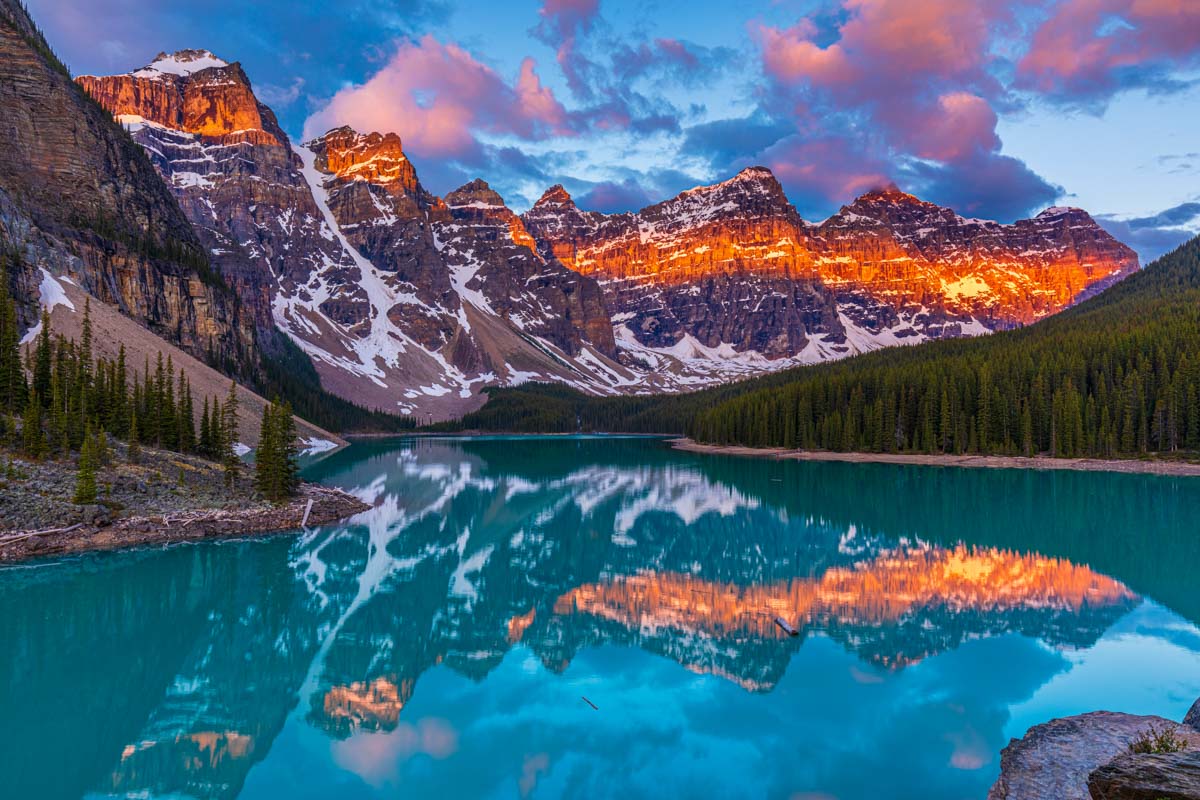
And that’s how this Canadian Rockies itinerary was born.
This itinerary is arguably the most spectacular Canada road trip, and it’s definitely one of the most naturally striking and totally out-of-this-world-beautiful trips you can take in the entire world.
But don’t take my word for it! Read on to learn all of my first-hand tips for planning the ultimate Canadian Rockies road trip.
For your information, this is a SUPER comprehensive guide (read: long and detailed sections to come)! I just wanted to make sure all of our best tips, guides, and resources for the Canadian Rockies were all in one place for you to access easily.
Soooo, grab a glass of your favorite adult beverage, cozy on up, and let’s chat by the crackling fireside about how to plan a kickass Canadian Rockies itinerary!
Travel Tips for Planning Your Canadian Rockies Road Trip
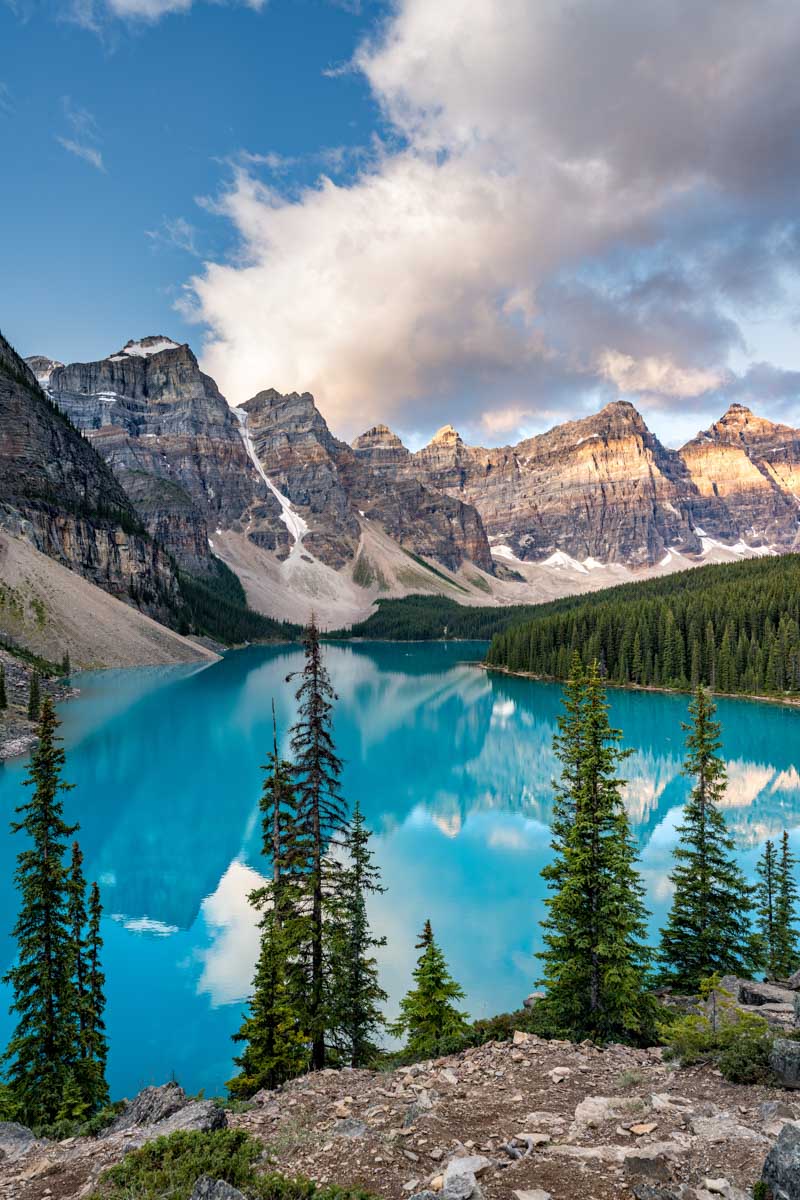
One thing that’s really important to keep in mind is that the Canadian Rockies is becoming a more popular travel destination every. single. year.
That’s why it’s crucial to plan your trip in advance.
If you’re planning on visiting the Canadian Rockies in the highest season (June through August), I’d recommend planning your trip and making all of your bookings AT LEAST 2-3 months in advance.
If you’re going in the shoulder season (May through early June or September through October), you can plan 1-2 months in advance.
From my own personal experience, here’s everything you need to know as you plan your Canadian Rockies road trip:
Important Tips to Know Before Traveling in the Canadian Rockies
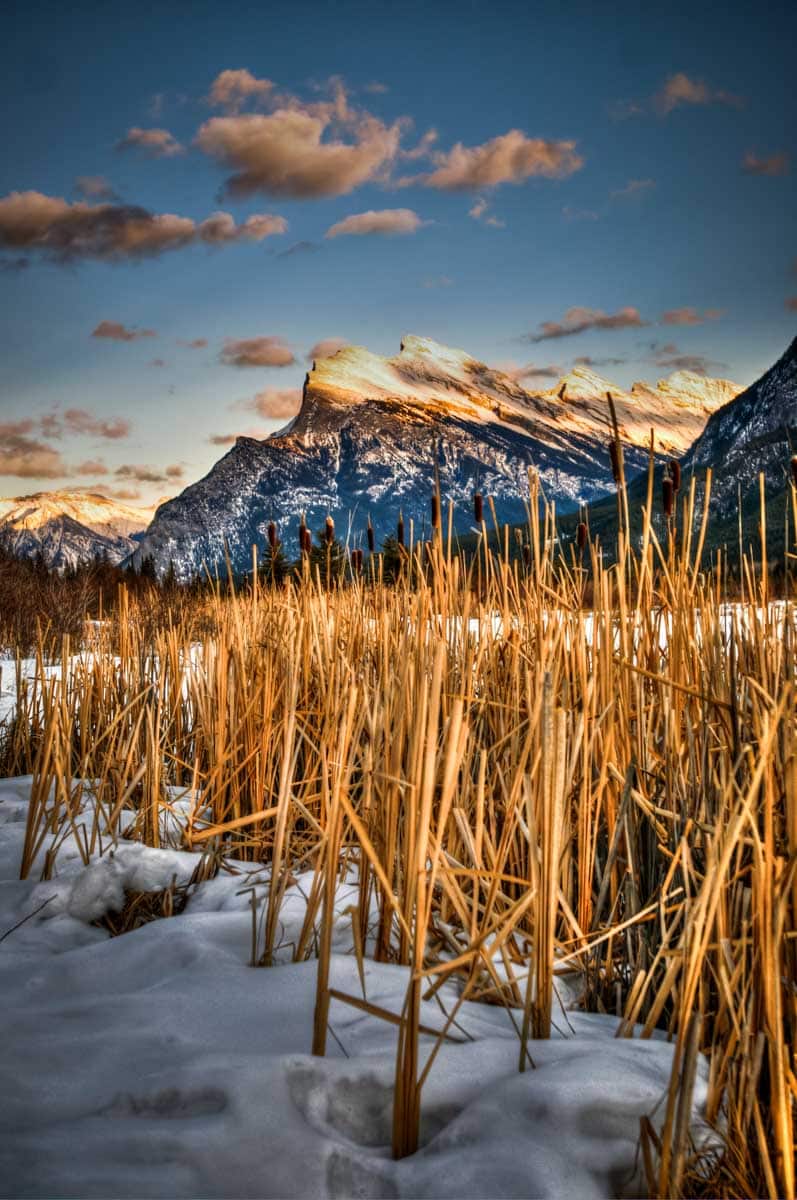
Weather conditions can be very unpredictable. One minute it’s blue skies and sunny and the next, it’s sleeting. This is normal life in the Canadian Rockies, and it’s something you’ll have to get used to if you’re traveling in from a more temperate climate.
Be sure to bring gear for both cold and warm weather (we’ve provided our favorite recommendations a little later in this post), and have waterproof shells for when the weather turns sour.
Accommodation books up very, very quickly. When I was planning my most recent trip to the Canadian Rockies, I noticed Banff and Jasper were already booked at over 80% capacity…2 months before my arrival.
As soon as you think you want to go to the Rockies, you should book cancellable accommodation (Booking.com is great for that!) to make sure you can secure something .
There’s wildlife everywhere. Talk to any local in the area and they’ll tell you wildlife is commonplace here. It’s not out of the ordinary to see a bear or an elk grazing on the side of the road.
You can absolutely admire these animals from a distance (and even go on a special tour to see them!). But whatever you do, KEEP A SAFE DISTANCE and DO NOT FEED ANY ANIMALS. This is their home and we need to respect and protect them.
You need to buy a ticket to enter the parks. While Canmore isn’t part of this, in order to enter Banff, Jasper, or Yoho, you need to pay the entrance fee. The fees are per person, per day, so depending on the size of your group, you’ll either want to pay individually or splurge for a family/group pass. You can see all prices and conditions on the Parks Canada page.
If you want to avoid the crowds, wake up early. This itinerary will be taking you to many different locations, some more popular than others. However, if you’re not a morning person, you miiiiight want to become one during this trip, as the early morning is a) the best time to avoid the crowds and b) the best time for photos of the park because of the lighting.
When to Visit the Canadian Rockies
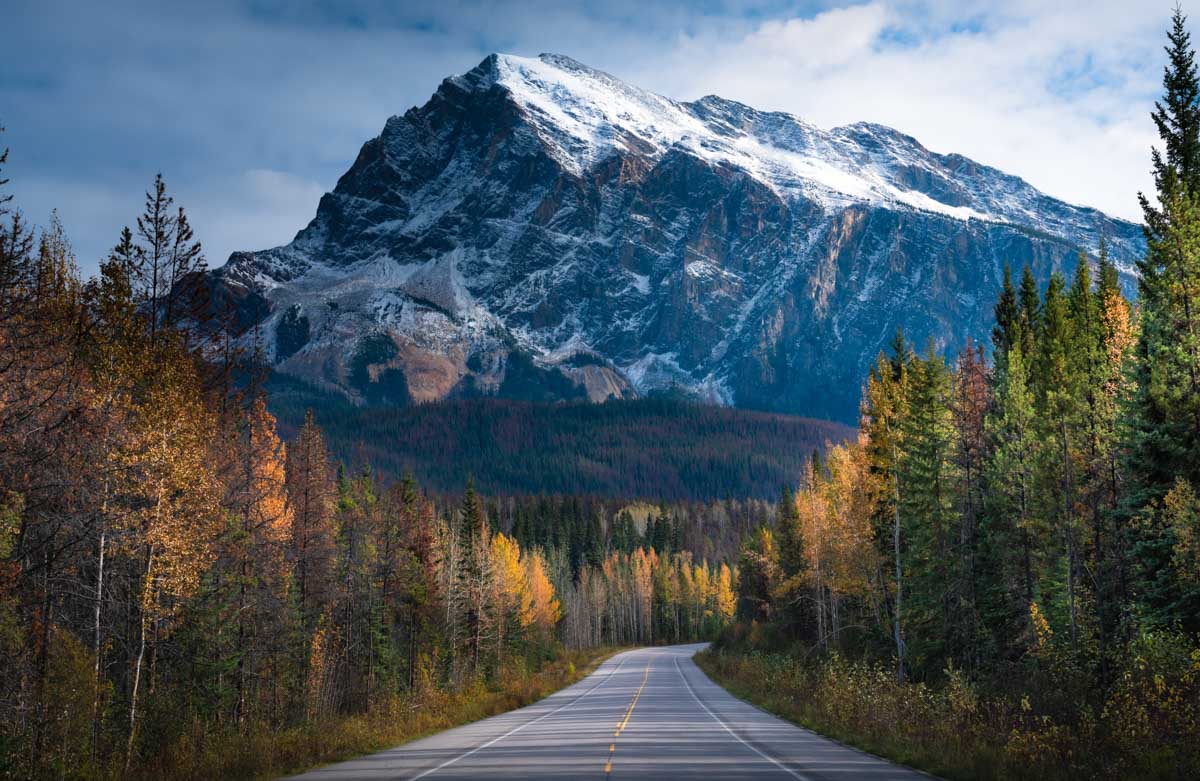
The Canadian Rockies are a year-round travel destination. This means that, yes, you can visit during any month of the year, but what you can do drastically depends on the weather. You’ll need to have the right expectations about weather and available activities.
Visiting in Summer or Fall
Summer and fall usually boast the best hiking and camping weather, but also attract the largest crowds.
Typically, all of the hiking trails and summer adventure activities are open and available during this time of year, meaning that the hotels and lodges are often almost completely sold out and there’s actually traffic.
If you’re planning on visiting the Canadian Rockies during the summer, you’ll need to plan a few months in advance to secure accommodations, car rentals, and tours.
Visiting in the Spring
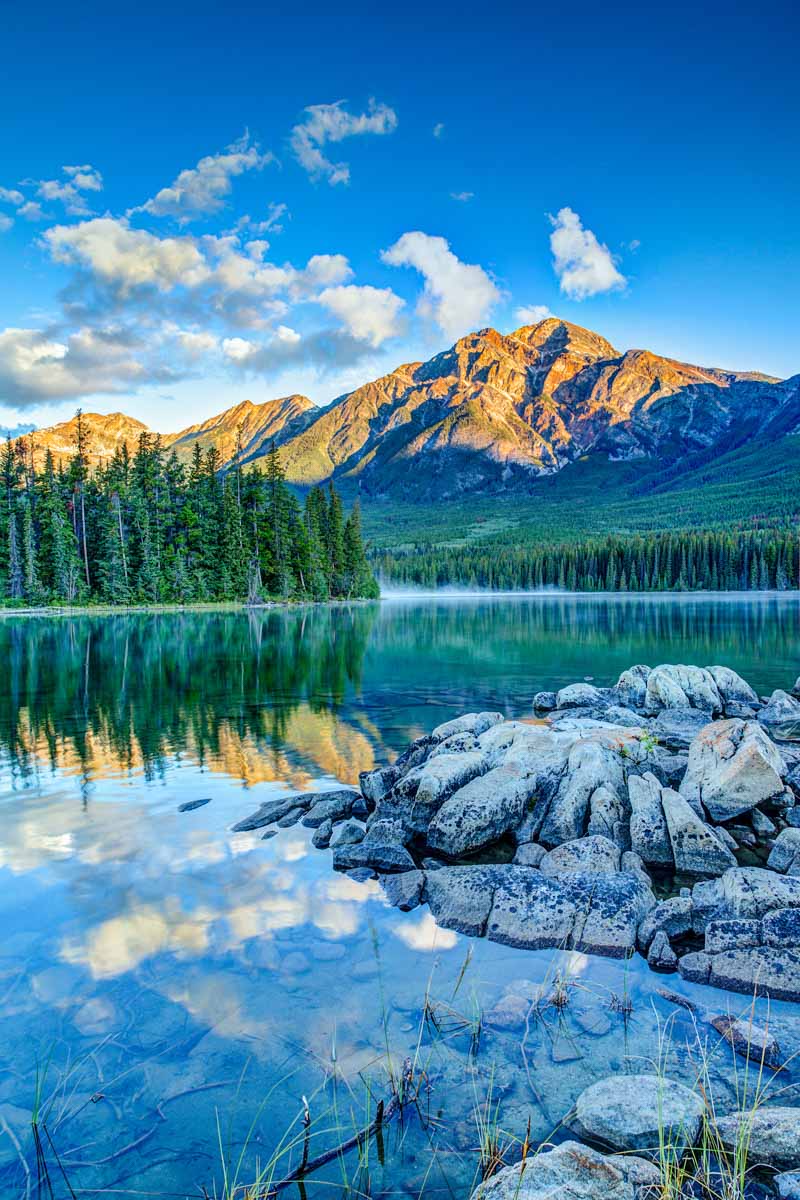
Spring is the shoulder season, especially after the ski slopes begin to melt but the trails are still covered in winter ice. Weather during this time of year can mimic winter or summer, depending on when in the season you visit.
The first time I ever visited the Canadian Rockies, we went in mid-May and, while not all of the hiking trails were open yet, we experienced very few crowds and even had Lake Louise completely to ourselves.
Not a bad trade-off if you’d prefer a more tranquil, quiet experience!
FYI, this Canadian Rockies itinerary is based on a spring, summer, or fall road trip.
Visiting in the Winter
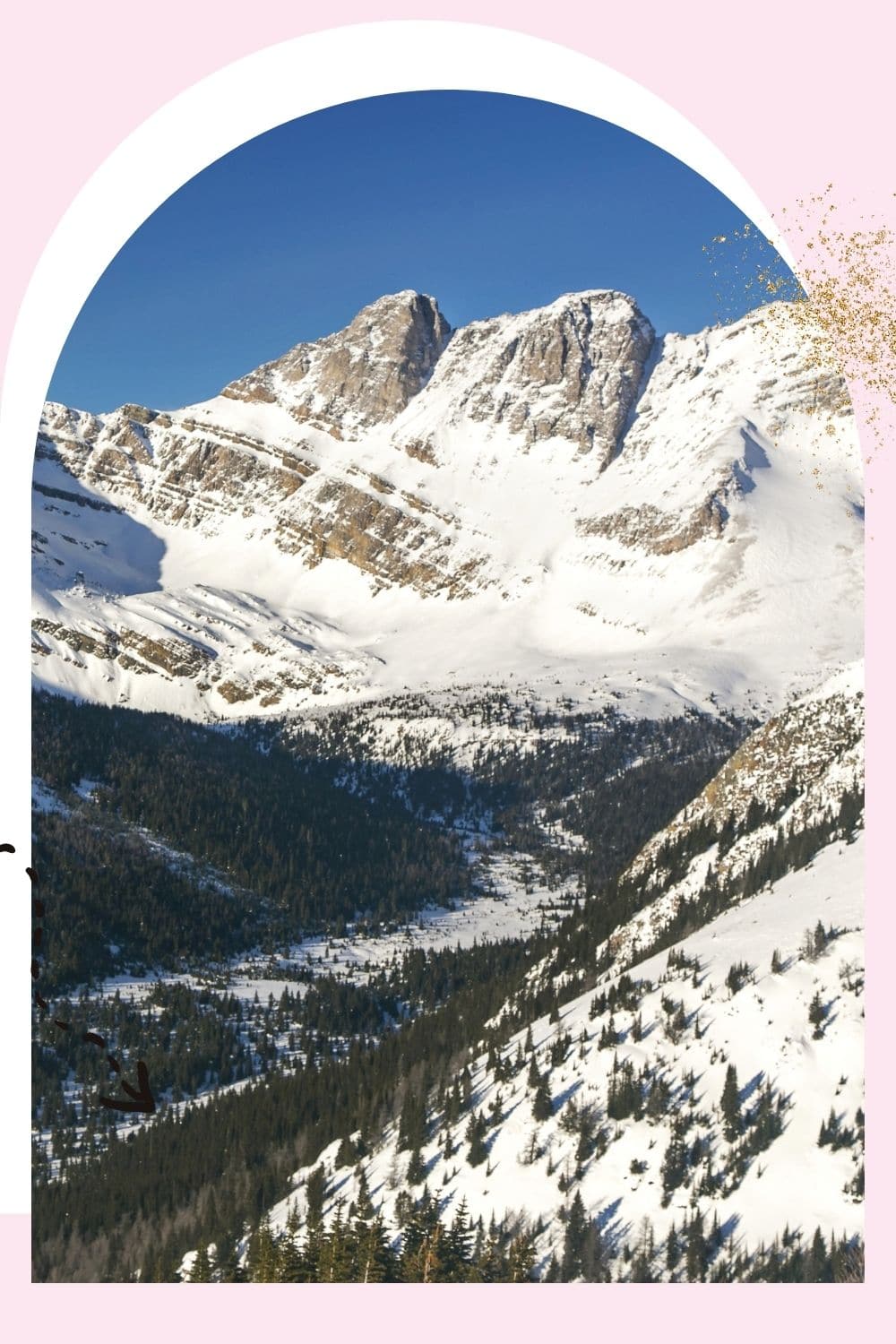
However, that’s not to say you can’t make a Canadian Rockies road trip in the winter. Winter is the least-crowded season in the area, but your activities will be limited to snow sports (e.g., skiing, snowboarding, tubing, etc.) and ice activities (like ice climbing and ice trekking, which are pretty cool, IMO).
If you’re planning on doing any of these outdoor winter sports, I recommend grabbing yourself a pair of crampons, a durable, insulated jacket , and thermal snow pants, as you’ll DEFINITELY need them. Also, make sure that you have all of the most important gear for hiking in winter .
If you’re going to take a road trip during the winter season, I’d strongly recommend having experience driving in snowy/icy conditions, and please make sure to have the right gear, like snow chains, ice scrapers, etc.
How to Get to & Around the Canadian Rockies
If you haven’t already guessed by the fact that this is a “road trip” itinerary, I strongly recommend driving yourself or renting a car to get to and around the Canadian Rockies. Why? Because having your own car gives you the most flexibility for where you can go in the park and what time.
How to Rent a Car in Calgary
Luckily, it’s pretty easy to rent a car at an affordable price from the nearby cities of Calgary, Edmonton, and even Vancouver. You can even rent a car in Banff town. If you’re not from the area, I strongly recommend flying into Calgary International Airport (YYC), as it’s the closest airport to this itinerary’s starting point.
You can rent a car from Avis, Hertz, and Enterprise directly from the airport. However, if you want to save some moolah, I’d recommend checking the prices at Calgary’s downtown car rental locations as well. I’ve found rental cars downtown tend to be cheaper, costing sometimes 20-40% less per day than renting at the airport. Plus, the taxi downtown from the airport only costs ~$15 USD one way.
Getting Around the Canadian Rockies
Once you’ve got a car, there are gas stations all over the Trans-Canada Highway and the Icefields Parkway (the two primary roadways you’ll be using in this itinerary). Before heading anywhere, I strongly recommend checking the Parks Canada road reports, so you know if there are any road closures or bad weather conditions ahead of time.
Where to Stay in the Canadian Rockies
There are places to stay in the Canadian Rockies for any budget level, from penny-pinching backpackers to luxury lovers.
To make planning your accommodations suuuper easy, for each day of this Canadian Rockies itinerary, I’ll be providing two recommendations for places to stay, one budget option and one mid-range option.
I’ll also suggest the most convenient campsite for each day of the itinerary.
However, if you’d like more suggestions or information on where to stay in the Canadian Rockies, we’ve got you covered with 2 complete accommodation guides (Banff and Jasper):
- Where to Stay in & around Banff National Park
- Where to Stay in Jasper National Park
And, for those of you interested in camping in the Canadian Rockies, we’ve got 3 complete and detailed guides on that as well:
The Ultimate Guide to Camping in Banff National Park
- The Ultimate Guide to Camping in Jasper National Park
- What to Pack for a Camping Trip: The Ultimate Camping Packing List
What to Pack for the Canadian Rockies
Clothing to pack for the canadian rockies.
- Waterproof hiking boots – While on a Canadian Rockies road trip, there’s a good chance you’ll be caught walking in mud, snow, and stream crossings. To keep my feet warm and dry during day hikes, I have a cozy pair of Ahnu waterproof hiking boots that always do the trick! My boots have been with me to Patagonia, Peru, Slovenia, and more, and they’re still kicking ( haha, get it?! ).
- Wool socks – You’ll want to bring some warm wool socks to pair with your hiking boots. Not only will these help keep your feet cozy and dry, but they can also help prevent blisters from your boots. We love our Darn Tough hiking socks for all of our outdoor adventures and literally bring them everywhere with us.
- Merino wool layers – It’s a really good idea to bring a merino wool baselayer , which will keep you cool in the summer and warm in colder weather. Merino is soft, sturdy, stink-free, and sweat-wicking, AKA the best fabric ever for staying warm and dry in the Canadian Rockies’ unpredictable climate.
- A waterproof rain shell – No matter what time of year it is, there’s a decent chance of a sudden downpour in the Canadian Rockies. Yes, it literally happens even when the skies are clear and blue minutes before. Bring a sturdy, waterproof rain jacket to stay warm and dry at all times.
- A compressible down jacket – Temperatures in the Canadian Rockies can be chilly even in the summer, especially as you gain altitude. For this reason, I always make sure to pack my thermal puffer, all rolled up into a tiny ball that I can shove into my day pack or clip onto the outside of my bag with a carabiner.
Toiletries & Personal Items
- Mosquito repellent, sunscreen, and sunglasses – Don’t forget these! Just like most other outdoor areas, the Canadian Rockies get lots of sunshine and mosquitoes in the summer, so plan ahead.
- Snacks – Whether you’re hiking, rafting, or driving, you’ll definitely want some snacks to carry with you. I strongly recommend purchasing packaged or resealable snacks as the food scents can be an issue with wildlife in the area.
- Good road trip playlists – You’ll be driving a LOT in the Canadian Rockies, so having a good car playlist downloaded to your phone is a must!
Other Helpful Things to Pack for the Canadian Rockies
- Bear spray – Like I mentioned before, there is a LOT of wildlife in the Canadian Rockies. Be sure to purchase a canister of bear spray if you plan on doing lots of hiking or camping. You most likely won’t have to use it (I never did in 6 months!), but it’s smart to have on you in the event of a chance run-in with a bear or a wolf.
- Head lamp – If you want to catch a stunning sunrise, a colorful sunset, or some epic stargazing, a good, comfortable head lamp is a MUST. Luckily, they’re not too expensive and once you buy one, you can just replace the batteries forever and ever (until the bulbs physically burn out). I like my Black Diamond head lamp for exploring in less-than-optimal lighting.
- Reusable water bottle & filter – We always bring our trusty reusable water bottle (Rafael and I both have Hydro Flask bottles that we LOVE) on our adventures to cut down on plastic waste and keep our water cold. Most of the time you should have plenty of access to clean, filtered tap water, but on long hikes you may need to refill at a stream or cascade. In this case, you’ll also want a water filter or purification system to ensure your water is always potable. We recommend the rechargeable SteriPen, which purifies your water using a portable UV light.
- Carabiners – These are always super useful to have while hiking or exploring. I use them to hang my water bottles, hats, shoes, wet clothes, etc. on the outside of my bag, and they work fantastically. You can literally just buy a pack of 20 carabiners and throw them in your hiking bag when you’re ready for an adventure.
Gear for Camping & Sleeping
- Durable camping gear – If you’re planning on camping, you’ll definitely want some high-quality camping gear to bring with you.
- Hammock – While definitely not a requirement, it’s really nice to have a hammock for relaxing after a long hike or at a riverside campsite. We have an ENO Double Nest (of course, in the brightest, most psychedelic colors they sell) and we basically live it in when we’re not in the car or the tent. It’s perfect for sharing between two people or snuggling up by yourself.
The Ultimate 10-Day Canadian Rockies Itinerary
Day 1: calgary to canmore.
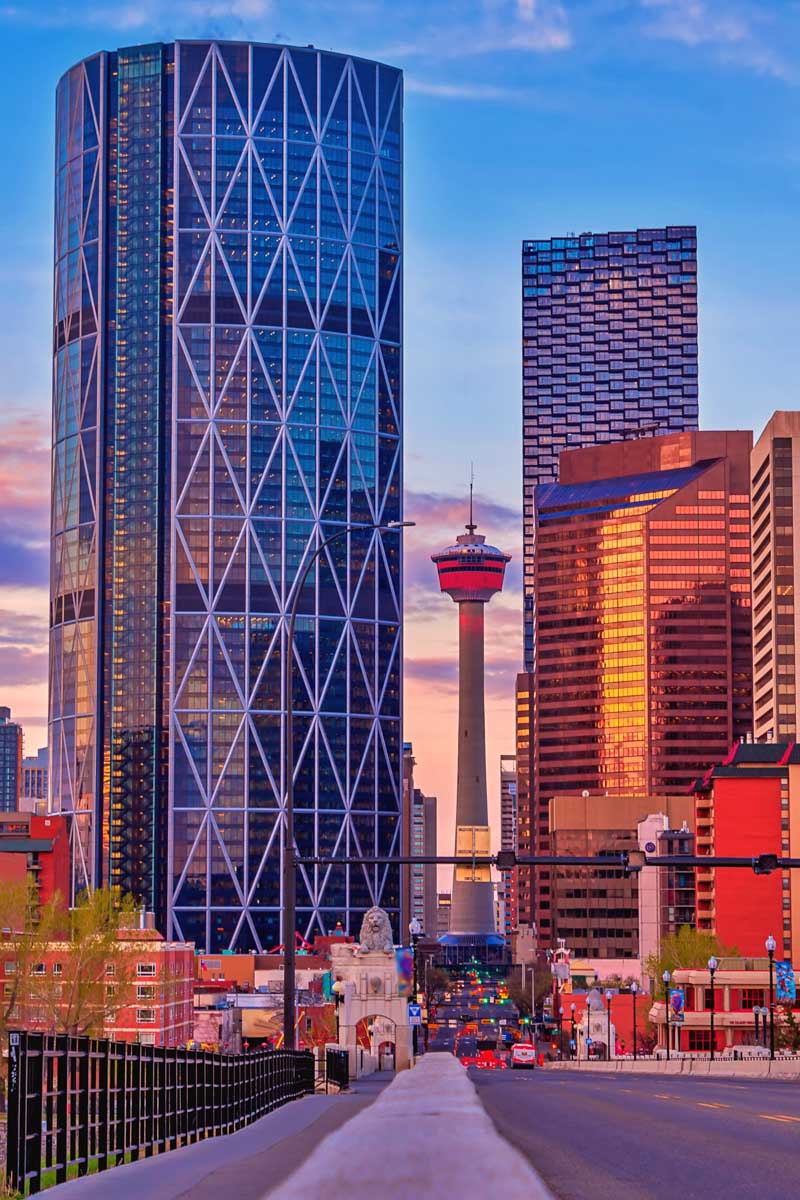
On this day, we recommend arriving in Calgary and driving to Canmore, which is the first stop of our Canadian Rockies itinerary.
You do have the option of staying in the for a day and doing some hikes (which could be a really cool option, especially if the Calgary Stampede is going on).
While many people opt to go directly from Calgary to Banff, I chose to include Canmore because it’s often overlooked by tourists, but it actually is home to some of my favorite hikes and viewpoints in all of the Canadian Rockies.
While often overshadowed by their northern neighbors (Banff and Jasper), Canmore and the Kananaskis area are, in my opinion, some of the most underrated adventure destinations in all of Alberta.
Striking mountaintops, amazing hiking trails, and beautiful alpine lakes will greet you as you explore Canmore, but you can expect smaller crowds here, even during the high season.
Morning: Arrival in Calgary
If you opt for a direct morning flight from anywhere in the USA or Canada, chances are you’ll most likely be arriving in Calgary Airport in the late morning or early afternoon. Once you’ve arrived, proceed through customs (if necessary) and grab your bags.
- For car rentals at the airport: From the arrivals area, follow signs to the main rental car area to pick up your car from your designated agency.
- For car rentals from downtown: Exit after baggage claim and grab a taxi (NOT a black car, these are 2-3x the price!). Make sure you have the address of your rental agency on hand and let the driver know where you’re going. If you’ve decided to rent from Avis (which we usually recommend), their shop is right next to the Calgary Tower.
Lunch in Calgary
After you leave the airport, I recommend grabbing some lunch in nearby Calgary before heading to Canmore.
Known for its ranching industry, Calgary is known around Canada for its meats. For some of the most delicious steaks in the city, Vintage Chophouse is a fantastic place to try. Since I’m not actually a steak person myself, my favorite dish there is the lobster mac and cheese , which is exactly the heavenly deliciousness it sounds like: large lobster chunks mixed in with a perfect blend of pasta and melted cheeses.
For a cheaper, vegetarian-friendly lunch option, The Coup is a fantastic choice. Their bright, open space and delicious, healthy lunch options are AMAZING. Share a Vegan Char”coup”terie board or order the Satay Bowl for lunch… you won’t be disappointed.
After lunch, if you have extra time to check out the city, explore some of the many things to do in Calgary !
Afternoon: Driving In & Exploring Canmore
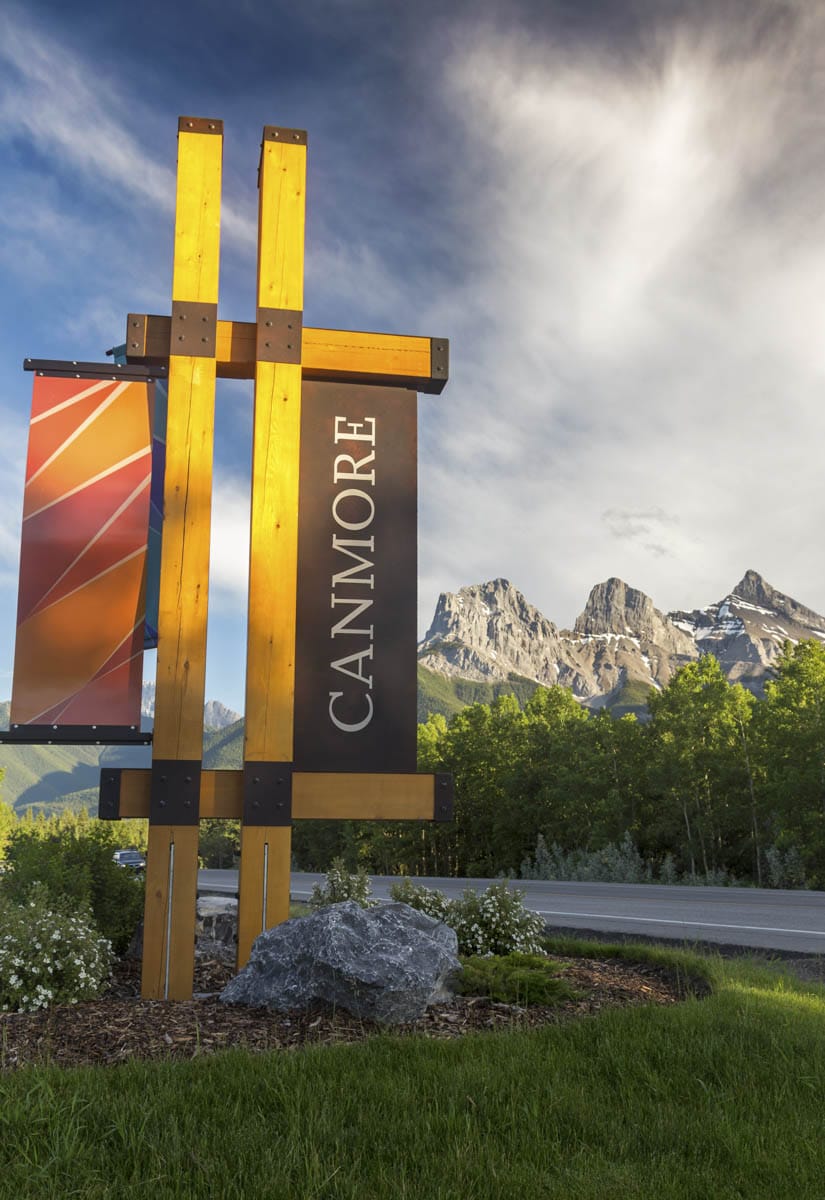
After lunch, you’ll drive ~1 hour down the Trans-Canada Highway (Highway 1) to Canmore. At first, you might think you’re in the wrong place, with flat farmlands for miles.
The plains eventually turn into rolling hills, and then…BAM… you’ll see it: the beautiful, majestic Canadian Rockies. At first just a faint outline on the horizon, they’ll eventually grow larger and bluer right before your eyes.
It’s, like, ridiculously magical.
For outdoor lovers, seeing the Canadian Rockies for the first time is kind of like the feeling you get when you see the Disney Castle. It’s magical, heart-wrenching, glorious. You might cry (I definitely did). Seeing the mountains and knowing that you’ll be spending the next 10 days there? Priceless.
Depending on how much time you have in Canmore before dinner, you can take a drive around the area and even hop on a short hiking trail (see the next section on Day 2 for some recommendations). You can also check into your accommodations (see below for our recommendations) and wander around the town center for a while.
Evening: Dinner at PD3 Blake Canmore
Full disclosure: I’ve never eaten at Blake Canmore . BUT I have a good excuse — the TWO times I tried to go, it was either full with a wait (and I was hangry from hiking) or it was closed. You can choose to dine at Blake Canmore’s more traditional dining hall, but I’d recommend going for the more casual PD3, which is a double decker bus converted into a local dining institution (and the food smelled absolutely heavenly ).
Whatever you choose, don’t be like me: plan ahead and eat your first Canadian Rockies dinner at Blake.
Not only does the food look super drool-worthy (I think I could literally inhale their “crack fries” in approximately 2 seconds), but it’s also reasonably priced and the atmosphere is among the most unique in the region. They also have homemade ice cream flavors and signature drinks/cocktails in case you want to end your day 1 with a sweet treat!
Overnight in Canmore
You’ll spend (at least) the first two nights in Canmore, where hotels and hostels tend to be significantly cheaper than staying in nearby Banff. Here are some of our top recommendations for places to stay in the Canmore area:
- Mid-Range Hotel: The Georgetown Inn – Imagine an old-time pub and inn that magically plopped down in the middle of Canmore and you’ve got The Georgetown Inn. This adorable home-style inn is the perfect landing place for you after long days of hiking, since they boast large, comfy rooms and there’s an attached restaurant.
- Budget Hostel: HI-Canmore – Currently Canmore’s only hostel, HI-Canmore is a fantastic place to stay for budget travelers, solo travelers, and backpackers. With dorms and private rooms, HI-Canmore caters to a wide variety of travel preferences and budgets, while offering typical amenities like laundry, kitchen, and cooking supplies.
- Campsite: Bow Valley Campground – Situated right next to the Bow River and the nearby hiking trails, the Bow Valley Campground is the perfect base in Canmore. The campsites are spacious, the rangers are attentive, there are all of the necessary amenities, and the views are totally epic.
Check Additional Accommodation in Canmore
Day 2: Hiking in Canmore
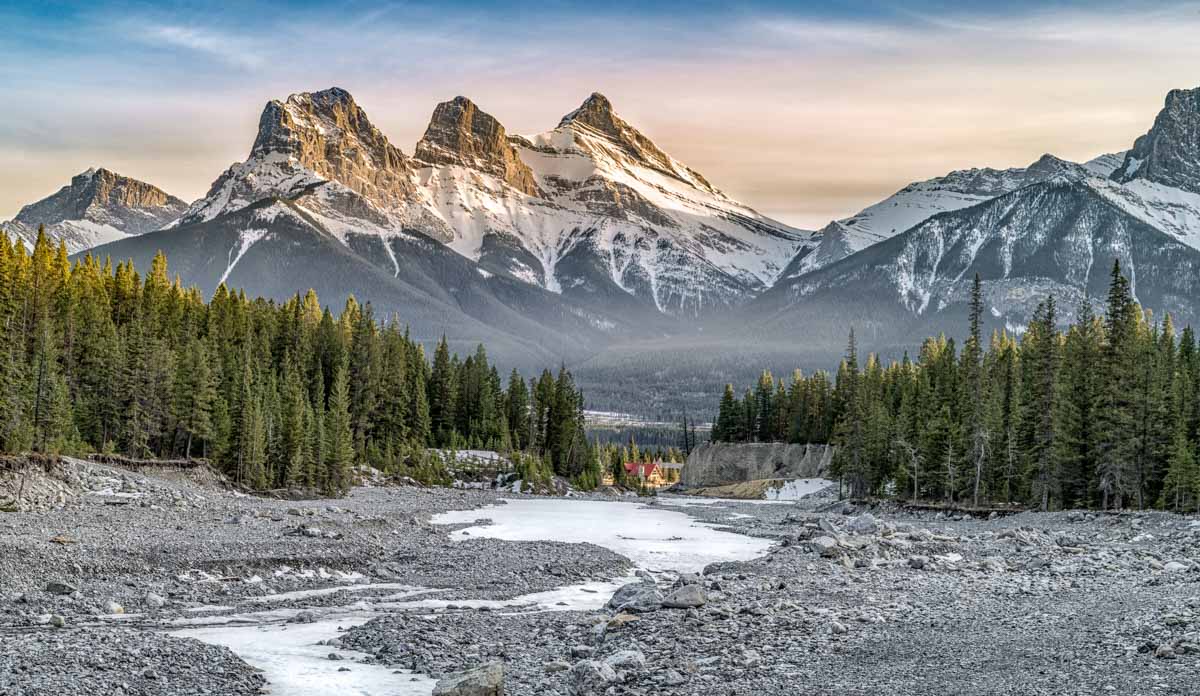
As I say whenever anyone asks me, hiking is the best way to experience the Canadian Rockies , even if you’ve never hiked before or get serious anxiety when you think about climbing uphill (*raises hand and blushes*).
Whether you’ve been hiking since your childhood years or are hitting the trails for the first time ever, there are tons of picturesque hikes in Canmore (and ALL of the Canadian Rockies) suitable for your skill level and preferences.
On day 2 of your Canadian Rockies itinerary, you have a few options: choose 1-2 short hikes in Canmore, or embark on a longer half- or full-day hiking excursion in the area. I’ve listed several hikes, ranging from easy to challenging, in each of the categories below so you have LOTS of options to choose from!
Pro tip: Get started with hiking EARLY. While it will definitely be a little colder outside in the mornings, the most beautiful views of the Rockies happen when the sun is low in the sky, and you definitely won’t want to miss those ideal morning mountain photo opportunities.
Short Hikes in Canmore
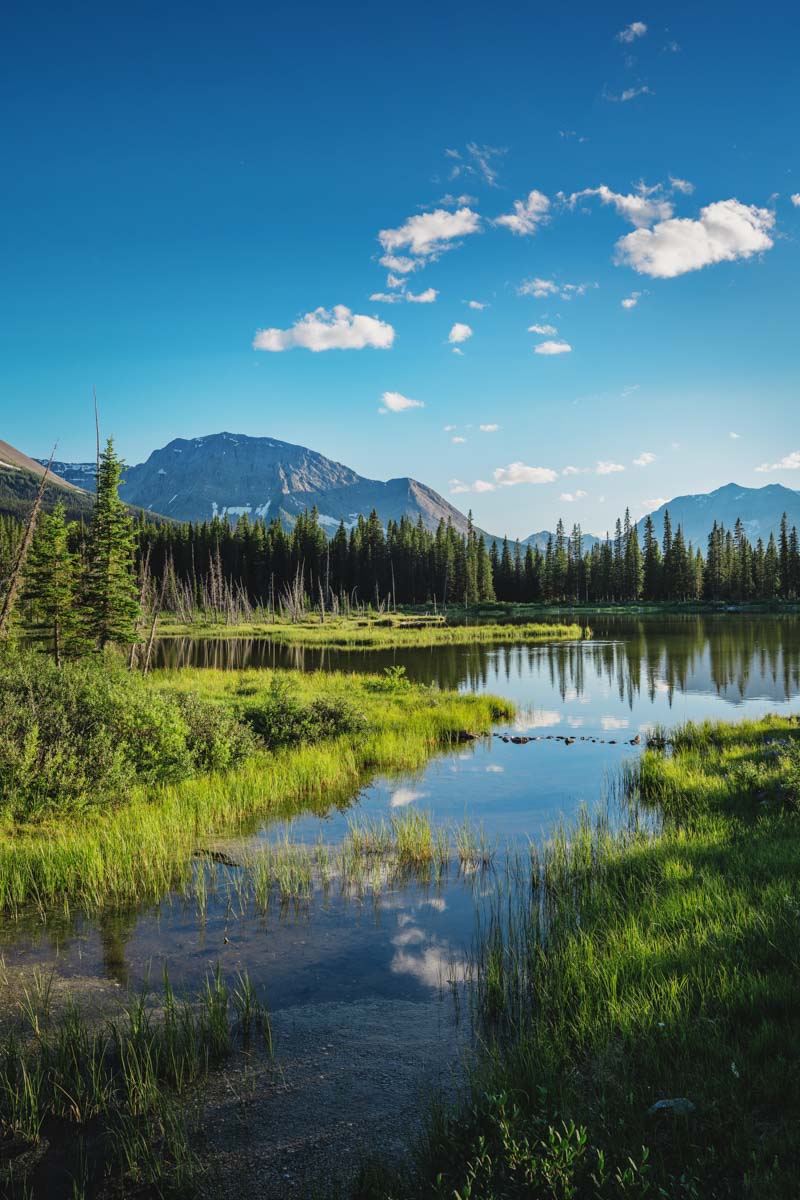
Bow River Loop – (3.5 kilometers, 1-1.5 hours) This is a nice little trail that starts in Canmore town center and loops around to the Bow River. If you’ve arrived in Canmore early enough on Day 1 for a short hike, this is a perfect one to try. Stunning views of the river, evergreen forests, and the surrounding mountains will greet you.
Grotto Canyon – (4.4 kilometers, 1.5-3 hours) One of the most unique hikes in Canmore, the Grotto Canyon trail takes you through huge rock structures where local climbers can often be found scaling the vertical rock faces. The trail is surrounded by large rocks and ends at a waterfall.
Grassi Lakes – (4 kilometers, 1-2 hours) Grassi Lakes is one of Canmore’s iconic hikes and is a local favorite that’s perfect for hikers of all levels. The trail takes you to two deep turquoise alpine lakes surrounded by evergreen trees, and it’s a super tranquil place to go for a short morning hike.
Quarry Lake – (3 kilometers, < 1 hour) This family-friendly loop trail winds around the banks of Quarry Lake, offering beautiful views across the water toward the mountains. You can also swim in the lake if the weather is warm enough!
Half-Day Hikes in Canmore
Ha Ling Peak ( CLOSED UNTIL FURTHER NOTICE ) – (5.3 kilometers, ~4 hours) This is arguably one of the coolest and most picturesque summits in Canmore. But don’t let Ha Ling Peak’s short trail distance fool you: the hike is actually quite difficult, as you’ll ascend well over 800 meters in less than 3 kilometers. The peak itself rewards you with breathtaking panoramic views of the Bow Valley below.
Lady MacDonald Tea House – (9 kilometers, 4-6 hours) This hike, named after a tea house that was never actually built, is a gorgeous trail that has beautiful views start to finish. One of the more popular hikes in Canmore, this moderately difficult hike is a perfect half-day adventure for hikers looking for a bit of a challenge and the reward of stunning photogenic viewpoints.
Full-Day Hikes in Canmore

Mount Yamnuska – (11 kilometers, 6+ hours) By far, Mount Yamnuska is one of my favorite adrenaline-pumping, muscle-throbbing hikes in ALL of Canada! This 11-kilometer trail takes you through an evergreen forest, up a steep rocky scramble, around a chain cliffhanger (seriously), and up to the summit of this iconic Canmore peak. It’s a whopping 900+ meters of elevation gain, so be ready for some SERIOUS uphills and downhills if you choose to tackle this one.
Heart Mountain Horseshoe – (11 kilometers, 6+ hours) I haven’t actually hiked this one, but I’ve heard awesome things about it from friends back in Calgary. This is a moderate to difficult trail that involves a bit of rock scrambling towards the top. The views from the trail and the summit are said to be absolutely incredible.
When You Get Hungry: Breakfast or Lunch at Communitea
Depending on your schedule, you’ll be hungry eventually, and if you need a great stop for breakfast or lunch, I strongly recommend Communitea . It’s a little coffeeshop/cafe hybrid with delicious, healthy dishes and a cute, colorful atmosphere.
Head there for breakfast for a caffeine fix before a big hike, or pick up one of their hot drinks and a delicious, filling savory bowl for lunch after hitting the trails in the morning.
Evening: Dinner at Rocky Mountain Flatbread Co
A Western Canada chain, Rocky Mountain Flatbread Co is literally the perfect post-hiking meal. They’ve got a HUGE oven they use to bake their flatbreads, which come out nice and piping hot to your table. If you’re planning on going during the height of dinner time, I’d strongly recommend making a reservation.
When you check out the menu, you’ll see they have DOZENS of pizza and pasta options to choose from (I may be biased, but you should definitely try the sundried tomato pizza ). You can also grab a Canadian craft beer or a signature cocktail with your dinner.
You’ll spend the night in the same Canmore accommodation you chose on Day 1.
Day 3: Banff Town & Iconic Sights
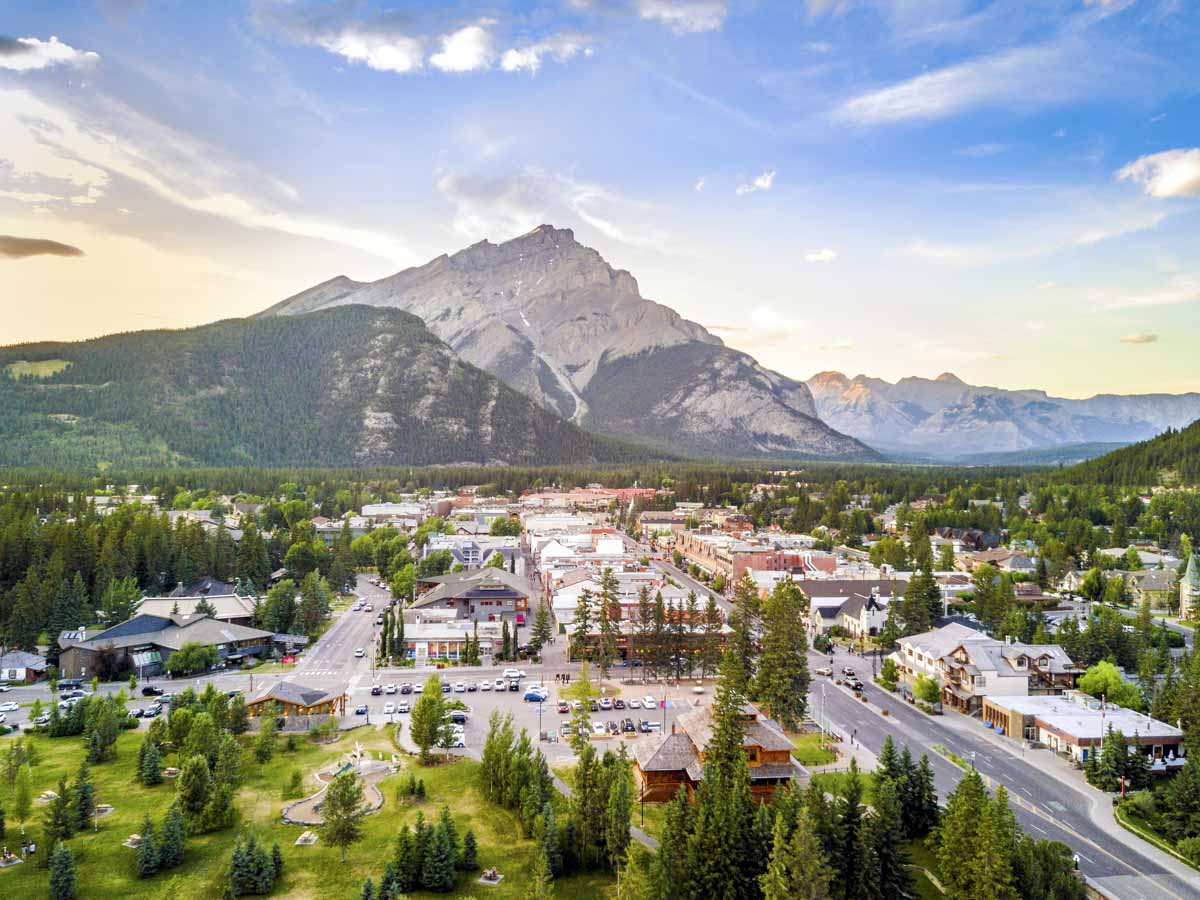
I know I gave you a day full of hiking yesterday, so today, you’ll be taking it a bit more easy on the legs. You’ll drive the short distance to Banff National Park, explore the Banff Town area, eat a delightful dinner at one of my favorite restaurants in Banff, and end the night with some stargazing if it’s clear outside!
Morning: Drive to Banff & Breakfast at Tooloulou’s
Since you’ll be exploring the area near Banff Town today, you can choose what time you’ll want to head out. ( Banff is about a 30 minute drive from Canmore, so make sure you are in the car driving before you get struck with the iron fist of breakfast hanger. )
You’ll continue down the Trans-Canada Highway until you reach the Banff Entrance (which consists of small huts on each lane of the highway where you pay your entrance fee). Pay the fee, which is $9.80 CAD per adult, then continue driving alllll the way to Banff town.
Along the way, you’ll catch a glimpse of Canmore’s stunning Three Sisters and Banff’s Mount Rundle.
Once you arrive in Banff, head to Tooloulou’s , arguably the best traditional breakfast place in town. It’s a Louisiana-style Cajun restaurant with a Canadian flair. Here, you can get french toast, omelettes, and hashbrowns in HUGE (shareable) portions. It’s delicious, especially since I know you’ll be hungry by the time you arrive in Banff.
Late Morning/Afternoon: Explore Banff Town & Surrounding Areas
After you’ve wrapped up breakfast, you’ll hop back in the car and explore the Banff town area. You might be thinking, Kay, I didn’t come to the Canadian Rockies to spend time in a town. But actually, Banff town is pretty small and picturesque, and it’s the town’s immediate surroundings that you’ll be getting to know on this day.
Depending on your energy levels and the amount of time you have, there are several options you can try. Here are a few of the main highlights in and around Banff Town:
Banff Gondola – One of the most fun and picturesque non-hiking activities in Banff is a ride on the Banff Gondola. While the ride is only ~8 minutes each way, the Gondola takes you up to a complex with an incredible panoramic observation deck, a cafe and restaurant, and amazing views for days. ( Pro tip: Head up on the Gondola later in the day when the sun is low in the sky for extra special views!)
Surprise Corner – The Surprise Corner is Banff’s worst kept secret, an unofficial viewpoint that has never *officially* been recognized as a landmark. As a roadside viewpoint just outside the city, the Surprise Corner is actually a popular place to stop off and admire views of the Bow Valley and the Banff Springs Hotel sticking up out of the trees. There are also several trails leading from the parking area around and into the valley below.
Fairmont Banff Springs Hotel – You’ve probably seen photos of the Fairmont Banff Springs all over the internet. If you’re looking for luxury and history all in one place, the Banff Springs Hotel is a fantastic landing spot for you. Situated in the scenic Bow Valley, the hotel boasts several restaurants, a spa, and several amenities for actual guests. However, if you just want to take a look, head there for a leisurely lunch in one of their dining spots.
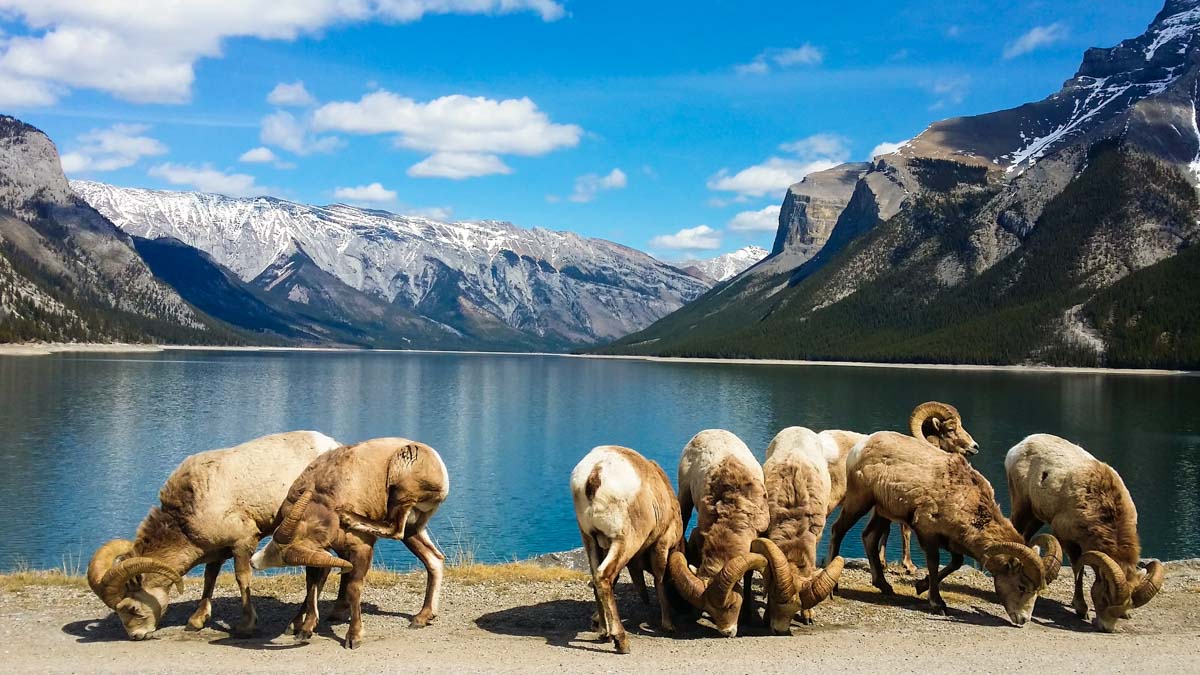
Lake Minnewanka – Lake Minnewanka is one of my favorite places in Banff, if not for the sheer fact that there is SO much to do there. You can rent a kayak or take a boat cruise, wander the lakeside trails or sit down for a picnic. In the night time, you can even stargaze here! I’d recommend heading over there and seeing where the day takes you…but beware: you might end up spending your ENTIRE day here!
Bow River Falls – This is a short, easy hike down to a wide waterfall on the Bow River. It’s a nice, scenic, paved trail that is family-friendly and will take you near Banff town down the river.
Banff town center – If the weather is bad or you’re just too dang tired to do anything, sticking around in Banff town center is NOT a bad option. There are scenic mountain views from the streets, as well as a handful of restaurants, shops, and museums that you can check out to learn more about Banff’s history, including the Whyte Museum of the Canadian Rockies.
If you have more than just 2 days to spend in Banff, here’s our complete guide to the park with a list of 23 amazing adventure activities to try:
Read our complete guide on the best activities & things to do in Banff
Evening: Dinner at Park Distillery & Stargazing
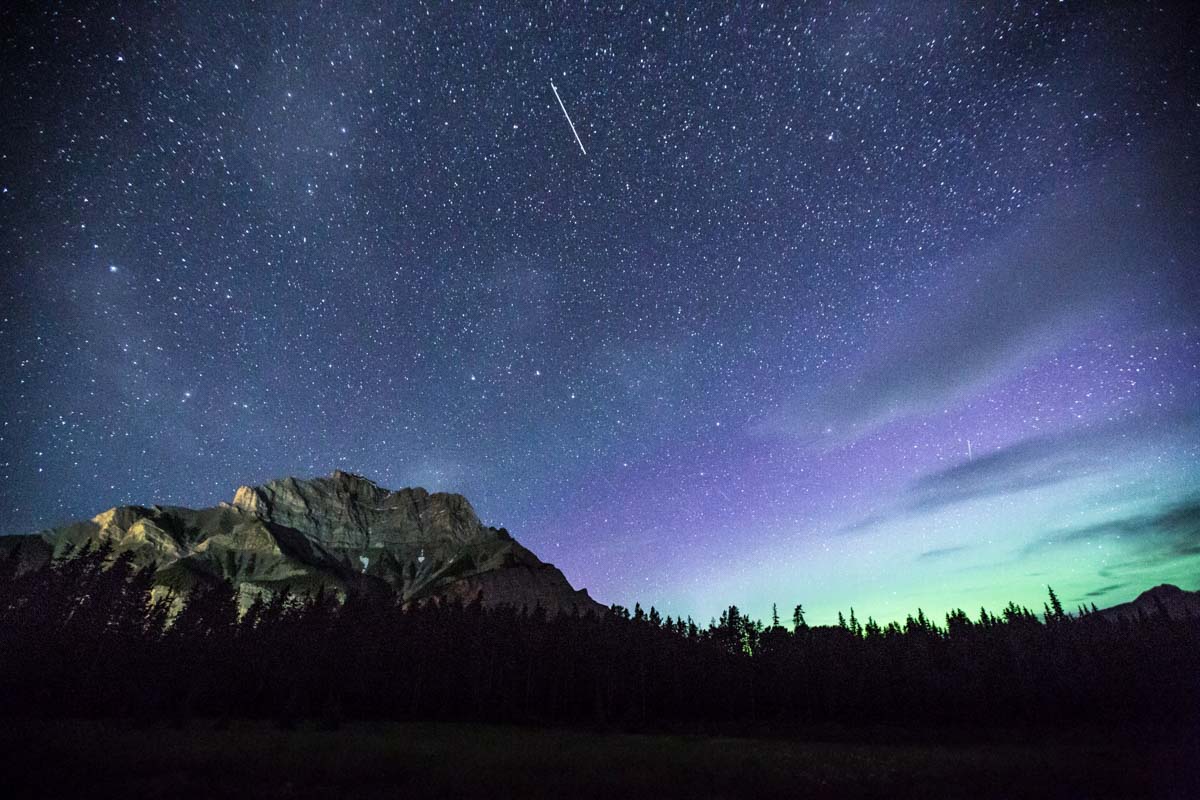
By the evening, you’ll probably be REALLY hungry and ready for a hearty, delicious meal in a relaxed place. I’ve got the perfect place to you: Park Distillery . Their mission is “campfire-inspired meals” and they really do play the part well, from char-grilled meats and steaks to the amazing smell of campfire inside and around the restaurant.
After your dinner, if you’re still a liiiiittle hungry, stop by Beaver Tails nearby for an amazing Canadian dessert: baked (fried?) dough topped with delicious sweet condiments like Nutella, M&Ms, cinnamon, and more.
If the sky is clear while you’re heading out from the restaurant, you can hop in the car and head to a nearby lake for some amazing stargazing opportunities. Outside of the town center, you can see a lot of stars and constellations in areas with little tree cover.
Here are a few beautiful spots in Banff I’d recommend for stargazing:
- Lake Minnewanka
- Vermilion Lakes
- Two Jack Lake
If it’s cloudy or rainy, just head back to your hotel/hostel and cozy up in your blankets. Tomorrow is a day of hiking so you can definitely use a good night’s sleep!
Overnight in Banff National Park
The blessing and the curse of Banff is that there are SO many places you can stay. And making a decision on where to stay in Banff can be a little overwhelming. So, here are my recommendations for a few popular places to stay (or you can read this post for the full list, from luxury lodges to budget hostels):
- Mid-Range Hotel: Moose Hotel & Suites – This is possibly the cutest lodge in Banff, with a big wood fireplace in the lobby and stunning views of the Rockies. If you’re looking for an affordable full-service hotel option in Banff, this one is arguably the best.
- Budget Hostel: Samesun Banff – A cozy hostel located in Banff’s downtown area, Samesun come highly recommend by budget travelers. People really love their laid-back atmosphere, low prices, and kitchen facilities (because, ya know, those restaurants can really add up!).
- Camping: Two Jack Lakeside – This is my #1 favorite campsite in the Canadian Rockies. Located right next to Two Jack Lake, the campsites offer stunning sunrise views of Mount Rundle, as well as amazing stargazing options. Campsites come with access to showers and running water, as well as fire pits (extra fee) and spacious areas to pitch your tent/hammock/whatever.
Click here to check reviews and prices for accommodations in Banff
Day 4: Hiking in Banff National Park
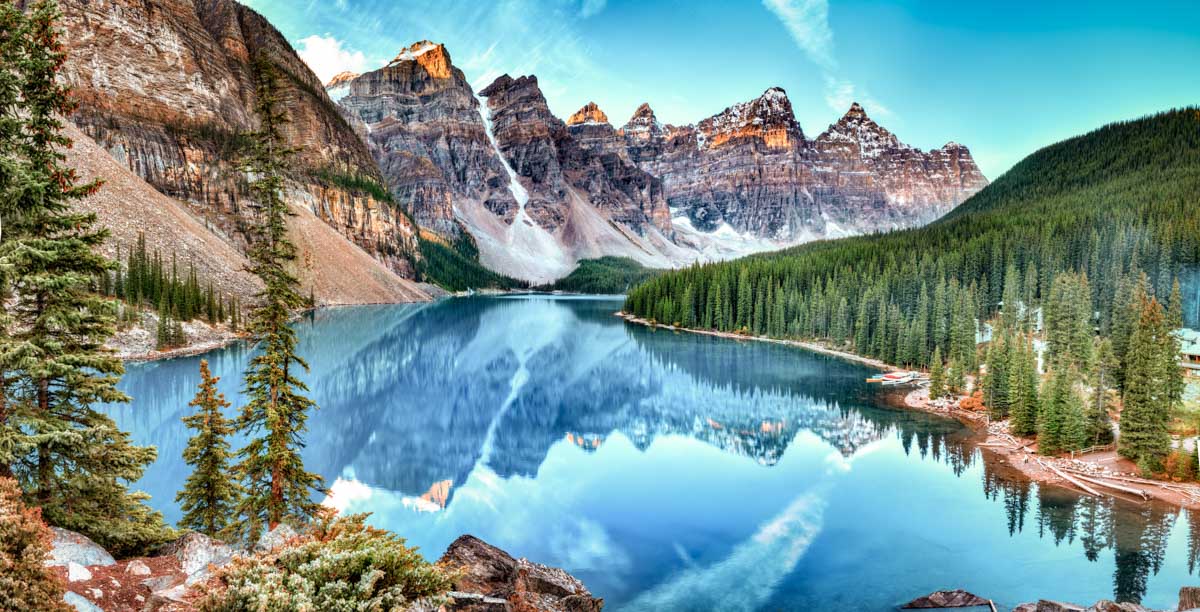
Yup, you guessed it: today is a full day dedicated to hiking! There are SO many fantastic trails in Banff, and it’s worth trying at least 1 or 2 of them before you leave. Before beginning any hike in Banff, it’s wise to check the Parks Canada website for updates on trail conditions and weather forecasts.
Morning & Afternoon: Go Hiking in Banff
Since we’ve got Moraine Lake, Lake Louise, and Johnston Canyon on the agenda for tomorrow, I’d recommend not choosing those for your hiking day today. Here are 3 other wonderful options for hikes in Banff that you can try on today’s itinerary:
Lake Minnewanka Loop Trail (Easy): An easy loop around one of the most beautiful lakes in the area, the Lake Minnewanka Loop is a fabulous day hike for beginner hikers or families. If you didn’t get over to Lake Minnewanka yesterday, I’d definitely recommend this option!
Cascade Amphitheatre (Moderate): Cutting through a valley with rocky mountaintop views, forested trails, and bubbling streams, this hike is a tranquil adventure into the woods. The Amphitheatre itself is a green valley surrounded by vertical rock faces and almost 360-degree views of the surrounding mountains.
Mount Rundle (Difficult): One of the most iconic mountains in Banff National Park, Mount Rundle is an amazing and challenging summit hike to the peak of this beast. If you’re planning to tackle this hike, be sure you’re fully prepared by reading this post and bringing all of the necessary day hiking items you’ll need.
For even more hiking recommendations, check out our complete guide to Banff’s most incredible hikes (for all levels of hikers!):
When you’re not hiking and need some food/refreshments, I recommend heading to Good Earth Coffeehouse in Banff’s town center. It’s a cute, cozy coffee shop that serves warm drinks and food all morning and afternoon.
Evening: Soak in the Upper Hot Springs & Grab Dinner at Banff Ave Brewing Co
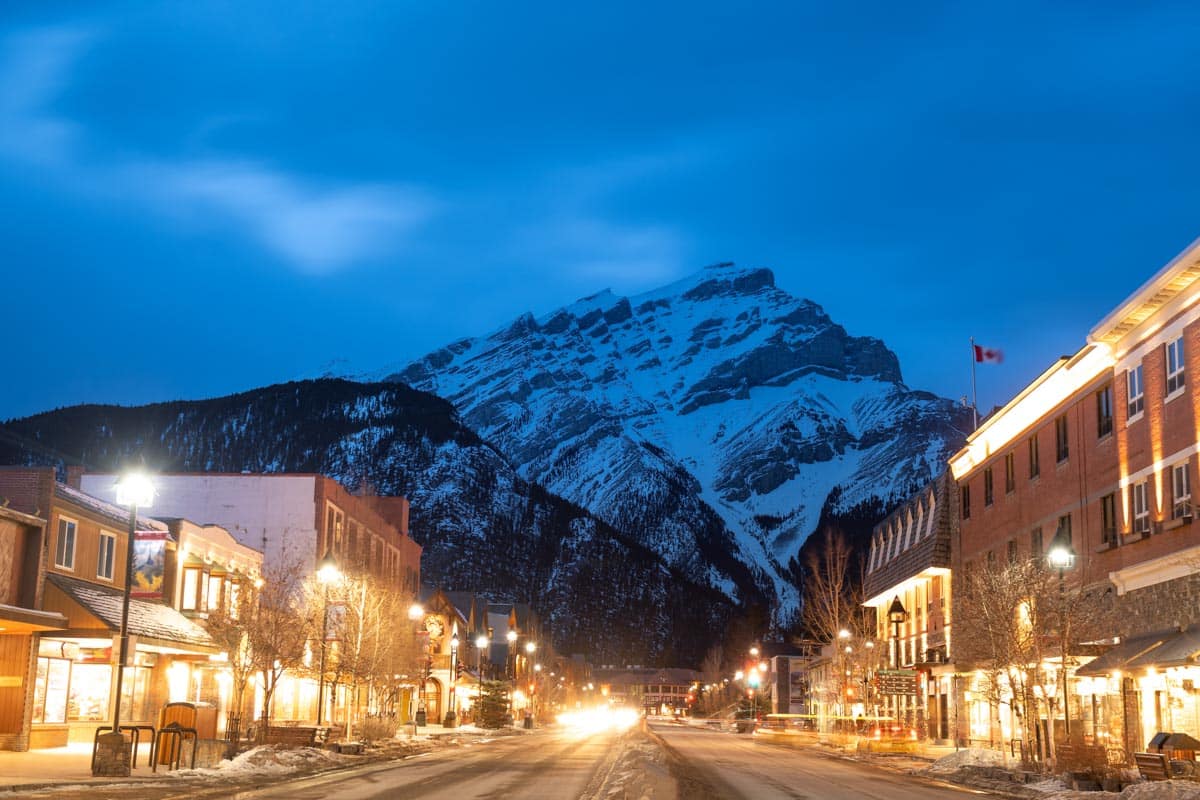
Once you’re done hiking for the day, head to the Banff Upper Hot Springs , which is just outside of Banff town. Here, you can kick back in the steaming hot pool and relax your muscles after a long day of hiking. The pool is clean and spacious, perfect for relaxing for an hour or two before heading off to dinner.
The Banff Upper Hot Springs costs $8.30 CAD for adults and you can rent a towel and/or swimsuit for $1.90 CAD each.
After your soak in the springs, grab some light eats and a beer at Banff’s craft brewery, Banff Ave Brewing Co . They serve up a delicious, affordable, vegetarian-friendly menu and a sizeable variety of beers, ranging from chocolatey darks (my style) to light, sour IPAs (Raf’s style). Get the crunchy fried broccoli and house nachos, or go for a heavier option like the Alberta Beef Burger or the Mushroom Gnocchi.
You’ll spend the night in the same Banff accommodation you chose on Day 3.
Day 5: Lake Louise, Moraine Lake, & Johnston Canyon
This is one of the most iconic days in the itinerary, where you’ll be headed to the famous Moraine Lake (yup, the one you see in all those Instagram photos of Banff), Lake Louise, and Johnston Canyon.
But here’s the catch: this day starts EARLY.
If you can be out of the house by 5:30 AM or before sunrise, that’s ideal.
This way, you’ll avoid the treacherous crowds at Moraine Lake and Lake Louise, and you can spend the afternoon strolling through Johnston Canyon (Or, like, napping in a tree from waking up so early. Both are acceptable.).
Early Morning: Moraine Lake

Set that alarm for 5 AM and grab a Clif bar to go for your breakfast as you leave your Banff hotel to drive ~40 minutes to the Lake Louise area.
You’ll see the iconic Lake Louise a bit later in the morning, but you’ll first want to drive up to nearby Moraine Lake to catch that epic sunrise view that EVERYONE AND THEIR MOTHER wants to see.
The parking lot for Moraine Lake is pretty small, which is why I’m recommending getting up so early. When Rafael and I went there for the first time, we arrived around 6 AM and, while we weren’t the only people there, we had the place largely to ourselves.
Park in the parking lot and go for a stroll around the lake, or up onto the famed Rock Pile to get that incredible view that everyone raves about (there’s a reason why this is one of the most Instagrammed places in Banff ).
Morning: Breakfast & Hiking at Lake Louise
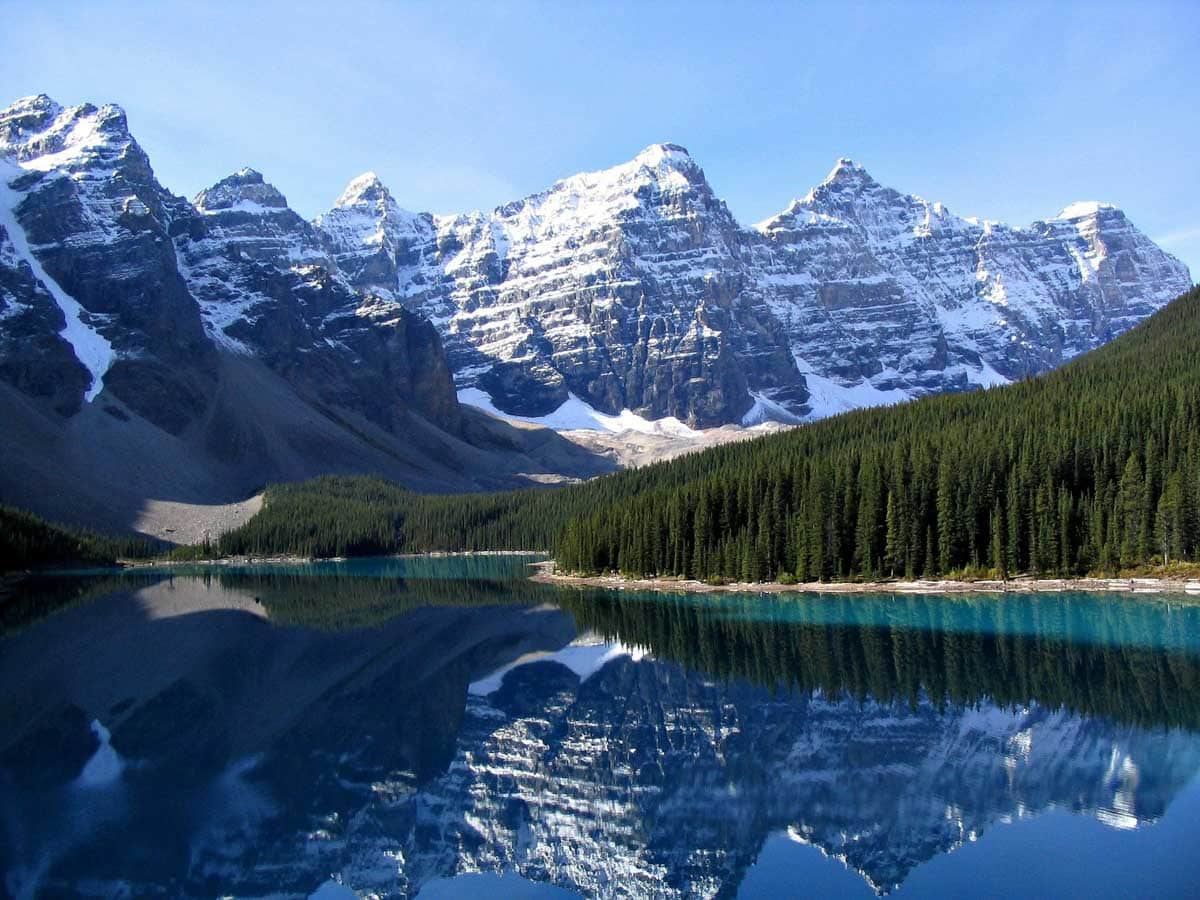
Once you’re finished at Moraine Lake, you can either head straight to Lake Louise or stop at Trailhead Cafe for a coffee and a bite to eat. Their “The Cure” sandwich is amazing to start (continue?) your day.
When you’re ready, head to Lake Louise and try to snag a parking spot as close to the entrance as possible. During the high season, the parking lot fills up and you have to park at a different one a few miles away and then shuttle in (which sucks, don’t do it).
If you get to Lake Louise early enough, you won’t have this problem. Instead, you can park right in front of the hotel and stroll right into the main lake area. Once you arrive at the lake, you’ll see the otherworldly turquoise water, the famous Fairmont Chateau Lake Louise, the amazing glacier, and striking mountains around you.
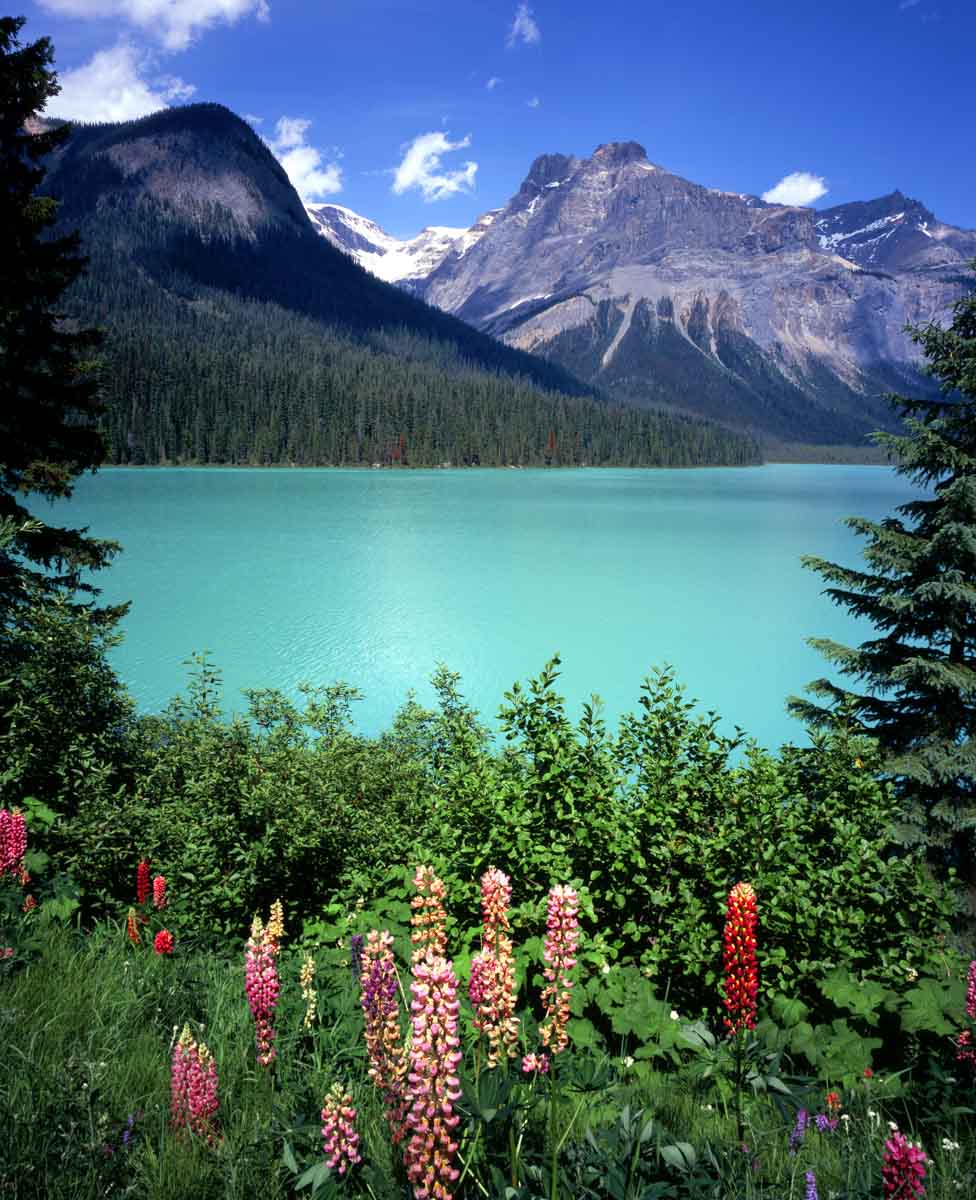
At Lake Louise, you have a few options. You can simply hang out around the hotel and the waterfront, or you can:
- Rent a kayak and explore the lake on the water
- Have brunch at Poppy Brasserie , the Fairmont’s breakfast restaurant which boasts table-side views of the lake and the surrounding mountains
- Do the Lake Agnes Tea House hike , which takes you up to a hidden alpine lake and a cozy tea house that serves warm drinks and snacks in the summer
- Embark on the Plain of Six Glaciers hike , which is a half-day hike that takes you to some pretty epic glaciers and landscapes around and above Lake Louise
If you’re planning on just stopping by Lake Louise, you won’t need more than an hour in the area. However, if you plan on doing any of the above activities, plan for 3-4 hours (5+ hours for the Plain of Six Glaciers hike).
Afternoon: Hiking at Johnston Canyon
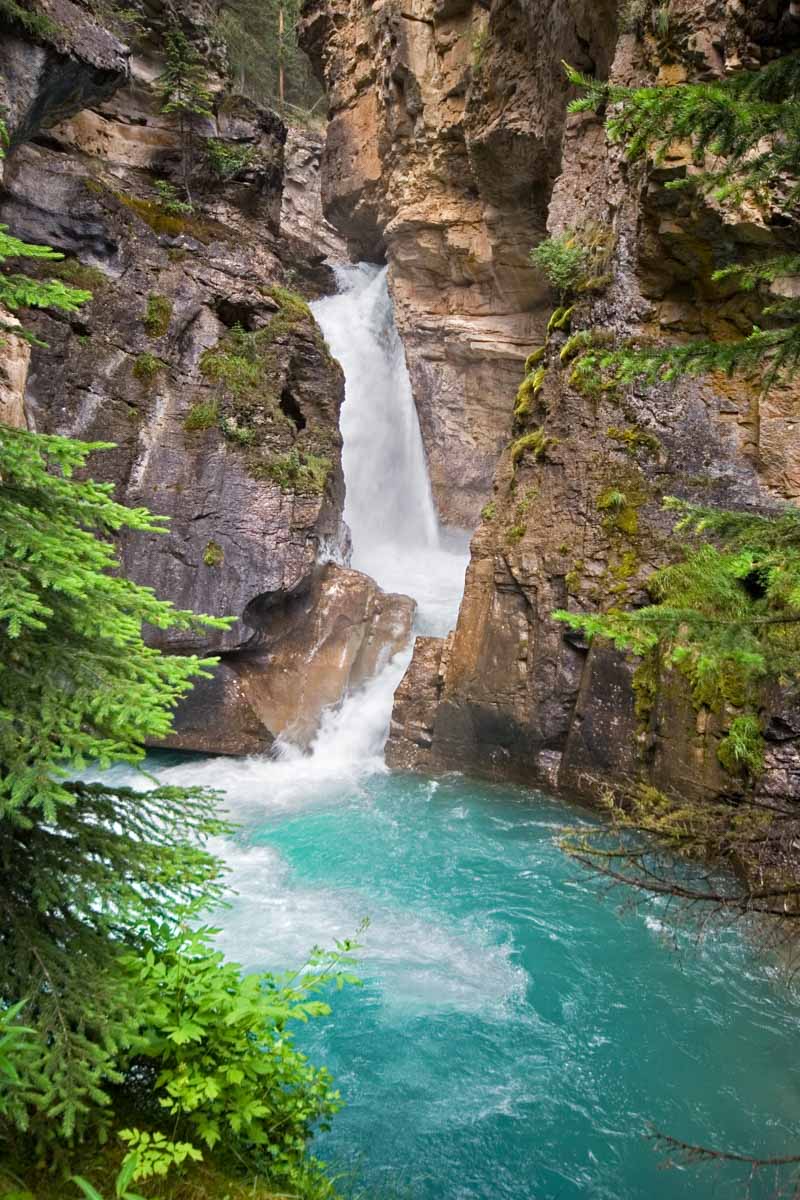
After you’ve wrapped up at Lake Louise, you can head towards Johnston Canyon, which is a nearby trail system that travels through a beautiful, stark canyon with teal rivers and waterfalls running through it. If you’re hungry, at the entrance is a small gift shop and cafe where you can buy soups and sandwiches.
On the trails, there are a series of catwalks that take you through the canyon to two sets of waterfalls – the Upper and Lower Falls – and a lake area called the Ink Pots. At the Ink Pots, you can see multicolored pools of water that look really unique and cool for pictures.
You can choose to only visit one or both of the falls, but keep in mind that the total Johnston Canyon trail from the start to the Ink Pots is ~11.7 kilometers round trip.
Evening: Dinner at Bill Peyto’s Cafe
After your busy, busy day in the northern part of Banff, there’s nothing better than sitting down for a big, warm dinner. Bill Peyto’s Cafe is an affordable and popular choice in the Lake Louise area for exactly that.
Full disclosure: I’ve actually never eaten here , but I’ve heard raving reviews about this place, which is actually attached to the HI-Lake Louise Hostel . After a long day (which this one definitely was), it’s a great place to enjoy hearty, affordable Canadian food and drinks.
Try the elk burger with a side of Canadian craft beer , and don’t forget to try their famous hot sticky toffee pudding cake .
Overnight near Lake Louise
On this night, you can choose to stay in your same Banff accommodation as the last two days, OR you can relocate closer to Lake Louise. I tend to prefer the latter because tomorrow, you’ll be heading north toward the Icefields Parkway, and it will eliminate over half an hour of driving for you the next day. Gotta make up for the sleep you lost last night!
Here are a few options for places to stay near Lake Louise:
- Splurge Resort: Fairmont Chateau Lake Louise – I know I haven’t been giving many “splurge” recommendations for this itinerary, but if you’re going to splurge for ONE NIGHT on your trip, this is it. I’ve been dreaming of spending a night or two in the Fairmont Chateau Lake Louise since the first time I visited, and I’ll be saving those pennies until I can do so one day. Anyway, if you’ve got the cash, there’s no better place to spend a night than this iconic hotel, which rests on the banks of Lake Louise itself.
- Mid-Range Hotel: Paradise Lodge & Bungalows – Perfect for larger groups, this family-friendly set of bungalows is located on the road to Lake Louise and offers large full kitchens in-unit. There’s no on-site restaurant, but the Lake Louise Visitor’s Centre isn’t far.
- Budget Hostel: HI-Lake Louise Alpine Centre – HI-Lake Louise Alpine Centre is located just outside of Lake Louise near the Visitor’s Centre. As another Hostelling International hostel, you can expect clean, cozy dorms and private rooms, large social areas and a kitchen, and affordable rates.
- Camping: Lake Louise – This tent camping spot is located right near Lake Louise and is the perfect place to spend a night in the area.
Day 6: Icefields Parkway
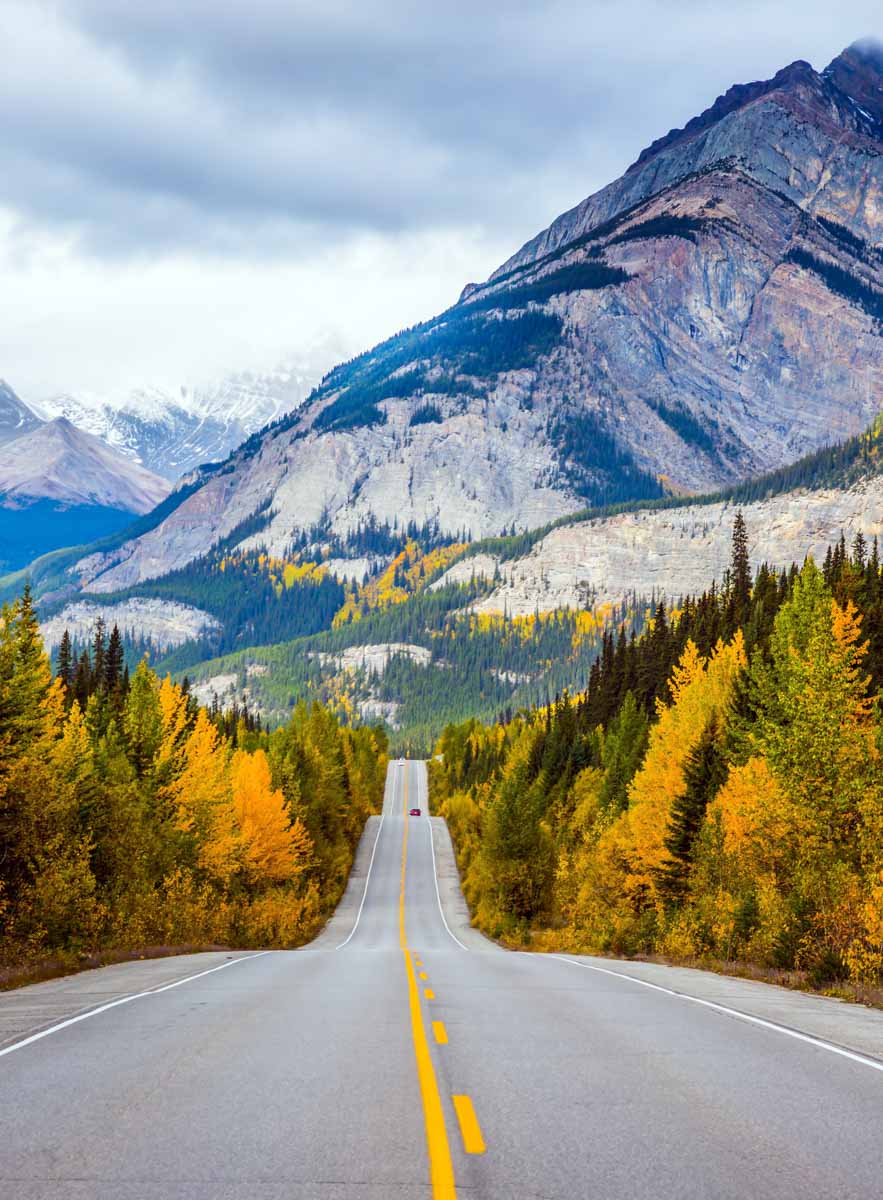
On Day 6, you’ll head up to Jasper via the most beautiful highway in the Canadian Rockies (and maybe in Canada…or the world…).
Nothing screams Canadian Rockies road trip more than driving its most scenic route, and today you’ll have the chance to do that, with a bunch of stops in between.
While the drive itself only takes ~3 hours, you’ll definitely want to stop for some photos, fresh air, hiking, and more. In this part of the itinerary, we’ve laid out all of your options for places to stop and things to do along the Icefields Parkway.
Morning: Alpine Lake Viewpoints
Grab an early breakfast to go at Trailhead Cafe in Lake Louise. I’d also recommend grabbing some extra sandwiches to go for lunch later, as you may not want to stop for food during your road trip.
Then, head out north on the Icefields Parkway towards Jasper. There are tons of amazing places to stop as you leave the Banff National Park area and turn into the Columbia Icefield.
First, stop at Peyto Lake, which is about 40 minutes from Lake Louise. Peyto Lake is a stunning turquoise lake that you can admire from its highway upper viewpoint, and it’s definitely worth at least a short photo stop before continuing onward.
Late Morning & Afternoon: Choose Your Own Adventure
After you’ve stopped at Peyto Lake, you have a TON of options for things to do along the way. Here are just a few of the many hikes, activities, and viewpoints you can stop at along the Icefields Parkway:
Columbia Icefield Discovery Centre – The discovery centre sits off of the icefields parkway about an hour and a half away from the Jasper Information Centre. Here you can get some scenic views from the top of the centre and you can book excursions out into the icefields. If you are feeling hungry, grab a bite in the attached Altitude restaurant. If you are just passing by on the way to Jasper, plan to spend 30 minutes here for a quick pit stop.
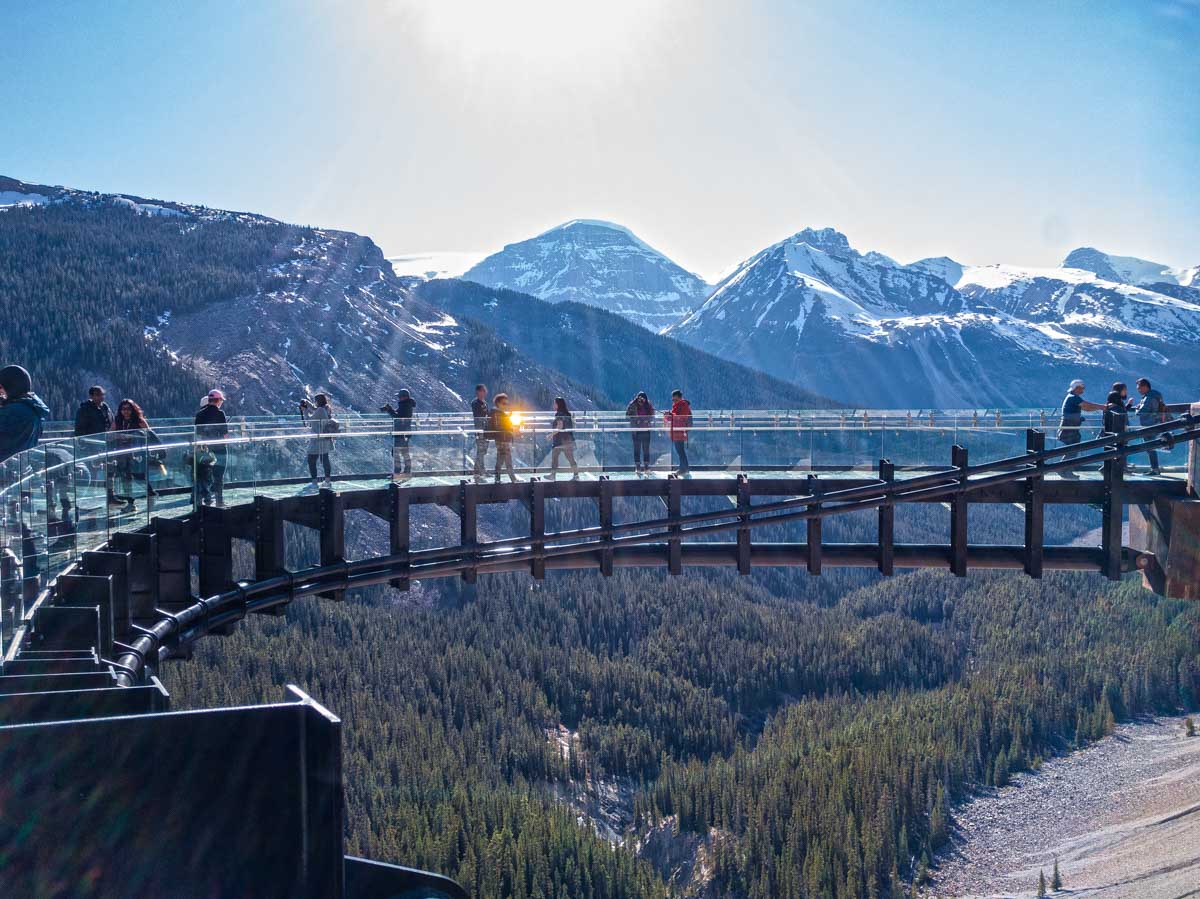
Glacier Skywalk – Take a 400 m walk along a glass-bottomed walkway that overlooks the gorgeous Sunwapta Valley 280 meters below. Tickets for the attraction can be purchased at the nearby Columbia Icefield Discovery Centre, which is about 6 km away towards Banff on the Icefields Parkway. Tickets cost $35 at the door, but you can pre-purchase them online for a slight discount. Plan to spend 30 minutes to an hour there.
Do a Glacier Walk – Take an Athabasca Glacier Tour where you can walk on and drink from the 10,000 year old sheet of ice. You’ll be taken out to the glacier on a huge all-terrain bus with a knowledgeable guide who will teach you about the area’s history. After arriving on the glacier, you’ll get to walk directly on the ice and explore crevasses and hills. Some tours are all day events (10 am – 5 pm), but you can find shorter trips at the Discovery Centre that are 3 hours in length.
Mistaya Canyon – If you are looking for a short half hour break while driving up to Jasper, consider stopping at Mistaya Canyon. Look for a small parking area about 5 km South from the Saskatchewan Crossing. You’ll take a short 10 minute hike that crosses a wooden bridge where you can see beautiful views of the mountains and waterfalls surrounding Mistaya Canyon. This spot is not as well known to many tourists, so it’s a good peaceful place to stop on your way to Jasper or Banff.
Herbert Lake – Herbert Lake is only 6 km away from Lake Louise along the Icefields parkway. Similarly to Mistaya Canyon, looks for a small pull-out area next to the highway where you can park your car. A short 5 minute trail will take you to a brilliant, scenic view of a tranquil, mirrored lake. You’ll have the option of following the trail around the perimeter of the lake if you choose, or simply enjoy the serenity and tranquility of this secluded area.
Chephren Lake – Stop off at the trailhead for Chephren Lake, one of my favorite lakes on the Icefields Parkway. You have to hike in ~3 hours round trip to get there, but I promise the views are totally worth it. By the time you finish up with Chephren Lake, it should be early afternoon and you’ll be ready to continue on to the rest of the Icefields Parkway.
Parker Ridge – About an hour and half from Lake Louise, Parker Ridge offers unparalleled views of the Icefields and Saskatchewan Glacier. The hike is a short 2.7 km that climbs 250 m. You’ll be above the treeline for the majority of the hike. Set aside about 2 hours for the entire round trip. Parking is limited.
Evening: Dinner at Evil Dave’s Bar & Grill in Jasper
For a cozy dine-in experience, Evil Dave’s Bar & Grill is a local favorite. With eclectic decor and delicious, large dishes, it’s a really awesome choice for a post-road trip dinner in Jasper.
They serve up Western Canadian favorites, like Tenderloin and Grilled Chicken sourced from Alberta, but they’ve also got a whole list of amazing vegetarian and vegan options as well.
Overnight in Jasper
- Mid-Range Hotel: Pyramid Lake Resort – This resort looks like a giant log cabin from the outside and sits right next to a lake. Guests will have scenic views of the mountains and can dip their feet in the water just a couple of feet from the hotel.
- Budget Hostel: Jasper Downtown Hostel – With dorms and private rooms, the Jasper Downtown Hostel is the best place for backpackers in Jasper. It offers all the proper amenities of a hostel, including common areas, a shared kitchen, and laundry machines on-site.
- Campsite: Wapiti Campsite – Wapiti is located next to the Athabasca river and offers gorgeous views of the mountains. The site includes access to hot showers, electricity, and fire pits. It is also close to the main town so you can make quick runs for supplies.
Day 7: Hiking in Jasper
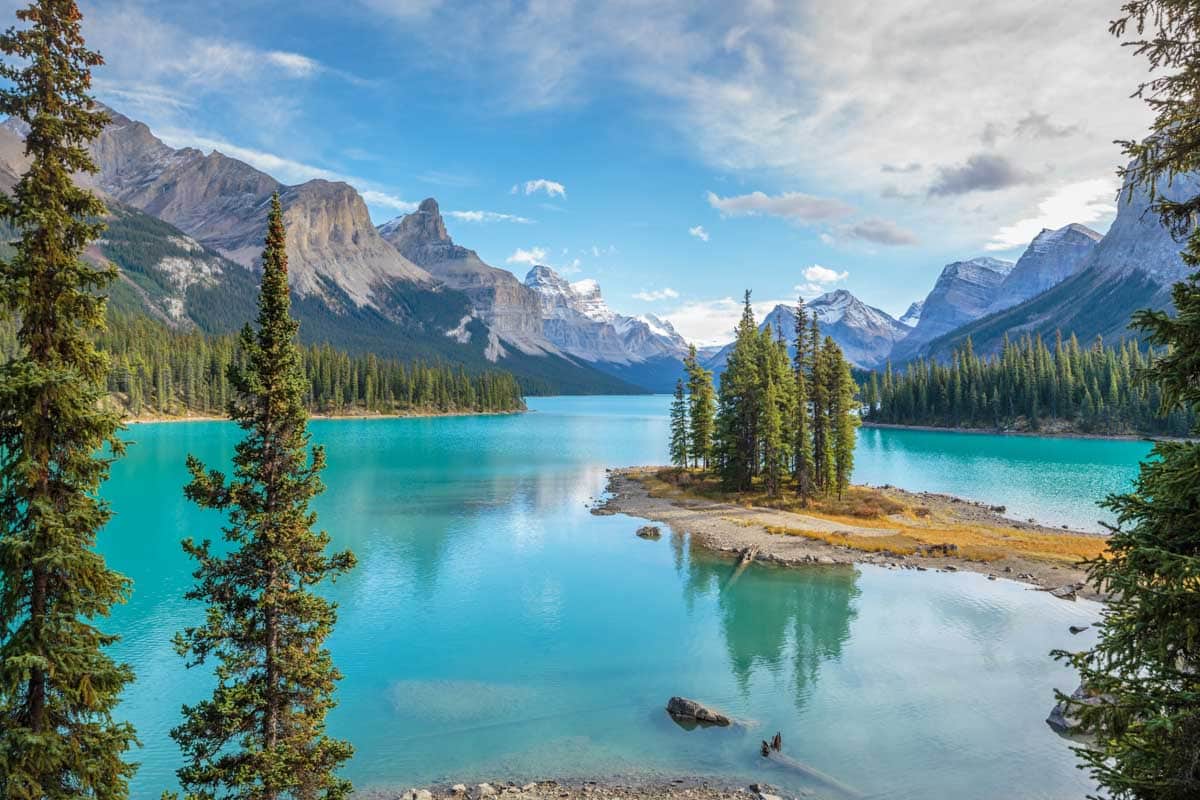
Day 7 is all about exploring Jasper by foot! ( Do you like how I’ve left a whole day in every destination on this itinerary for hiking? Yeah…I kind of like hiking… ) There are several hikes in Jasper for hikers of all levels, from “never hiked before” beginners to experienced mountaineers.
Today, you’ll spend most of the day hiking, then you’ll relax in the hot springs before treating yourself to dinner in one of Jasper’s best restaurants.
Morning & Afternoon: Hiking in Jasper
Like I mentioned, there are dozens of hikes you can try in Jasper ranging from easy, flat trails to rock scrambles. I’ve listed out some of the most popular ones for you here so you can choose 1-2 and plan your day:
Easy Hikes in Jasper
Maligne Canyon: (Easy, 3.9 kilometers) An easy, short hike, Maligne Canyon brings you through a striking canyon, passing by ranging rivers and breathtaking waterfalls in the process. Perfect for families or beginner hikers wanting to see some of the most awesome views in the park!
Valley of the Five Lakes: (Easy, 4.5 kilometers) The magic of the Valley of the Five Lakes trail is exactly what it sounds like: five gorgeous, picturesque lakes with the Canadian Rockies lying majestically in the background. It’s perfect for beginner hikers wanting an easy half-day adventure on one of the most tranquil and iconic Jasper hiking trails.
Moderate/Challenging Hikes in Jasper
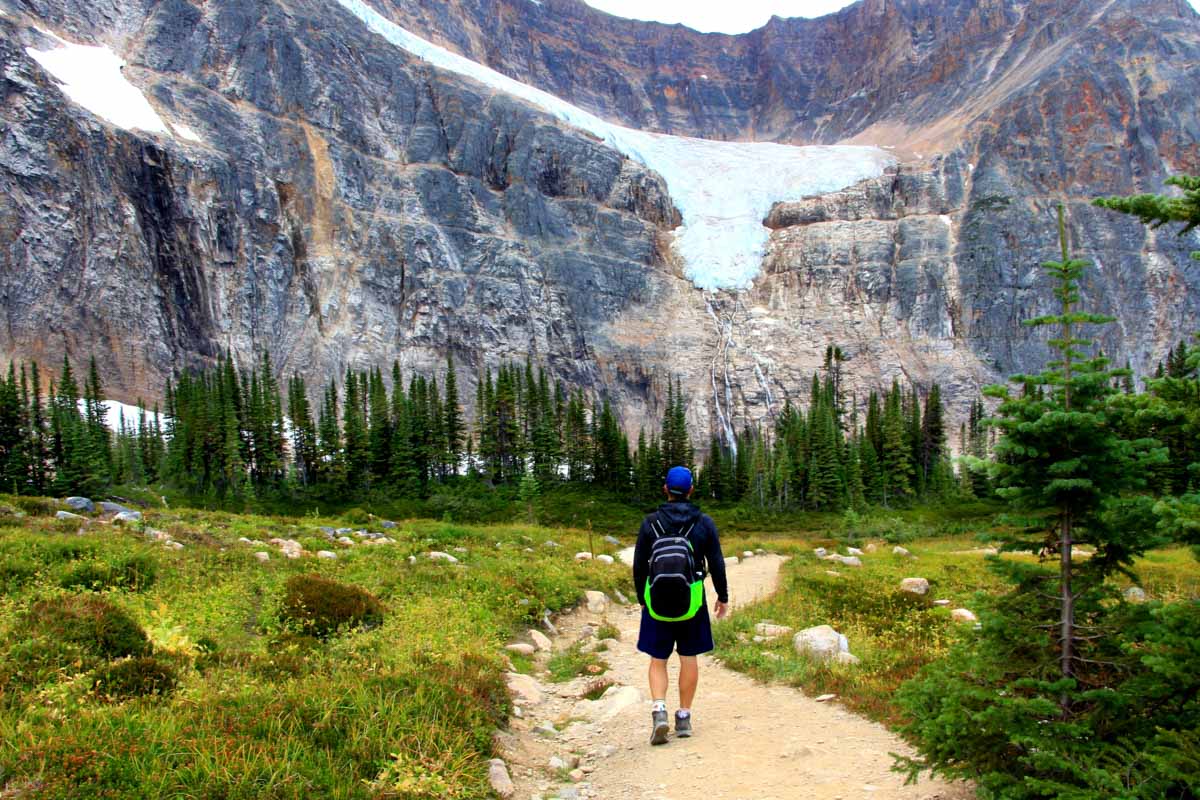
Edith Cavell Meadows: (Moderate, 6 kilometers) Edith Cavell Meadows is one of the most popular trails in Jasper, and for good reason – it’s got a bit of everything, from mountain views to alpine meadows to hanging glaciers and more. The first part of the path is paved, leading you to a lookout point over Angel Glacier. After the lookout point, the trail continues ascending, and the path leads to two more viewpoints – most people (myself included) choose to stop at the second one.
Bald Hills: (Challenging, 13.2 kilometers) As one of the most popular full-day Jasper hikes, Bald Hills is an amazing and challenging trail that will bring you up to some of those drop-dead gorgeous views you see in the postcards. This summit hike is one of the best hikes you can do in the park, and we highly recommend it if you’re up for the challenge.
If you’re in need of some food for fuel or relaxation, head to Coco’s Cafe in downtown Jasper. They serve amazing coffee beverages and snacks for hungry hikers (including some seriously mouth-watering vegetarian and vegan items), and their prices are affordable.
Evening: Dinner at Maligne Canyon Wilderness Kitchen
For the perfect smoky, rich, locally sourced meal, there’s no better place in Jasper to try than the Maligne Canyon Wilderness Kitchen . Located next to the Maligne Canyon trailhead, this small, charming restaurant embodies the spirit of Canadian Rockies gastronomy, with locally sourced meats and produce.
If you’re super tired from the trails, you can also grab their mouth watering dishes to go, but why not stick around and enjoy the fresh smells and flavors in-house?
You’ll spend the night in the same Jasper accommodation you chose on Day 6.
Day 8: Jasper Town & Iconic Sights
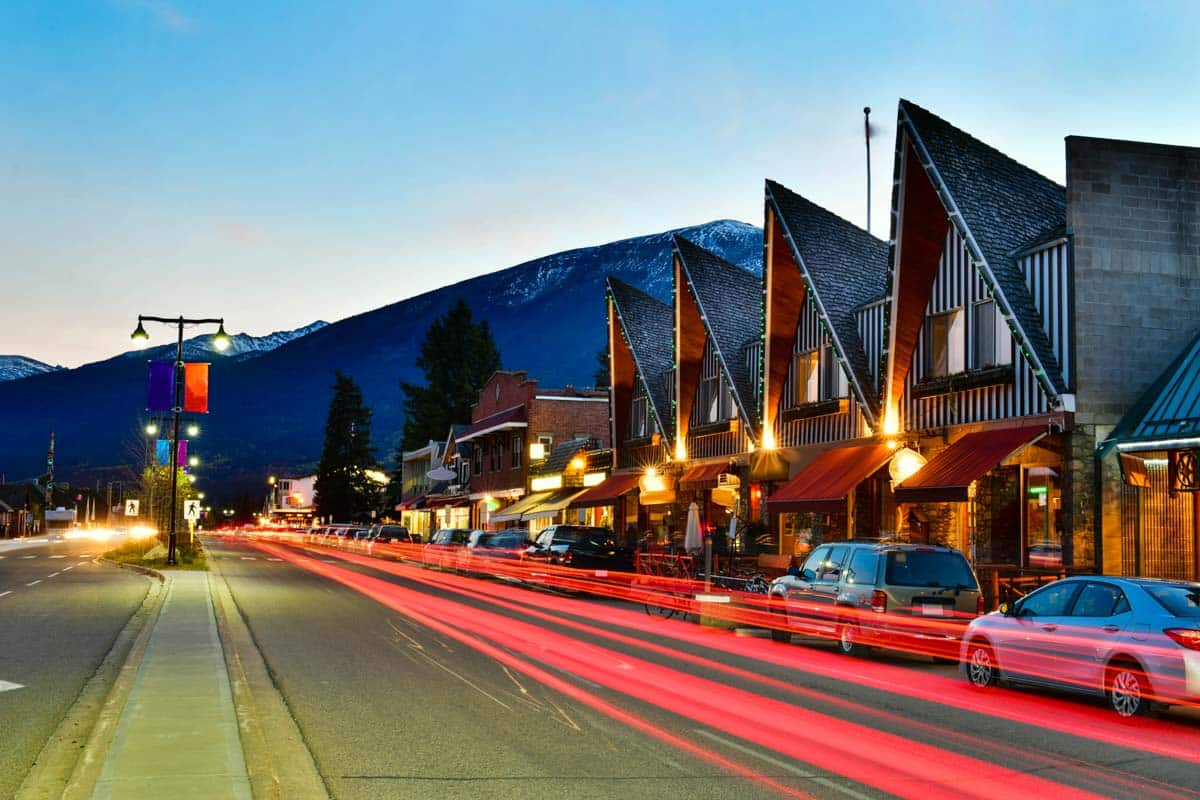
After your big day of hiking yesterday, you’ll take it a little bit easier on Day 8. However, you’ll start your morning super early with a beautiful sunrise view, head to one of the most picturesque lakes in ALL of Jasper, and then explore the area surrounding Jasper town before heading toward Yoho National Park.
Early Morning: Sunrise at Pyramid Lake
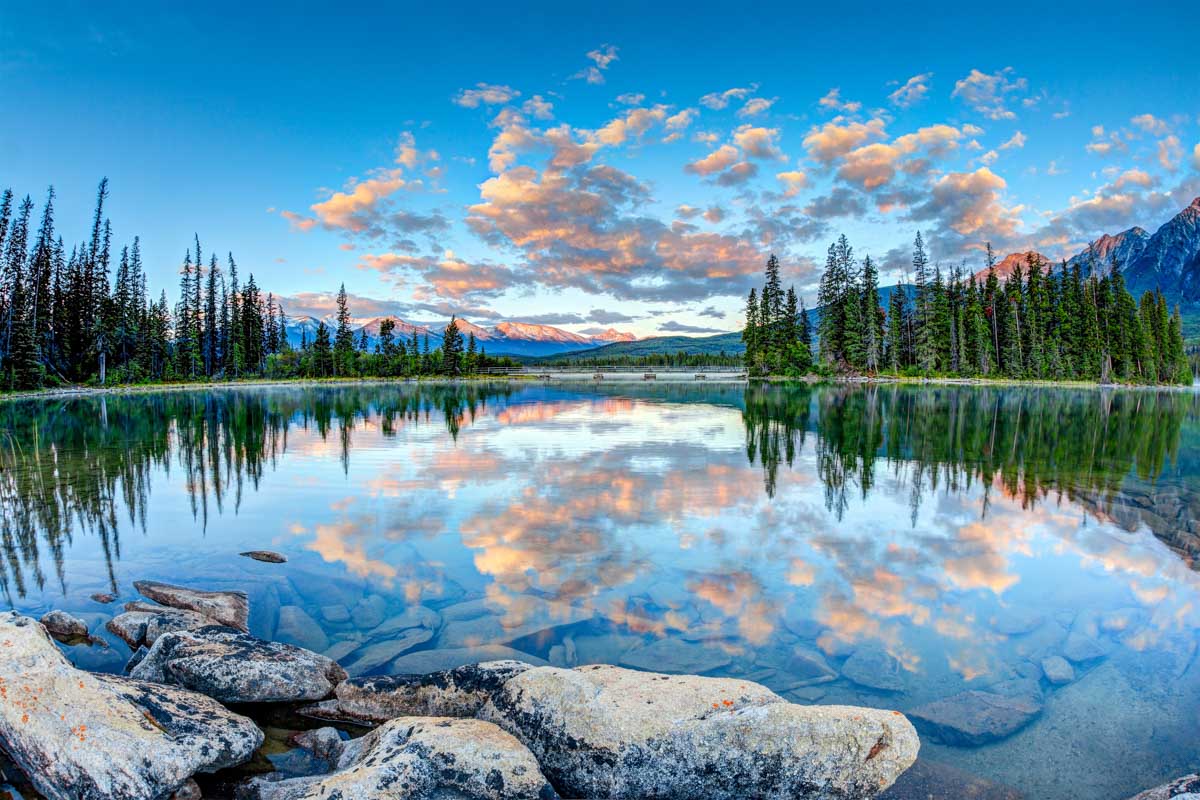
You’ll head out before 6 AM (check the sunrise forecast on your Weather app for a more accurate departure time) to Pyramid Lake.
This dramatic lake is home to a towering mountain peak, a beautiful blue lake, evergreen forests, and a large wooden lodge.
You should get there when the sky is still a deep navy blue, but just bundle up and wait for the sunrise. If it’s clear enough outside, you should start to see the faint hues of pink and red slowly start to paint the mountain face (like the photo I took a few years ago below).
If you’re looking for an alternative view, nearby Patricia Lake is also a really lovely place to watch the sun as it peeks over the horizon. Patricia Lake’s water is a lot more still than the water at Pyramid Lake, creating a gorgeous “mirror lake” effect.
Head back to Jasper town center to grab a quick coffee and breakfast at Coco’s Cafe (or another one of Jasper’s coffeeshops!).
Morning: Maligne Lake
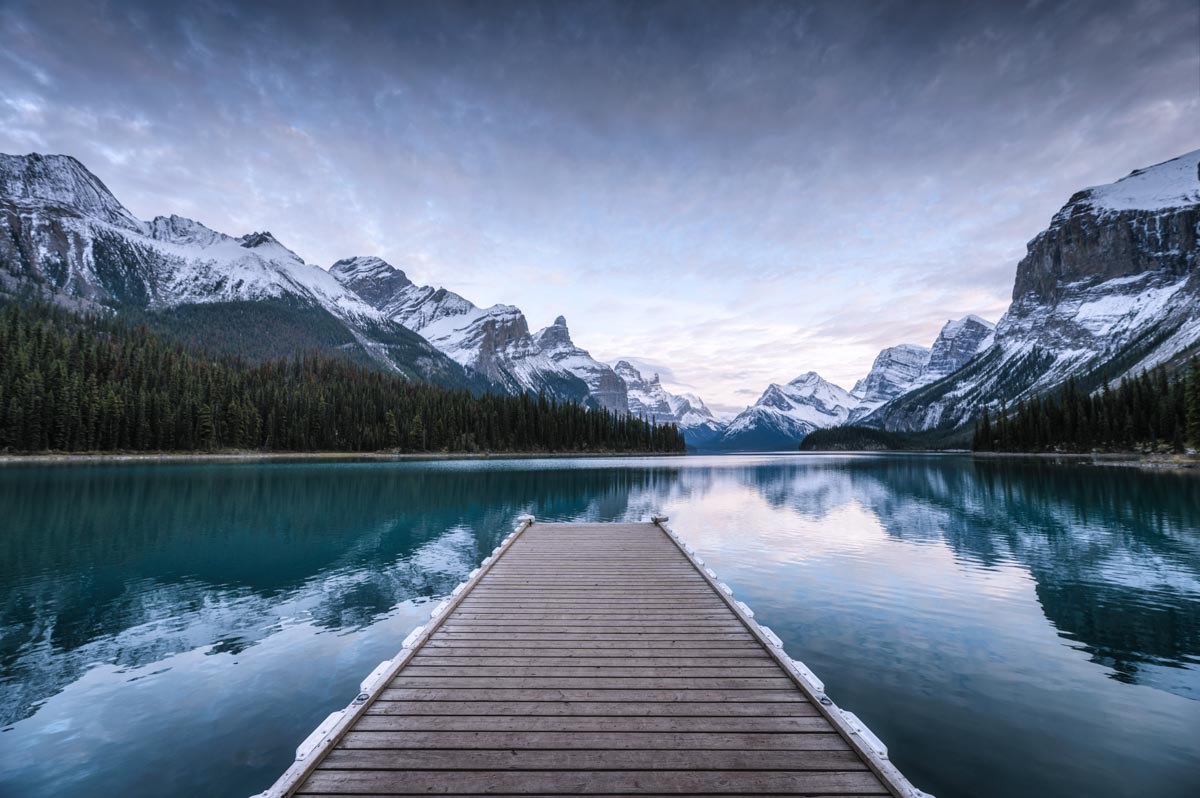
From Jasper town center, it’s a bit of a drive to arrive at Maligne Lake. However, once you’re there, you can spend the rest of the morning simply wandering around the area, doing a nearby hike or getting out on the water.
Here are a few ways to spend your morning in Maligne Lake:
Admire Spirit Island – One of the famous views in Jasper is Spirit Island, a tiny, evergreen-filled island jutting out into the middle of Maligne Lake. It’s super picturesque amidst the backdrop of the clear, turquoise waters of Maligne Lake, and makes for a super picturesque spot to spend the morning.
Take a boat tour – There are a handful of motorized boat tours that travel through the Maligne Lake area, and you can book one very easily. If you’re feeling tired from all of your travel (I understand, this itinerary is SUPER jam-packed!), opt for a relaxing boat cruise around the beauty of the lake.
Kayak around the lake – If you’re looking for an active alternative to the boat cruise, you can rent a kayak and explore around the lake yourself!
Go hiking – There are tons of trails and hiking areas that extend from Maligne Lake up into the nearby mountains.
Early Afternoon: Explore the Jasper Town Area
Now that you’ve spent virtually the entire morning outside, you’ll return to Jasper town center and enjoy some of the more laid-back attractions in the area.
Since you won’t have a TON of time to do things in Jasper town, here are a few suggestions for things you can do with 2-3 hours:
Ride the Jasper Skytram – The Jasper Skytram brings you close to the top of Whistlers Mountain. There’s a sizeable observation deck and an area where you can grab food and drinks. Or, if you’re feeling more adventurous, hop on the hiking trail near the platform to reach the summit of the mountain.
Go cycling on Jasper’s bike paths – Rent a bike at Vicious Cycle Canada and hit the trails! There are plenty of bike trails in and around Jasper’s town center where you can explore on wheels.
Visit the Jasper-Yellowhead Museum – Located in the center of Jasper, the Jasper-Yellowhead Museum discusses how Jasper’s community began, and provides important historical context to the area that’s now largely known for its natural beauty and adventure activities.
For our entire list of things to do in and around Jasper town, check out the complete guide:
Click here to read our complete guide to things to do in Jasper
Late Afternoon & Evening: Drive to Yoho National Park
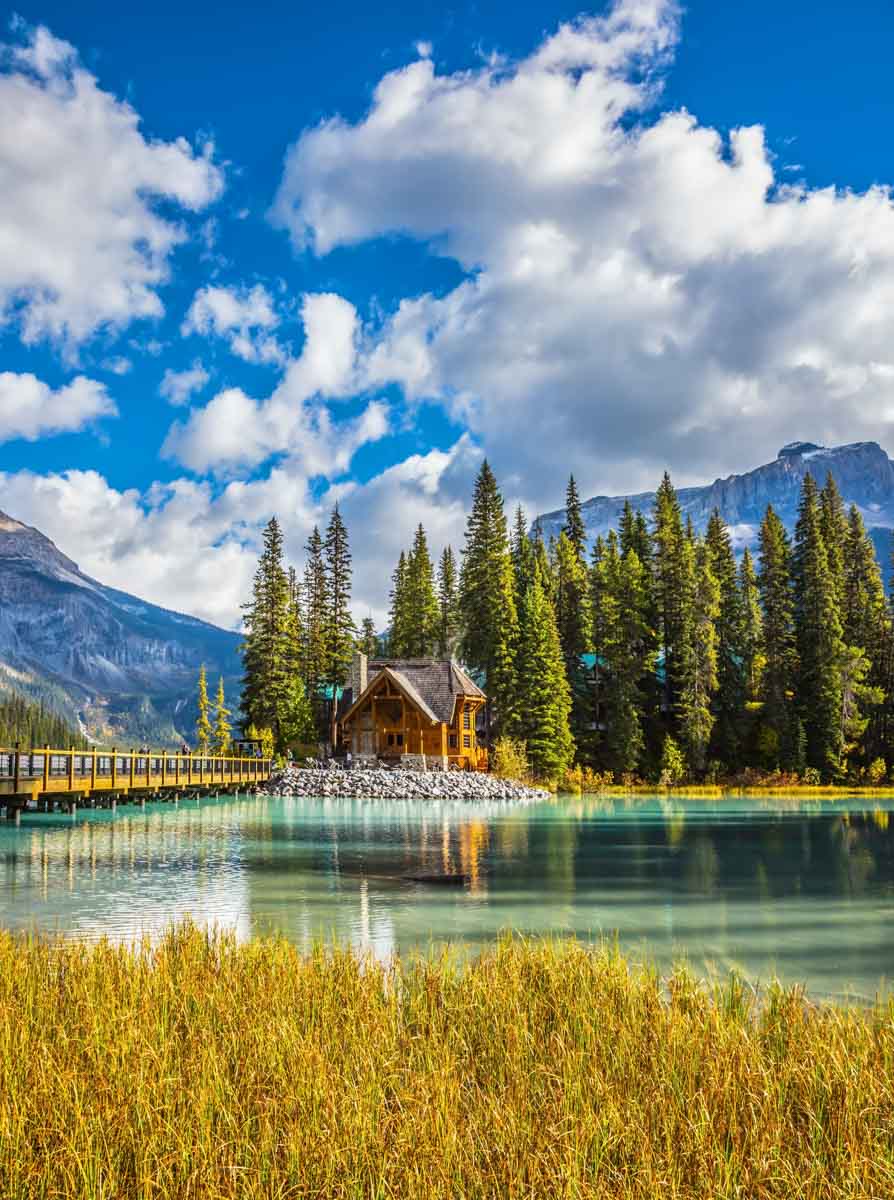
The drive to Yoho, your next stop, takes 3.5-4 hours, and since you’ve already made your stops on the Icefields Parkway, you can drive it straight. However, I’d plan to leave Jasper no later than 2 PM to make sure you have plenty of daylight to drive all the way to Yoho.
Once you’re in Yoho, you’ll actually stay in Field, the town of Yoho. There, you can grab dinner (I recommend Truffle Pigs Bistro & Lodge ) before settling in to your accommodation for the night.
Overnight in Field (Town of Yoho National Park)
- Mid-Range Hotel: Truffle Pigs Lodge – This 12-room inn is a small, comfortable, mid-range hotel option. With private rooms and bathrooms and an attached restaurant, it’s the perfect full-service accommodation option for Yoho. It’s also located in the heart of the tiny town of Field, perfect for access to all of the main park attractions.
- Budget Hostel: Fireweed Hostel – Built into a two-story log cabin, this cozy hostel is the perfect backpacker lodge for budget travelers in Yoho. Located in the town of Field, it’s an easy drive from most of the park’s main attractions, and there are typical hostel amenities like communal hangout space and a kitchen. It’s perfect for backpackers and solo travelers!
- Campsite: Kicking Horse Campground – A well-maintained, quiet campsite in Yoho National Park, Kicking Horse Campground offers campers a place to rest their heads (and shower, and get access to running water) from late June to October.
Day 9: Hiking & Sightseeing in Yoho National Park
Today is your full day in Yoho National Park, which is the smallest Canadian Rockies park and one of the most easily overlooked stops on any Canadian Rockies itinerary.
It’s actually in British Columbia, so it’s often not listed on “places to visit in Alberta” lists. But it’s equally, if not more, beautiful than its neighbors.
In fact, the word “yoho” in Cree, a local indigenous language, means something like “WOW!!!!” When you see it, you’ll probably agree that Yoho National Park is definitely deserving of such a high honor.
On Day 9 of your Canadian Rockies road trip, you’ll take the full day to explore Yoho. Banff is just a short drive (~40 minutes) away, so you can hang out here until about dinner time and then head over to Banff to spend the night.
FYI: Yoho doesn’t actually fully open all of its roads until late June, so you may need to modify your Canadian Rockies road trip plans if you come earlier in the season.
Morning: Takkakaw Falls and Emerald Lake
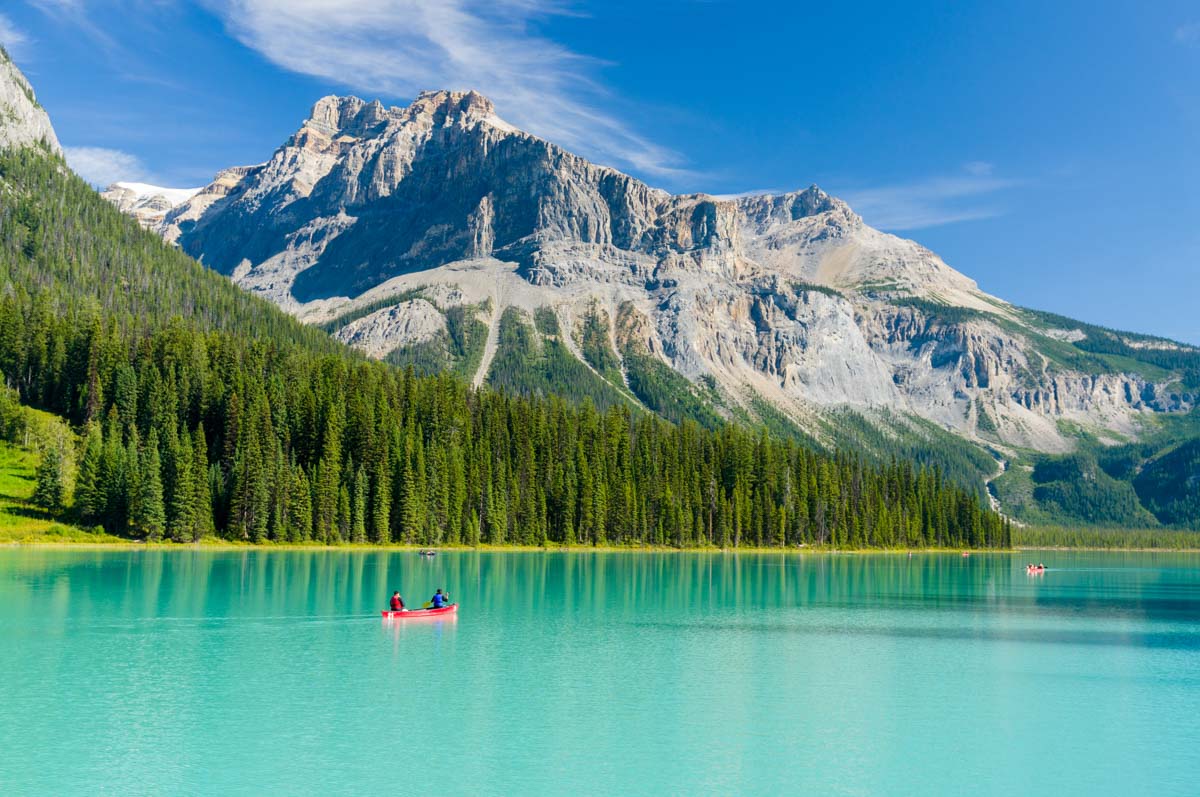
Takkakaw Falls is the second highest waterfall in Western Canada and is a super spectacular spot to head to in the morning. The access road is only open from June through early fall, so unfortunately if you are headed to the Canadian Rockies in the spring, you won’t be able to see the fall at that time.
To get to the end of the falls, you’ll need to take a trail, which is only ~1.5 kilometers. Once you arrive at the base of the falls, you can stand close enough to feel the cool water sprinkle your face. Cool (literally), huh?
Next, head to Emerald Lake, a stunning alpine lake in Yoho not far from Field. Here, the f ine sediment from the glaciers sits in the water and gives it its characteristic emerald color after which it is named. You can rent a kayak here or hike the 5.3 kilometer loop trail around the lake!
Afternoon: Lake O’Hara
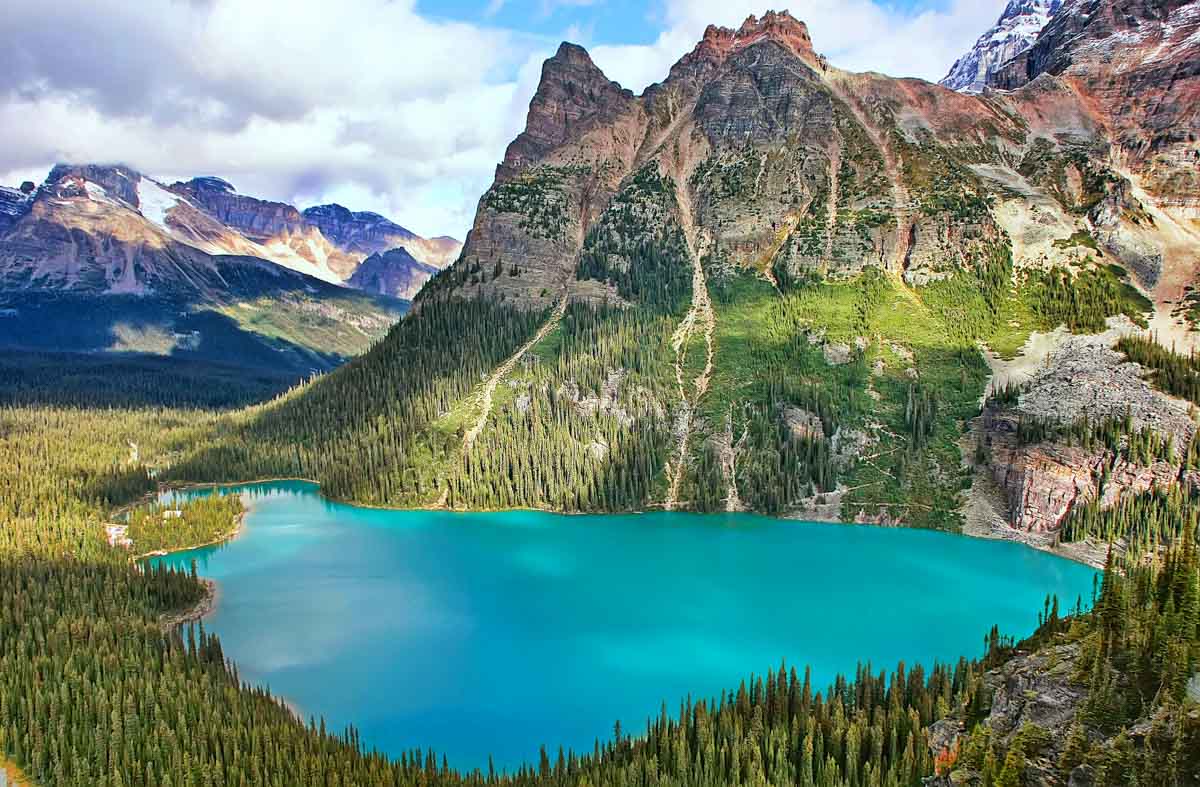
Lake O’Hara is an alpine lake, and is one of the main sights in Yoho National Park. It’s definitely worth the long journey it takes to get there.
Situated at 2000m in elevation, you need to hike up a trail in order to get there (but you may be able to pay to take a shuttle down back to the parking lot during the summer months. Note, however, that this is not a guarantee!)
Advance reservations are required to go up to the lake, however, you are still able to hike the 11 km up to the top even if you weren’t able to get a bus reservation.
If you don’t get a bus reservation, you will have to hike back down the 11 kilometers you came (which means this will easily turn into a full-day excursion!). However, if you are able to take the bus back down, plan to be around Lake O’Hara for 4-5 hours. (If you have to hike both ways, plan for 6-7 hours.)
Evening: Dinner in Banff
For your last dinner, you’ll head back to Banff’s town center. You can eat at one of your favorite restaurants from before, or opt for a bit more of a “fine dining” experience at one of these Banff local restaurants:
Saltlik – Enjoy a nice quality steak dinner at one of Banff’s premier steakhouses. There is a separate bar area for drinks. The restaurant has a great selection of side dishes. Try the mac and cheese!
The Bison – This picturesque dining establishment features wood-fired inspired food, and their dishes are LITERALLY to die for. For meat lovers, choose between ribs, bison, duck, or trout. Vegetarian dishes are also available. And, of course, before you leave Canada, you’ve got to try their poutine!
You’ll be back in Banff for your final night of this Canadian Rockies itinerary, so enjoy it! Again, here are my recommendations – the same ones as before – for a few popular places to stay (or you can read this post for the full list, from luxury lodges to budget hostels):
Day 10: Return to Calgary
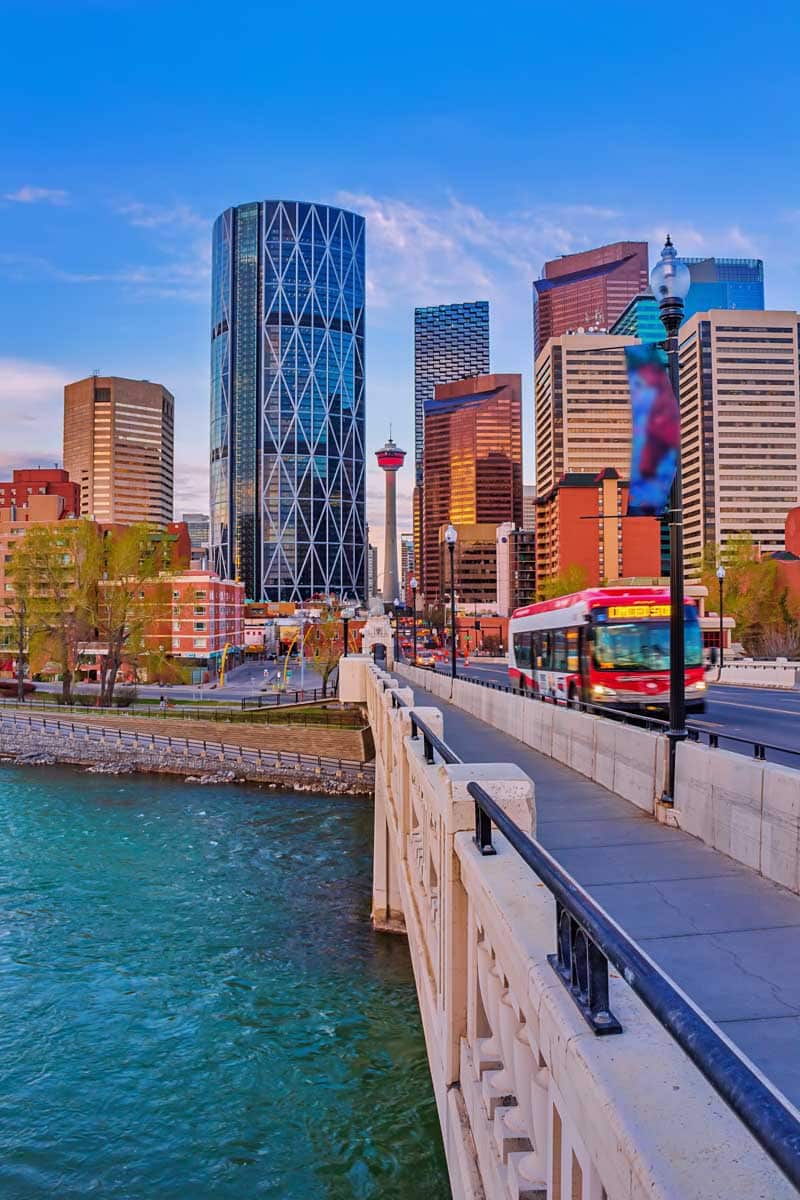
It’s the last day of your Canadian Rockies itinerary, and sadly you’ll have to return back to your normal life soon. But before you go, you’ll spend one last blissful morning amidst the peaks and forests before heading back to Calgary.
Morning: Sunrise at Vermilion Lakes
Wake up early (before 6 AM) and head to Vermilion Lakes for your final morning in the Canadian Rockies. This is THE sunrise spot, and we left this for the last day so that you can enjoy one last morning of tranquil mountain magic before heading back to the real world (*sobs*).
Even on misty mornings, the sunrise here can be quite beautiful, so I’d recommend going even if it looks cloudy outside. Park in the parking lot at Vermilion Lakes and walk into the shore area, where you can sit and enjoy a warm drink or just listen to the sounds of the morning.
It’s here where you’ll bid farewell to Banff and the Canadian Rockies and all of your amazing memories you’ve just made over the last 10 days. From personal experience, I will say that this place really sticks with you, forever. The landscapes of the Canadian Rockies have truly made an impression on me that my heart will always yearn for.
Returning to Calgary
You’re finally reaching the end of your Canadian Rockies road trip. (Sad face emoji!)
Depending on what time your flight is scheduled to depart, you’ll need to make your way back to Calgary. When you’re ready, dry your eyes and hop in the car, taking the Trans-Canada Highway all the way back to the city. Drop off your rental car wherever you picked it up, head back to the airport, and bid those incredible mountain vistas adieu .
Feeling some serious post-Rockies depression already? Well then you’ll just have to plan another trip up here! There are LOADS MORE things to do in the Canadian Rockies than we had time for in this itinerary, and until then, you can drift off to sleep at night with visions of the snow-capped rocky peaks and magical turquoise lakes dancing around in your mind…
Other Places to Visit on a Canadian Rockies Itinerary
If you’re one of the lucky ones who actually has more time in the Canadian Rockies than 10 days, read on for a few more areas you can add to your Canadian Rockies itinerary:
Waterton Lakes National Park
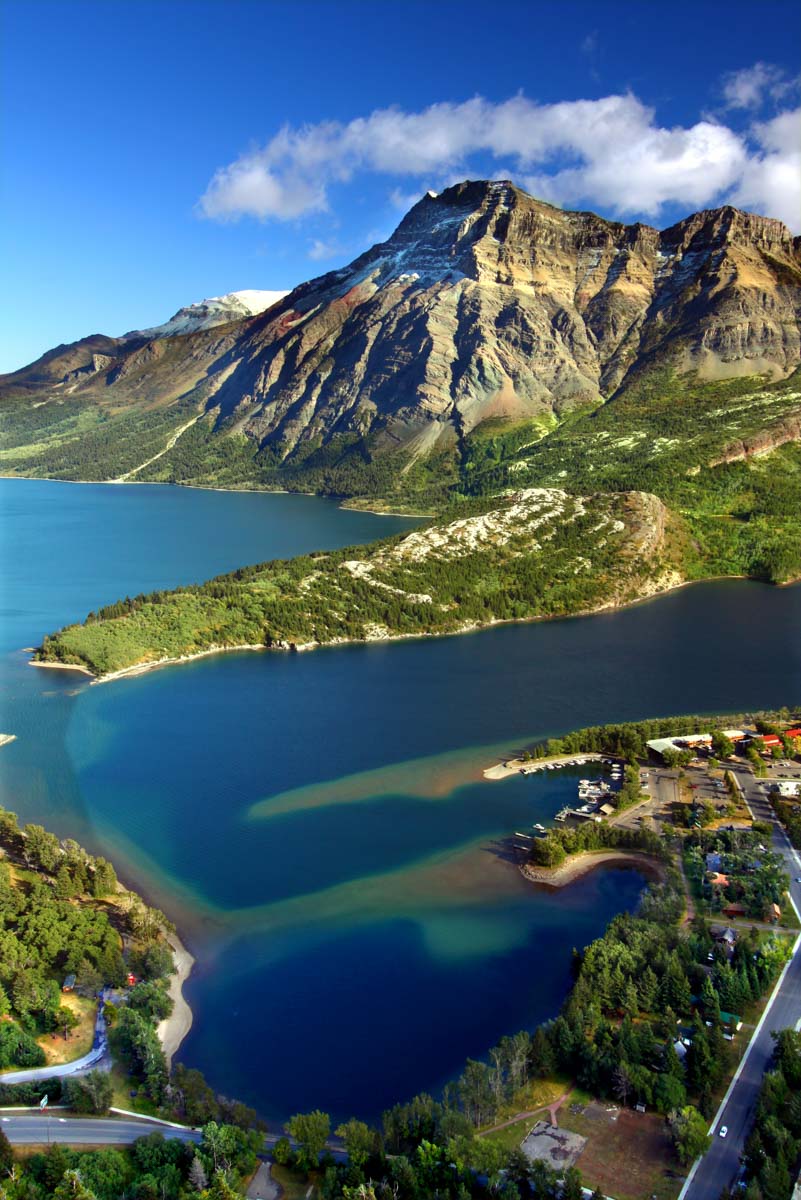
Waterton Lakes National Park (along with its US neighbor, Glacier) is a UNESCO World Heritage Site and International Peace Park. This Alberta national park consists of a giant glacial lake system surrounded by mountains, and it rests on the Canadian border with Montana. Its a bit far from the rest of the parks on our itinerary, but it’s definitely a worthwhile addition to any Canadian Rockies road trip!
Like its northern neighbors, Waterton Lakes is full of amazing, spectacular views and hiking trails, including its famed Triple Crown hiking challenge. To learn more about Waterton Lakes and the hiking trails there, visit our complete guide:
Kootenay National Park
Kootenay National Park , located in British Columbia, is another lesser-known Canadian Rockies national park. Located southwest of Banff National Park, you can experience all kinds of beautiful hiking trails here, with amazing, breathtaking alpine lakes and mountain passes to explore. It’s not far from the rest of the places on this Canadian Rockies itinerary and would be the perfect addition if you have a few extra days to spend in the region.
I haven’t actually personally been to Kootenay National Park, but this guide to 25 things to do in Kootenay is an excellent starting point if you’d like to explore the area.
Additional Canadian Rockies Travel Resources
Phew! If you’ve made it this far, congratulations. You’ve literally gotten your hands on all of the information you need for all of the stops on this itinerary. However, we do have even MORE detailed guides on each of the stops in the Canadian Rockies on our website and beyond.
The below resources (both our guides and the external ones) are all really helpful for learning more about the attractions at each stop on this itinerary, or for adding activities and extending your trip.
Have a look and remember — these are ALL just our recommendations. Doing more research on the area enables you to make your Canadian Rockies itinerary the perfect one for YOU!
Our favorite (external) Canadian Rockies travel resources:
- Lonely Planet: Banff, Jasper, and Glacier National Parks – If you’re into physical guidebooks to take with you when you travel, this is the ultimate companion to our Canadian Rockies itinerary. The Lonely Planet guide to Banff, Jasper, and Glacier has all the information you need to get around, find a nice place to stay, and book tours for the adventures you want to try.
- Moon Canadian Rockies – Another comprehensive print guidebook about Banff, Jasper, and more! It never hurts to have more than one, right?
- Parks Canada Website – This website is the ultimate resource for up-to-date information about the national parks in Canada. Here, you can find out about road and trail closures, construction occurrences, weather warnings, and more.
- To Banff and Beyond – A wonderful Banff-focused travel blog which includes several tips, hikes, and activities to do in the Canadian Rockies area!
10 Days in the Canadian Rockies Itinerary: Read Next
All of our own guides, tips, and misadventures in the Canadian Rockies
- Incredible Hikes in Canmore
- 23 Incredible Things to Do in Banff National Park
- Where to Stay in Banff National Park
- 17 Spectacular Things to Do in Jasper National Park
Love This? Save and Share on Pinterest
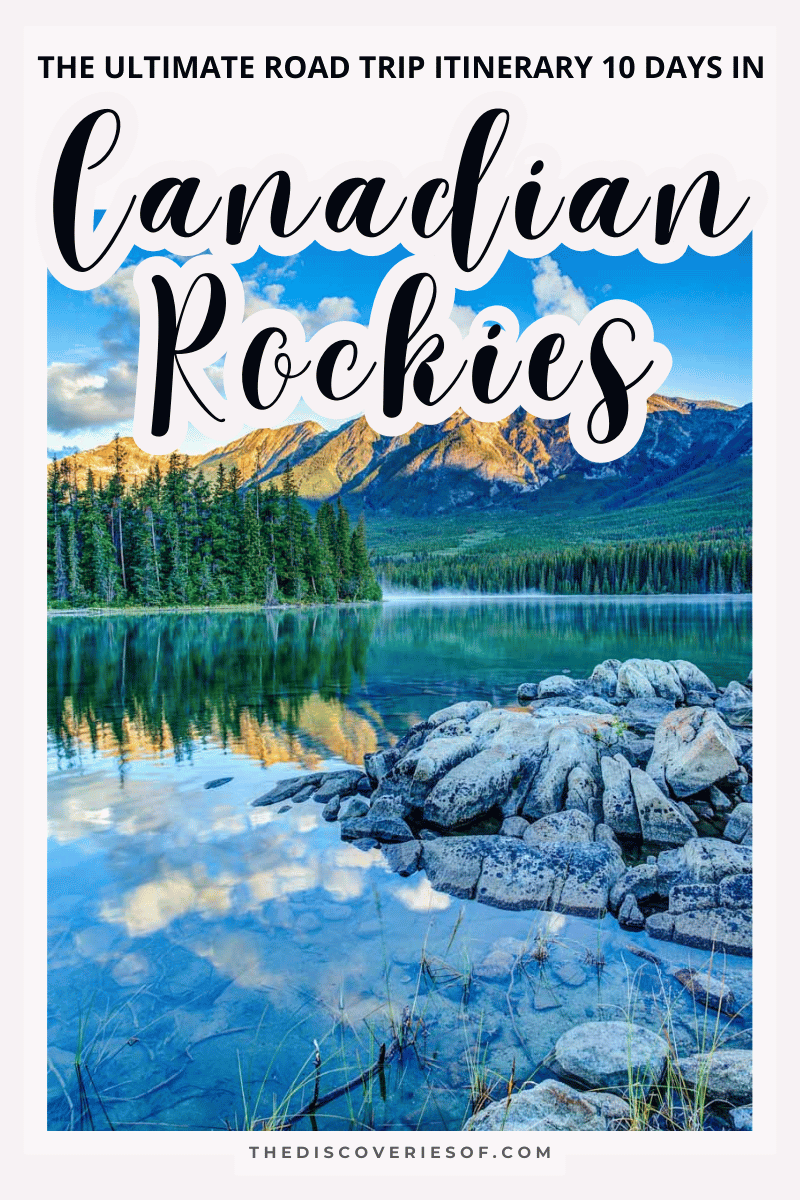
I’m Kay. I’m originally from small town Virginia, but have moved all around the East Coast and the United States for basically my entire life. I spent my childhood days blissfully wandering through the Blue Ridge Mountains, rolling in leaves, playing in creeks…you know, the usual overly adventurous 5-year-old stuff.
But those early years spent outside gave me a real problem: I’m now an adventure addict. Basically, if I’m not at my computer banging out articles or photos, I’m probably out hiking, biking, or camping somewhere beautiful.
Related Posts
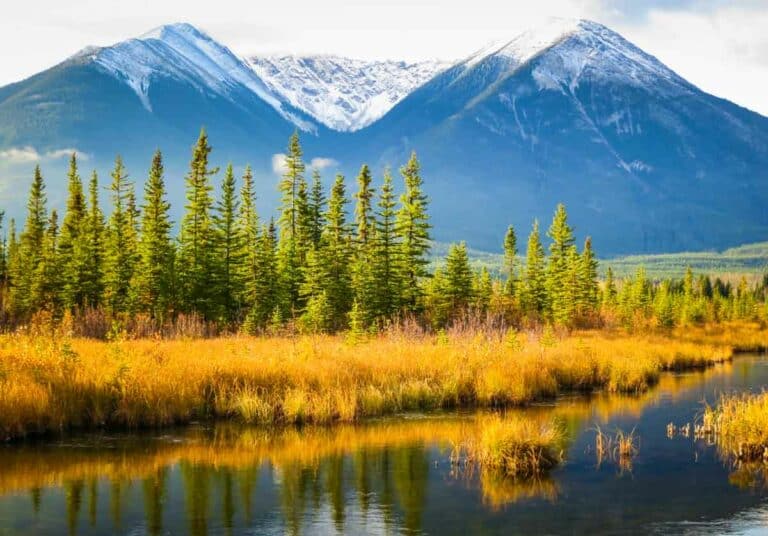
17 Incredible Things to Do in Jasper National Park
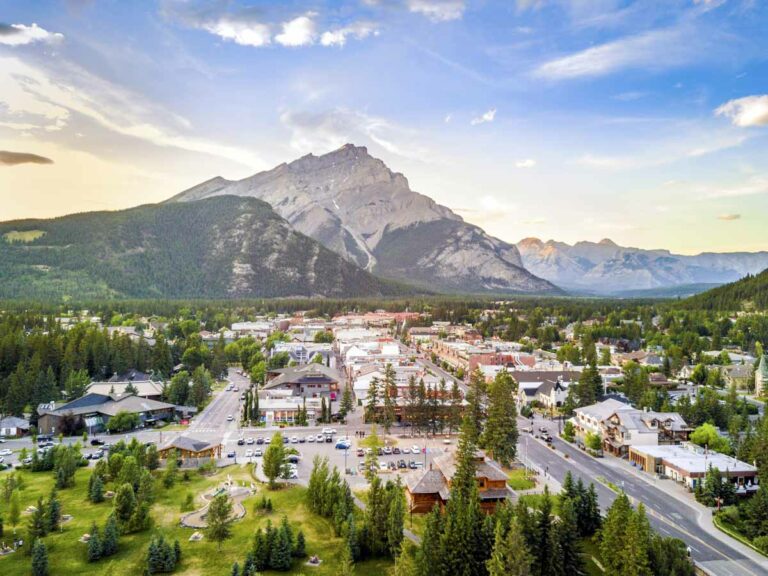
The Best Places to Stay in Banff National Park: A Complete Guide
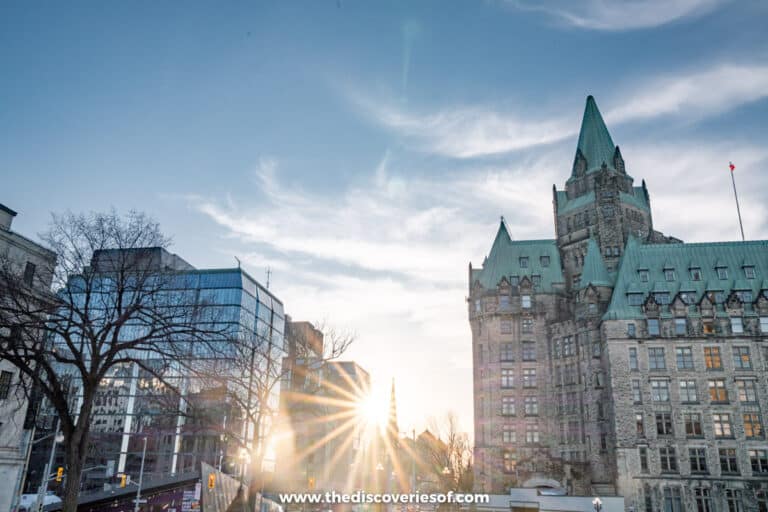
2 Days in Ottawa: The Perfect Ottawa Itinerary
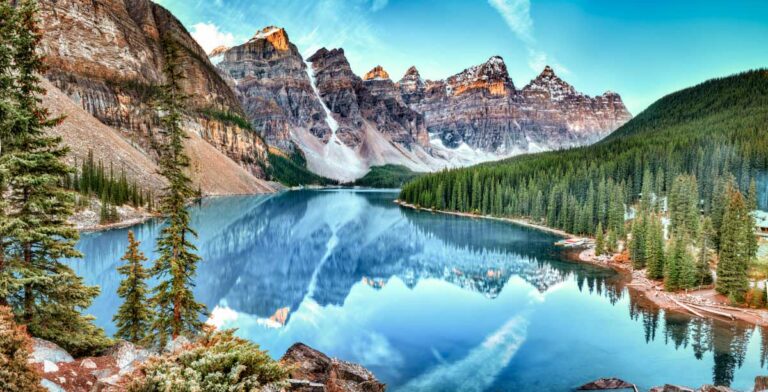
Hey – What an amazing blog, thank you so much.
If you had an extra 3-4 days, where would you spend them? Additional destinations or adding more days to places like Banff and Jasper?
Thank you SO MUCH (!) for putting this together. I am planning a canadian rockies road trip with my dad this summer and this is perfect. I honestly dreaded planning a bit because I know how much there is to do / see and to think of but this just made my life so much easier and now I can’t wait!
Leave a Reply Cancel reply
Your email address will not be published. Required fields are marked *
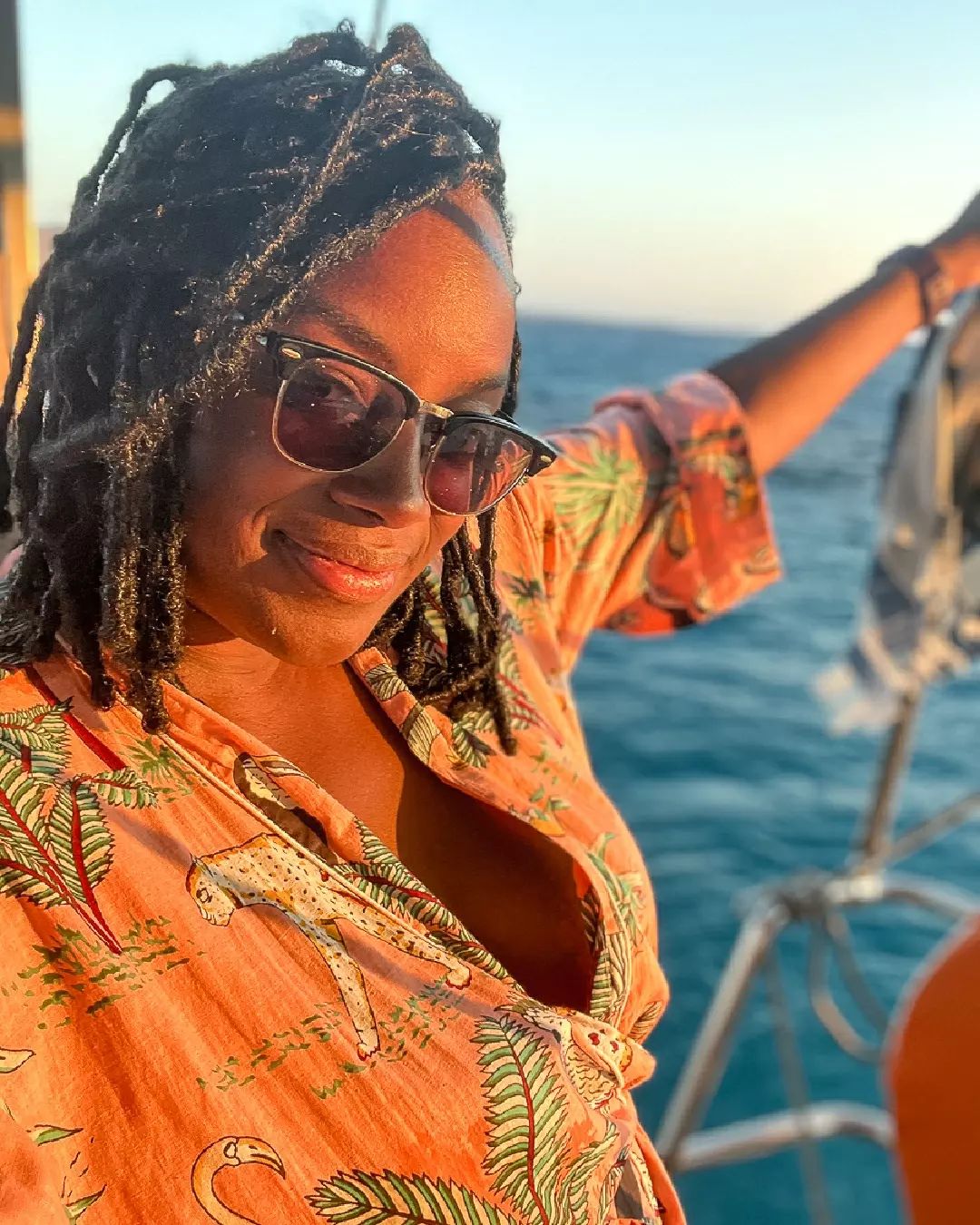
Follow me on Instagram for travel inspiration, tips, and guides.

Canadian Rockies Road Trip Loop: Detailed 9 to 12 Day Itineraries + Map
Want to explore both sides of the Canadian Rockies (Alberta and British Columbia) and drive a circular road trip route? This Canadian Rockies road trip loop may be the perfect choice for you!

Road trippers can easily ‘join’ the loop from either Calgary or Vancouver, Western Canada’s two biggest cities. Car rentals are usually much cheaper when picking up and dropping off at the same location.
This Canadian Rockies loop route is easy to combine with other BC road trip destinations, such as the Okanagan Valley , Slocan Valley ( hot springs ) and the Columbia Valley (Radium, Invermere).
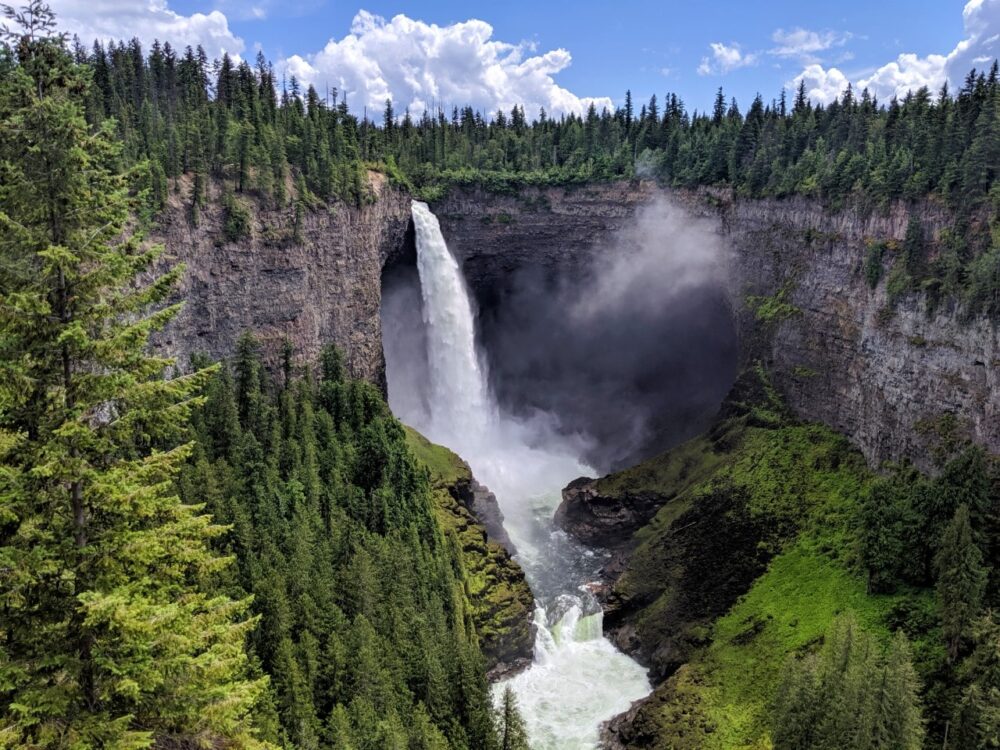
JR and I have been exploring the Canadian Rockies (and surrounding mountain ranges) for more than a decade.
This road trip route is very similar to one I recently organised for my parents, who were visiting from the UK. I wanted them to see the most iconic sights in the Canadian Rockies and also some quieter, off-the-beaten-track locations as well.
This detailed guide includes a day-by-day overview of the entire Canadian Rockies loop road trip itinerary, as well as planning tips to help save you money (and stress!) along the way.
Here’s what to expect:
Road trip itinerary at a glance
Need to know info.
- Exploring Banff
- Banff National Park
- Banff to Jasper
- Jasper National Park
- Jasper to Valemount
- Valemount to Kamloops
- Kamloops to Revelstoke
- Revelstoke to Golden
- Golden to Banff
Camping details
- Alternative itineraries
More planning resources
Published December 2023. This post includes affiliate links. If you make a purchase or booking through one of these links, we may receive a small percentage of the sale. All prices in this post are Canadian dollars.

Canadian Rockies Loop road trip overview
Time to start planning a Canadian Rockies loop road trip! This section of the guide provides an overview of the itinerary with a map and some important need-to-know information
Before we go any further, here is a look at the entire 9 road trip itinerary from start to finish (there is a 12 day version later in the guide):
Day 1 : Banff* Day 2: Banff Day 3: Banff to Jasper Day 4: Jasper Day 5: Jasper to Valemount
Day 6: Valemount to Kamloops Day 7: Kamloops to Revelstoke Day 8: Revelstoke to Golden Day 9: Golden to Banff**
*If beginning in Calgary, add 126km (90 minutes) drive from city. From Vancouver, drive directly to Revelstoke and start the itinerary mid-way through day 7 . **If finishing in Calgary, add 126km (90 minutes) drive back to the city
If one glance at this routing makes you think ‘way too fast!’ then I suggest looking at the alternative itineraries noted at the bottom of the page.
Travelling to Canada from Europe? While it is easier and faster to drive long distances in Canada compared to Europe, you may find that this itinerary includes way too much driving for your preferences. Again, I would suggest checking out the alternative itineraries section.
Canadian Rockies loop road trip map

- This Canadian Rockies road trip route can be explored in either direction, though I would recommend counter-clockwise (and the itinerary below is written in that direction) to ensure you can visit certain places early in the day
- The best time to drive this road trip is July to September . June can also be a good time, though some activities and trails will have limited accessibility at this time
- This itinerary is relatively fast-paced . If you choose to do most of the activities listed, you will likely be busy all day
- Need more downtime? Stretch this itinerary over a longer period or skip some of the activities/stops
- The route and suggested activities are aimed at people who enjoy exploring nature and being active while on vacation
- Please keep in mind that this Canadian Rockies road trip route offers just a taste of the activities and hiking trails on offer in these locations. It is impossible to do everything in such a relatively short road trip
- Before you leave home , learn how to avoid negative bear encounters and basic outdoor safety . If you see a bear while driving, stay in your vehicle!
- When exploring , be sure to always Leave No Trace (dispose of trash properly, stay on established trails, don’t feed wildlife)
- More tips and advice in our BC trip planning guide

Day-by-day Canadian Rockies loop road trip guide
Read on to discover a detailed breakdown of this Canadian Rockies loop road trip itinerary, including where to stay and what to do each day.
Day 1: Banff
Calgary to Banff driving distance: 127km Driving time without activities : 1 hour 30 minutes
*If beginning in Calgary, add 126km (90 minutes) drive from the city. If beginning in Vancouver, drive directly to Revelstoke and read the itinerary from day 7
There are so many different things to do in the picture-perfect mountain town of Banff and surrounding Banff National Park .

For many people, visiting spectacular Moraine Lake and Lake Louise is a priority. I’ve put them on the schedule for day 2.
My top picks for things to do in and around Banff Townsite:
- Explore the shores of Two Jack Lake and then cruise the Lake Minnewanka Scenic Drive (24km). Keep your eyes peeled for wildlife. Walk the shoreline trail or consider renting a canoe ($85/hour)
- The best free vehicle-accessible viewpoint is the Mt Norquay Lookout . It’s completely free and offers amazing vistas of Banff and surrounding peaks
- Thrill seekers will love the Via Ferrata course at Mt Norquay! The experience offers a safer way to experience climbing in the Rockies (and the views are AMAZING)
- Feel like a hike? The 2km uphill trail to the top of Tunnel Mountain is well worth the effort (300m elevation gain) as it ascends the slopes of this prominent landmark

- If that sounds like too much, reserve a spot on the Banff Gondola that ascends to the top of Sulphur Mountain . The views are simply spectacular. I’d recommend taking the bus (route 1) to avoid having to find parking at the gondola base
- Explore downtown Banff and enjoy the views of the surrounding mountains while browsing the wide range of shops
- If the shopping area doesn’t appeal, take a walk along the Bow River to see the falls . If you have the time, continue to the Surprise Lookout , which features views of the iconic Fairmont hotel
Side note here regarding accommodation. It’s no secret that Banff is not a cheap place to stay.
If your budget doesn’t stretch to it, consider the nearby town of Canmore instead (still touristy but more of a local vibe, slightly lower prices).
Where to stay
Budget Our preferred Banff campground for tent camping is Tunnel Mountain Village 1 . The sites are relatively private and the campground is just a short bus ride away from downtown
Mid-range Our favourite downtown hotel is Moose Hotel & Suites (walking distance to everywhere, rooftop hot tub). In Canmore , the Pocaterra Inn offers one of the best value stays in town
Luxury For a once-in-a-lifetime visit to Banff, consider the Fairmont Banff Springs or the Rimrock Resort . The latter has truly incredible views across Banff and the surrounding mountains
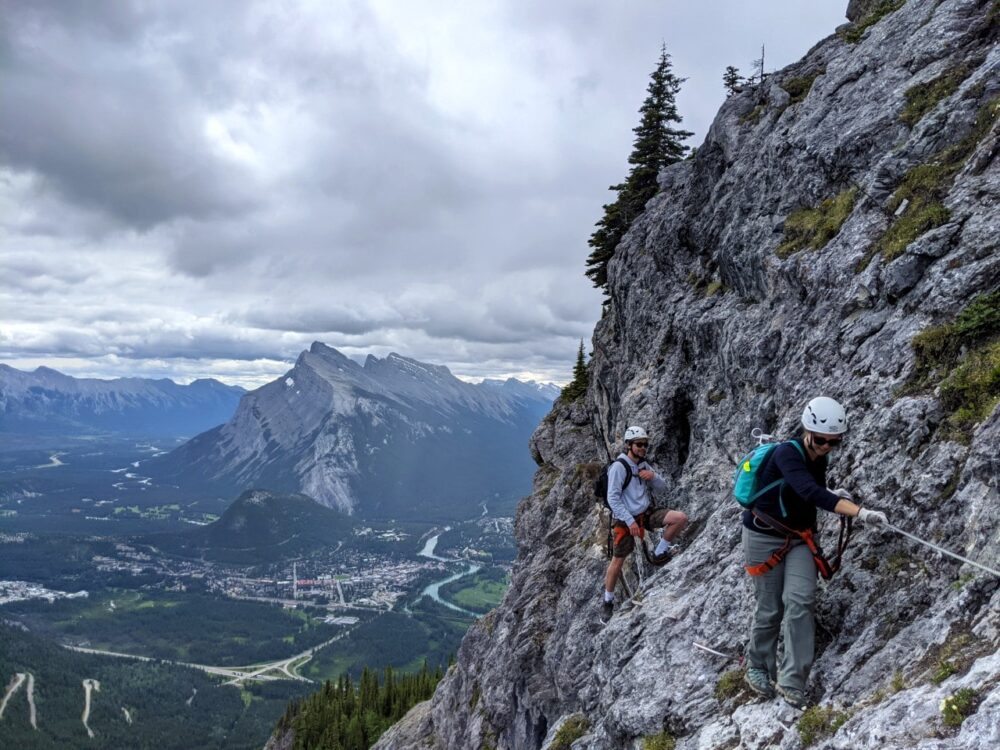
Day 2: Explore Banff National Park
Driving distance: 133km Driving time without activities : 1 hour 30 minutes
Start your day with a visit to Banff National Park’s most famous lakes – Lake Louise and Moraine Lake . Please note that Moraine Lake is usually open from late May to early October only.
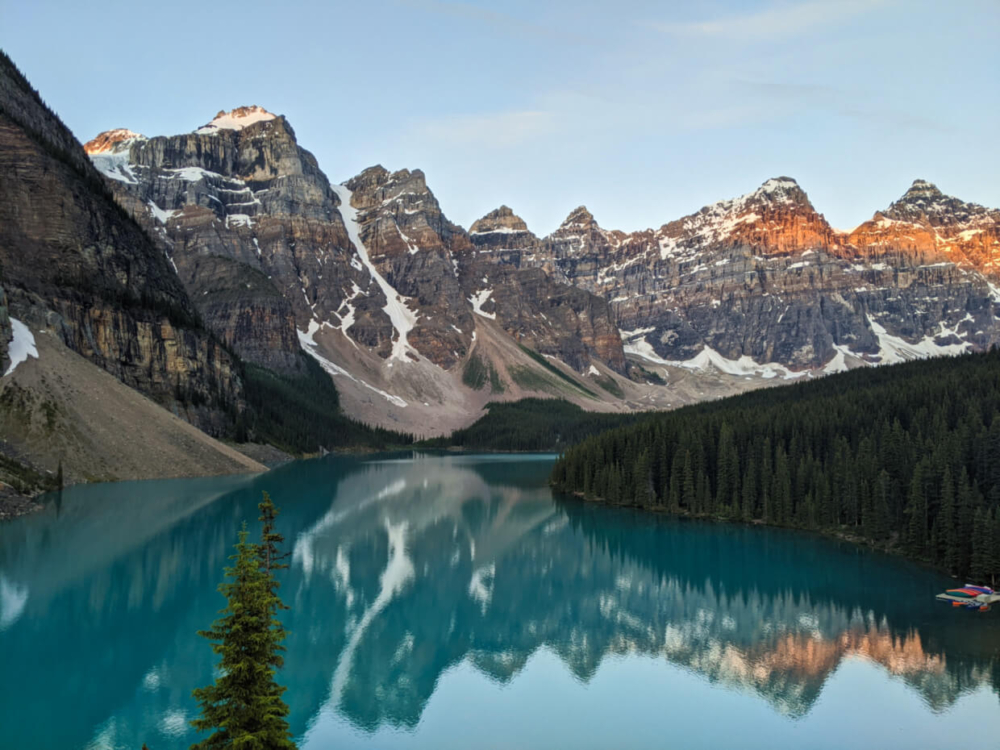
Since Moraine Lake is only accessible by bus and Lake Louise parking is very limited (and also $21/day!), there are two main options:
- Use the Parks Canada park-and-ride shuttle ($8) located at Lake Louise Ski Resort, 45 minutes drive from Banff. There are regular reservable buses to Lake Louise and Moraine Lake, with a Connector Shuttle.
- 8X Roam Transit bus from Banff to Lake Louise Lakeshore. This reservable express bus takes 55 minutes. The $25 Roam System Wide Pass includes access to the Parks Canada Lake Connector Shuttle to Moraine Lake
In addition to spectacular lakeshore views, both lakes have great hiking opportunities.
Lake Agnes is a very popular destination from Lake Louise, 7.4km return with 390m elevation gain (allow 2 to 2.5 hours, note that it is uphill almost the entire way).
Back in Banff, fill your afternoon with any activities you may have missed yesterday. If you already purchased the $25 Roam bus pass, use it to take the bus to the base of the Banff Gondola (avoiding the need to walk or find parking!)

Day 3: Banff to Jasper via Icefields Parkway
Banff to Jasper driving distance: 290km Driving time without activities : 3 hours 40 minutes
Depart Banff early to visit Johnston Canyon (32km, 35 minutes drive). Suspended metal walkways provide secure passage through the deep gorge to a series of waterfalls.
The 2.4km return hike to the Lower Falls takes less than 1 hour. The Upper Falls are 5km return. Johnston Canyon is usually very busy from 10am onwards, so I would recommend getting here by 9am at the latest.

Make a stop in Lake Louise for gas and supplies before hitting the road to drive Icefields Parkway (Highway 93) along the Continental Divide.
Often cited as one of the best road trips in the world, the Icefields Parkway is lined with towering mountains and immense glaciers, providing jaw-dropping vistas no matter where you look.
Driving the 230km Icefields Parkway without stopping takes around three hours. To visit most of the mentioned stops, allow five to six hours. Plan to arrive into Jasper early in the evening.

My favourite roadside viewpoints are Crowfoot Glacier , Bow Lake, Waterfowl Lake , Weeping Wall , the Big Bend , Tangle Creek Falls and the Goats and Glacier Lookout (all are featured on our road trip map ).
My recommendations for must-see places are:
- Bow Lake – Take a walk along the lakeshore of this beautiful vibrant blue lake surrounded by dramatic mountains
- Peyto Lake – Uphill 1km return trail (mostly paved) to an elevated viewpoint over a gorgeous turquoise lake
- Wilcox Pass Trail to Viewpoint – 3.4km return uphill hike to lower viewpoint (red chairs) over Athabasca Glacier, 9.5km return for upper viewpoint
- Sunwapta Falls – 200m walk to Upper Falls, featuring a bridge viewpoint of a dramatic waterfall cascading into a deep limestone gorge
- Athabasca Falls – Powerful waterfall accessible within a very short walk of the parking area, optional side trail into the canyon (well worth the stairs!)
Jasper is half the size of Banff. With two nights here, you’ll be able to see some of the park’s most impressive sights and also enjoy the charm of the compact townsite.
Budget Campers have a choice of campgrounds in Jasper – we usually stay at Whistlers Campground , which was completely renovated a few years ago
Mid-range The Mount Robson Inn is a solid downtown accommodation pick, with free breakfast and a range of room configurations (great for families/larger groups)
Luxury Treat yourself with a stay at the Fairmont Jasper Park Lodge . The upscale resort is located on a 700-acre lakeside property with spa, heated pool, golf course and restaurants

Day 4: Explore Jasper National Park
Driving distance: 103km Driving time without activities : 2 hours 30 minutes
Jasper National Park is Canada’s largest, with the small town of Jasper at the centre of it all.
- Start your day early with a drive on the scenic Pyramid Lake Road (15km return, 30 minutes)
- Elk are very commonly seen on this narrow and winding road that first passes Patricia Lake before skirting the edge of Pyramid Lake itself
- Take a short walk on Pyramid Island and enjoy the views of Pyramid Mountain before returning to Jasper and heading to magnificent Maligne Lake (50km one-way)
- Pre-book a cruise to Spirit Island , one of Canada’s most iconic and spectacular sights
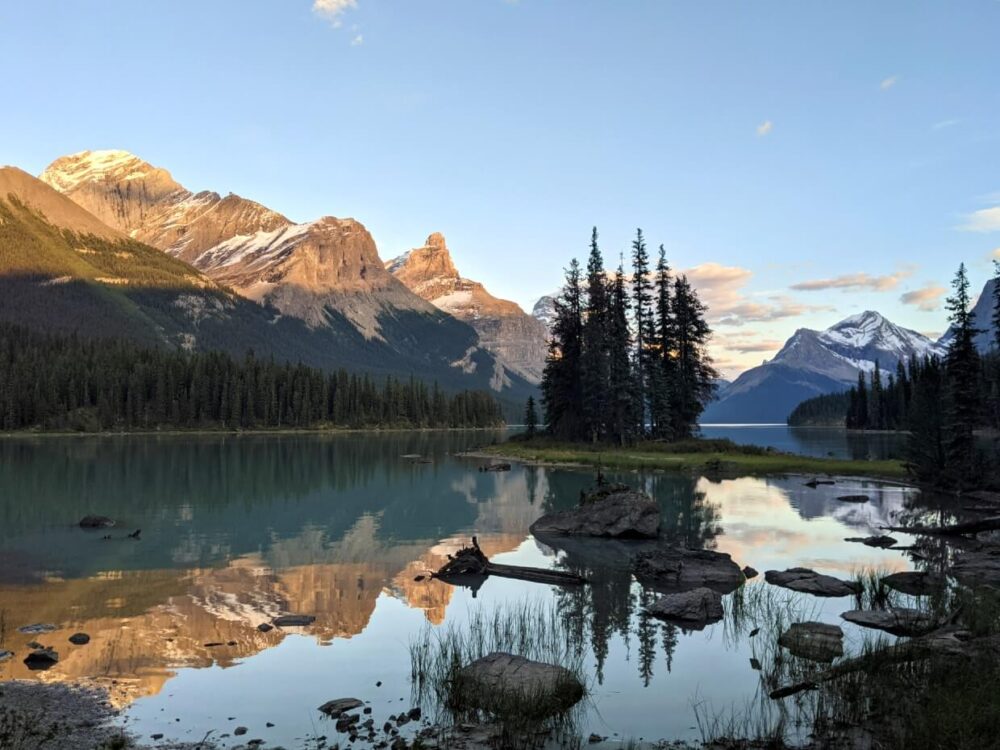
Yes, the cruise is super touristy but there’s no other way to see the true beauty of Maligne Lake in such a short amount of time ( paddling to Spirit Island takes around 6-8 hours return).
- On your way back to Jasper, stop at the Medicine Lake Viewpoint. This glacier-fed lake is famous for its ‘disappearing’ water.
- The second to last destination of the day is Maligne Canyon . There is a choice of loop and out-and-back routes here. The easiest is a very short 600m loop to Bridge #2 featuring impressive views of the rushing water and deep canyon
- For a longer experience, consider the hilly 5km out-and-back route to Bridge #5 . It includes numerous impressive viewpoints and even several waterfalls. There is a loop alternative but it’s less scenic as the path veers away from the canyon
- Before leaving the Maligne Lake Road area, check out the gorgeous views from the Maligne Lookout. The parking lot is the next right-hand turn after leaving Maligne Canyon

Day 5: Jasper to Valemount
Jasper to Valemount driving distance (via Mount Edith Cavell): 183km Driving time without activities : 3 hours 10 minutes
The drive between Jasper and Valemount is scenic and straightforward, though there are not many easily accessible roadside activities. For that reason, I would recommend spending your morning in Jasper National Park.
There are so many options for what you could do this morning but my top pick would be seeing Mount Edith Cavell and the Angel Glacier that flows down its north face.

The narrow and winding 27km Edith Cavell Road takes around 45 minutes to drive from Jasper. If you had more time to spare, I would suggest exploring the Edith Cavell Meadows Trail as well.
- Leaving Jasper, prepare to gain an hour at the British Columbia border (hooray!)
- Make a stop at beautiful Overlander Falls . Allow 30 minutes to walk to the main viewpoint and back
- Just around the next corner is Mount Robson , the highest peak in the Canadian Rockies (3954m). The best views are found right in the parking lot
- The Mount Robson Visitor Centre has some great indoor exhibits (and it is free!) and there’s a good café here as well
- Less than 10 minutes drive further on from Mount Robson is Rearguard Falls Provincial Park . A steep and short trail leads down to several viewing platforms of this thundering waterfall
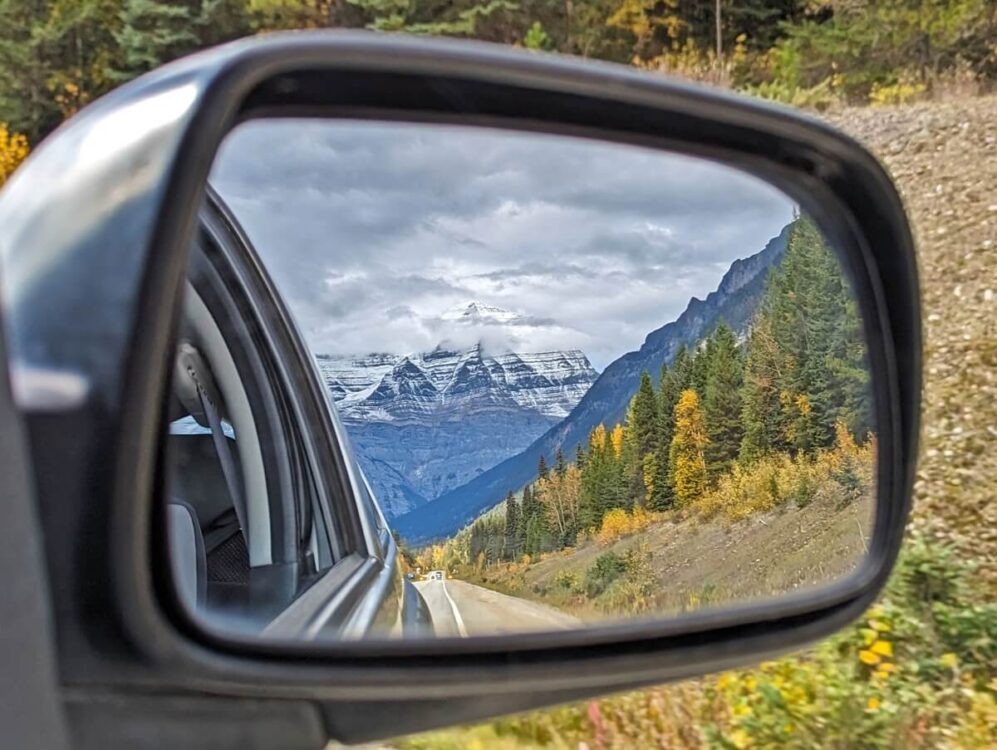
Turning onto Highway 5 towards Valemount reveals views of the ‘other’ side of the Canadian Rockies.
Valemount is a small village (pop 1052) with a surprisingly good choice of accommodation. There’s an excellent local brewery, a very popular Swiss-German bakery and an entry-by-donation museum.
Budget Valemount has several private RV parks . An alternative idea is to stay at one of Mount Robson’s provincial park campgrounds . I prefer Robson River over Robson Meadows, but both are good
Mid-range Canadas Best Value Inn Valemount is a no-frills option while the Comfort Inn & Suites offers more amenities and complimentary breakfast
Luxury The most upscale place in Valemount is the Best Western Plus . If you’re looking for something a little more unique and local, try Valemount Mountain Retreat Guesthouse

Day 6: Valemount to Kamloops
Valemount to Kamloops driving distance (via Wells Gray): 412km Driving time without activities : 5 hours
Start your morning with a couple of hours of driving through the lush North Thompson Valley.
The star attraction of this day is Wells Gray Provincial Park , one of BC’s most spectacular protected areas. It is a little more rustic (and much quieter!) than the national parks.
Part of a volcanic field that started forming approximately 3.5 million years ago, Wells Gray is host to 40+ spectacular waterfalls as well as glacier lakes, snow-capped mountains and more.
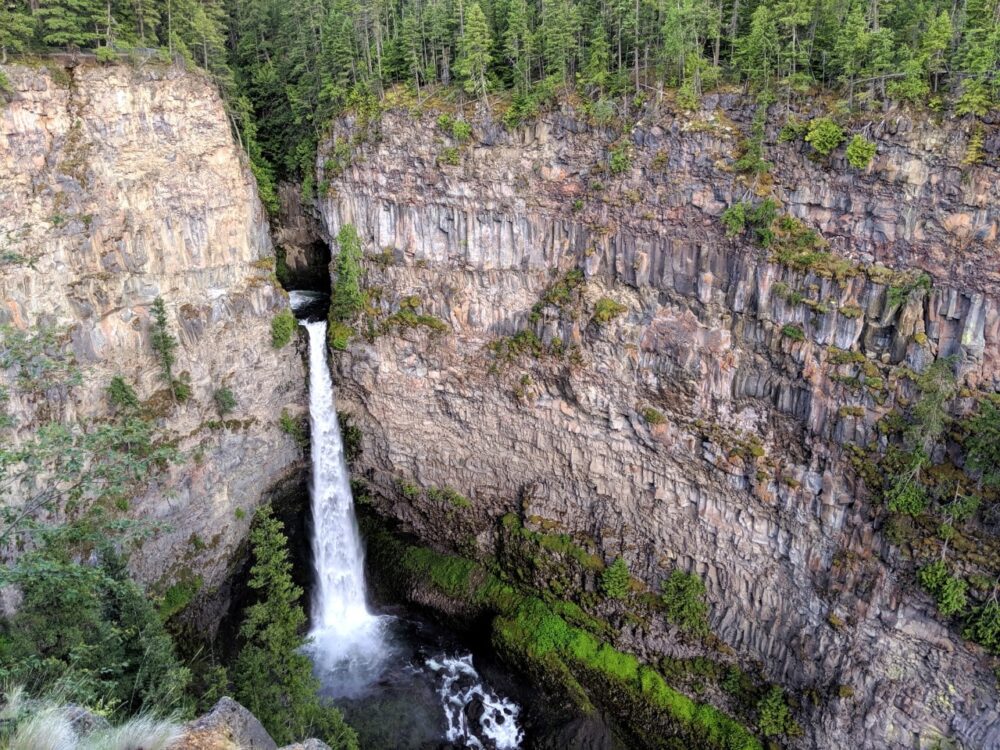
Once in Clearwater, turn onto Clearwater Valley Road and prepare for 2-3 hours of waterfall chasing!
- Spahats Creek Falls – 60m high narrow waterfall cascading into deep, wide canyon. It’s just a short walk from the parking lot
- Moul Falls . Optional stop since it is only accessible via a 6km return hike (half easy, half moderate). Short waterfall in rocky bowl
- Dawson Falls. Reminiscent of a small-scale Niagara Falls, this waterfall stretches wide across the river. 900m return
- The Mushbowl – Fast, frothy and rocky waterfall by roadside, just after Dawson Falls parking lot
- Helmcken Falls – Magnificent 141m high waterfall plunging into a rugged canyon. Short walk from the large parking lot
Beyond Helmcken Falls, the road is unpaved. For travellers with more time, the Ray Farm Trail is a pleasant 3km return (homesteading history, interesting mineral springs). The 1.6km return trip to Bailey’s Chute Trail combines both waterfalls and rapids.

Leaving Wells Gray Provincial Park, the drive to Kamloops is pretty straightforward. Watch for the Canadian Mountaineer train on the parallel tracks!
Kamloops has a wide choice of accommodation and eateries. An alternative overnight destination would be Salmon Arm. The drive would take around an hour longer.
Budget Pauls Lake Provincial Park has a charming forested campground within walking distance of sandy beaches. The park is 25km from Kamloops
Mid-range Kamloops’ best value accommodation is found at… Canadas Best Value Inn (seriously!) Another good option is the downtown Plaza Hotel
Luxury For upscale lodgings in the downtown area, book a stay at the Delta Hotel . The location is convenient for restaurants and also when arriving from Highway 5
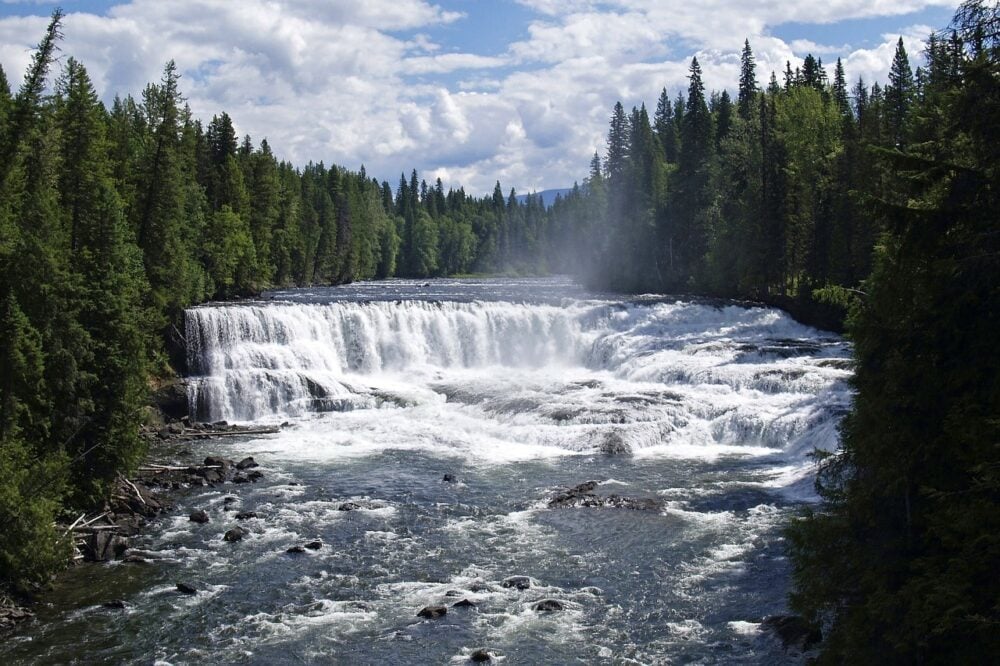
Day 7: Kamloops to Revelstoke
K amloops to Revelstoke driving distance: 212km Driving time without activities : 2 hours 30 minutes
Kamloops is situated in British Columbia’s dry grasslands region and consequently, the landscape looks very different to anything else on this Canadian Rockies loop road trip.
I don’t have that many recommendations for must-see stops between Kamloops and Revelstoke – plan to spend most of your time in Revelstoke itself.
- Monte Creek Winery is worth a look if you reach it after 11am
- On a hot day, the Blind Bay beaches on Shuswap Lake can be great for a refreshing dip
- Salmon Arm makes for an excellent lunch stop. The DeMille’s Farm Market sells fresh produce from the Shuwap region throughout the summer months
- Just past Sicamous is D Dutchmen Dairy , a family farm selling homemade ice cream, cheese and milk. Note that it does get very busy around lunchtime
- The drive along Highway 1 from Sicamous to Revelstoke has plenty of pretty sections but not many places to stop. One of our favourite rest areas is the Last Spike , a historical site celebrating the completion of the railway connecting eastern and western Canada
Arriving in Revelstoke sometime in the early afternoon, I’d suggest making the most of the day with a scenic drive on the 26km long Meadows in the Sky Parkway into the subalpine of Mount Revelstoke National Park (park pass required).

At the end of the road, there is an uphill 1km long trail to the summit area (1947m). If you’ve never visited the top of a mountain, this is a great way to do it. There is a choice of short trails, all with interpretive signage.
If you’re travelling with kids, you may want to prioritise visiting Revelstoke Mountain Resort instead, home of the 42km/h Pipe Mountain Coaster .

Whatever you do, make sure you spend some time in downtown Revelstoke. It’s one of my favourite mountain towns in BC (friendly vibes, great range of shops and restaurants, plenty of history).
For travellers who have another night to spend in Revelstoke, I would recommend white water rafting with Apex or a hike on the wonderful Eva Lake Trail (14km return) which starts at the summit of Mount Revelstoke.
Budget Snowforest Campground in Mount Revelstoke Park is convenient for the Meadows in the Sky Parkway. Alternatively, try Martha Creek Provincial Park
Mid-range The Swiss Chalet Motel offers excellent value for families and larger groups. Basic breakfast included and the property is only 10-15 minute walk to downtown
Luxury The stylish rooms at the historical Regent Hotel are surprisingly spacious. The complimentary breakfast buffet is the best I’ve had anywhere in Canada

Day 8: Revelstoke to Golden
Revelstoke to Golden driving distance: 148km Driving time without activities : 2 hours
Time to head further into the mountains! Begin the day with a short 500m stroll on the Highway 1 adjacent Giant Cedars Boardwalk in Mount Revelstoke National Park (closed in 2023 but hopefully open in 2024).
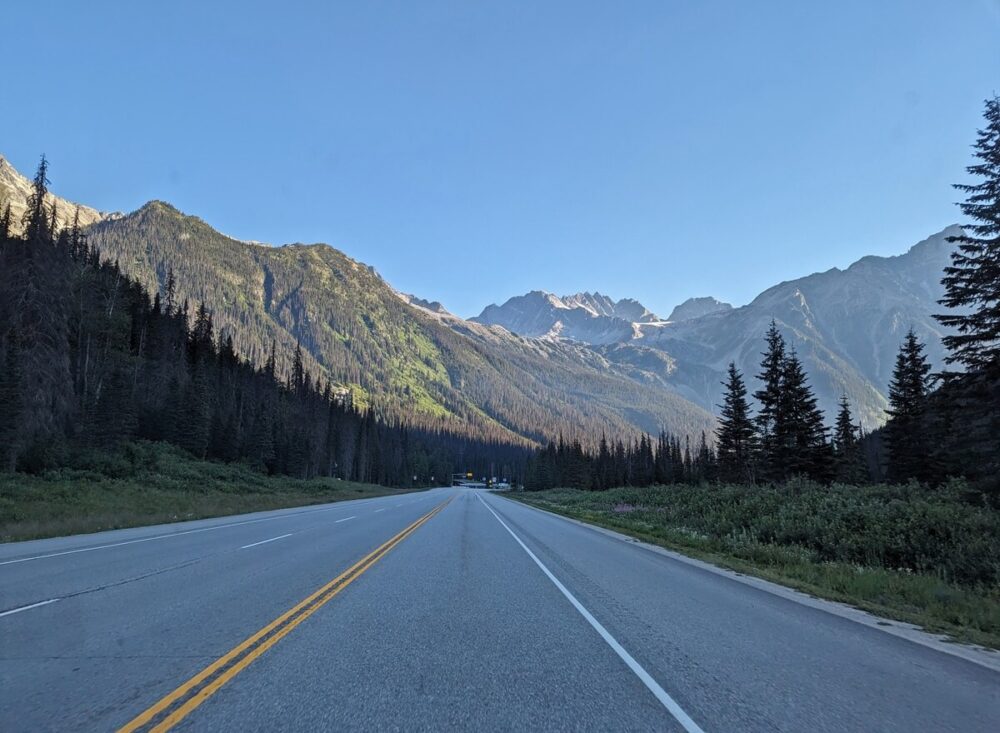
The surrounding valley slopes get steeper and steeper as the highway heads into Glacier National Park. Multiple snowsheds and tunnels provide avalanche protection for the road in winter.
- Two short hiking trails provide a taste of the surrounding national park – Hemlock Grove Boardwalk (350m) and the Rockgarden Trail (430m)
- For a longer hike, head to the Meeting of the Waters Trail (3.3km loop, starts from the Illecillewaet Trailhead).
- Most of the other hikes in this area of the park are very steep and require most of the day to explore (such as the Glacier Crest Trail ).
- The highest section of Highway 1 is at Roger’s Pass, with an elevation of 1327m. The Discovery Centre here is well worth the stop (free)
- Before leaving Glacier Park, consider the very short but steep hike to beautiful Bear Creek Falls (1km).
The time zone change , from Pacific Time to Mountain Time is just beyond the park’s border. Unfortunately, you’ll lose an hour when driving east. There are usually construction delays in this area too.

If you do get into Golden early, consider heading east through town towards Wapta Falls in Yoho National Park.
The 3.2km return hike (mostly flat, with some steep sections near the end) takes just over an hour with the destination an impressively wide waterfall surrounded by mountains.
Families and thrill seekers may prefer to check out the Golden Skybridge , host to Canada’s highest suspension bridges, or the Via Ferrata course at Kicking Horse Mountain Resort.
Budget For camping, consider the municipal campground , which backs onto the Kicking Horse River. An alternative is the Kicking Horse Campground in Yoho National Park
Mid-range Golden has a plethora of motels and chain hotels to choose from, with popular options being the Holiday Inn and Ramada (we’ve stayed at the latter twice)
Luxury Moberly Lodge ‘s quiet, spotlessly clean rooms are a welcome sight after a day exploring Glacier National Park. Outside, there are stunning views and a hot tub, ideal for a post-hike soak
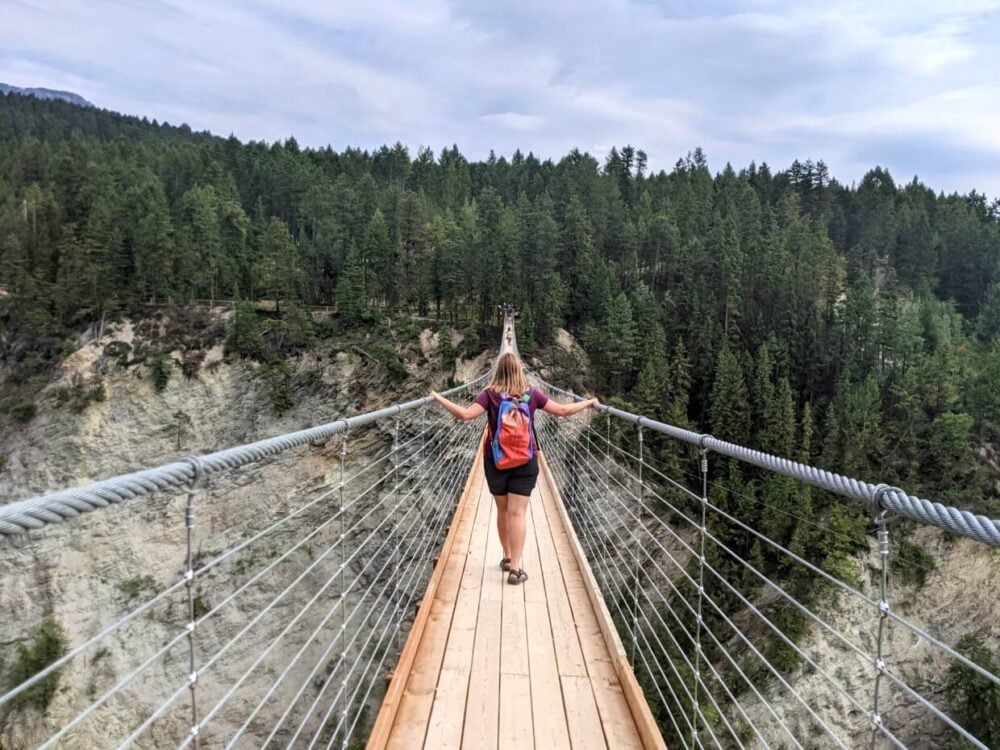
Day 9: Golden to Banff*
Golden to Banff driving distance (via Emerald Lake, Yoho Valley Road): 187km Driving time without activities : 2 hours 45 minutes
This day is all about Yoho National Park . In my opinion, Yoho is the most underrated park in the Canadian Rockies.

- The first stop today is Emerald Lake , which is as beautiful (or even more so!) as the name implies
- Enjoy the views, rent a canoe ($90/hour) or walk the family-friendly 5.2km loop trail around the lakeshore. Allow around 2 hours for the latter
- On the way back to Highway 1, make a stop at the Natural Bridge , where the mighty (and very cold!) Kicking Horse River has carved out a natural limestone bridge through erosion
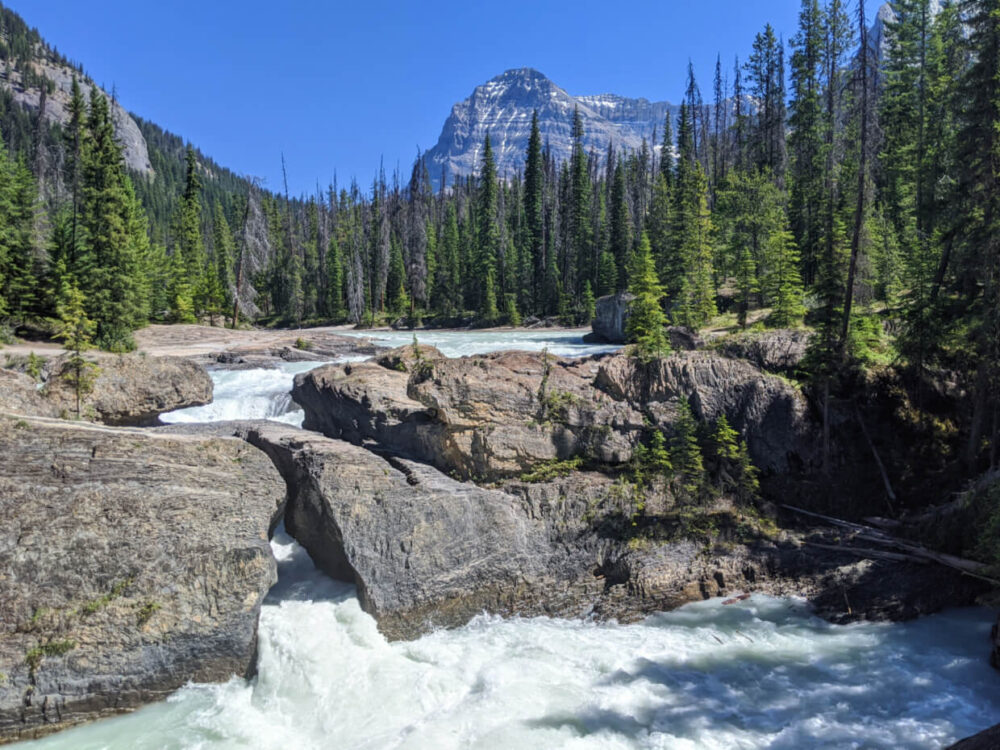
- The tiny community of Field hosts an excellent restaurant (Truffle Pigs) and Visitor Centre as well as impressive mountain views
- Next up is a scenic drive on Yoho Valley Road . Please note, this road is open from late June until Mid October only and has no services or phone signal. There are several tight switchbacks – trailers and large RVs are not permitted
- Takakkaw Falls , British Columbia’s second-tallest waterfall, is located at the end of Yoho Valley Road
- If you have an additional day to spend in Yoho, I would highly recommend a full-day hike on the Iceline Trail or a Burgess Shale guided tour
- The Spiral Tunnel Viewpoint is the last stop in Yoho. Depending on timing, you may be lucky and see a train pass through this impressive structure.
The remaining distance to Banff is impossibly scenic, with snow-capped mountains surrounding the highway.
If you have any spare time, Kootenay National Park’s Marble Canyon (15 minutes drive) is well worth the detour.
*If starting in Vancouver, plan to stay in Banff for the night and continue to ‘Day 1’ description next. If finishing in Calgary, add 126km (90 minutes) drive back to the city
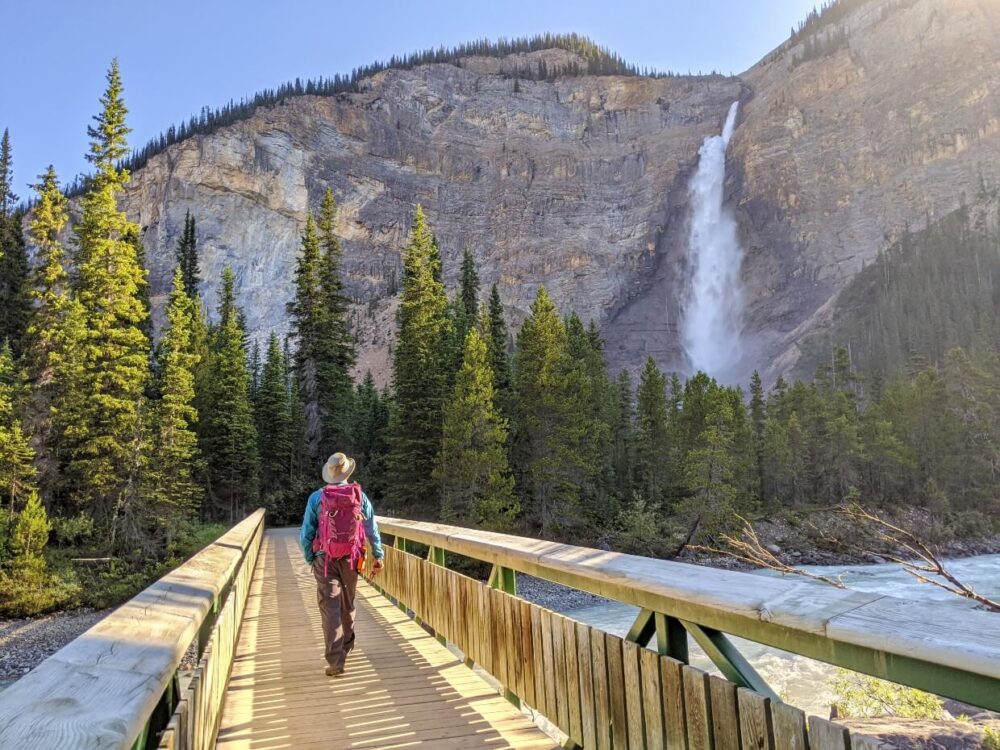
Canadian Rockies loop road trip: top tips
In this section, I will share some final thoughts about planning a Canadian Rockies loop road trip.
Money saving advice
- Gas is significantly cheaper in Alberta than in British Columbia , even in resort towns like Banff, Jasper and Lake Louise. Be mindful of where you gas up!
- Most of the overnight stops are in small towns. During the summer months, accommodation and dining availability and choice can be limited. Book early!
- This itinerary focuses on free activities over paid ones. I have, however, mentioned half a dozen paid attractions which I think offer one-of-a-kind experiences
- A national park pass is required to visit Jasper, Banff, Yoho, Glacier and Revelstoke national parks. All five parks are covered by the same day pass ($10.50/adult). If you plan to spend seven or more days in the parks (as you would with this itinerary), a Discovery pass provides better value
- Wells Gray Provincial Park and Mount Robson Provincial Park are completely free to visit
- The choice of restaurants and cafes is pretty limited on this Canadian Rockies road trip loop route. To save time and money, make your own lunch each day and buy plenty of snacks
The best way to save money while touring the Canadian Rockies is to camp.
- National park campgrounds (Parks Canada) average $30-50/night plus $11.50 reservation fee
- Provincial park campgrounds (BC Parks) average $20-40/night plus $6/night reservation fee
- Private campgrounds average $30-70/night
The downside is that you’ll need camping equipment. An alternative option is to rent an RV, so you can sleep in your vehicle.
It is possible to buy relatively cheap camping gear and accessories at Canadian stores like Walmart. A full set-up with an entry-level tent (4 person), sleeping bags (2), sleeping mats (2), stove and other essential supplies would cost around $500CAD.

The campgrounds mentioned in this Canadian Rockies loop itinerary are very popular and, as such, travellers should reserve in advance.
- Reservations for vehicle-accessible national park campgrounds usually open in January for the following summer. The exact launch dates are usually revealed during the preceding December. Parks Canada reservation website
- Reservations for vehicle-accessible provincial park campgrounds in British Columbia operate with a four-month rolling window . So if you want to book for 7th August, the date will be available to book on 7th April. BC Parks reservation website
Not mentioned in this post is the collection of excellent first-come, first-serve campgrounds along the Icefields Parkway. Consider staying at least one of these during your road trip (instead of Banff and/or Jasper).

Alternative road trip itineraries
While we think the above Canadian Rockies loop road trip itinerary provides a great overview of BC and Alberta, we know that may not be perfect for everyone.
The great news is that it is easy to adapt the route to create your perfect itinerary.
- Starting and finishing in Vancouver? Check out our 2 week Western Canada road trip itinerary
- Want to visit the Canadian Rockies AND Vancouver Island? We have a 2 week BC Coast and Mountains route for that too!

12 day Canadian Rockies extended road trip loop
If you have extra time and budget (up to 12 days), I would extend the original loop road trip itinerary like so:
Day 1 : Banff National Park Day 2 : Banff National Park Day 3 : Banff National Park Day 4 : Banff to Jasper Day 5: Jasper National Park Day 6: Jasper National Park
Day 7: Jasper to Valemoun Day 8: Valemount to Kamloops Day 9: Kamloops to Revelstoke Day 10: Revelstoke to Golden Day 11: Golden Day 12: Golden to Banff
This lengthened trip includes one additional night in both Jasper and Banff national parks and a second night in Golden. This would provide a much more relaxed pace and the chance to visit more attractions.
During the full day in Golden, explore the optional activities mentioned in this post such as Wapta Falls , Golden Skybridge or Kicking Horse Resort .
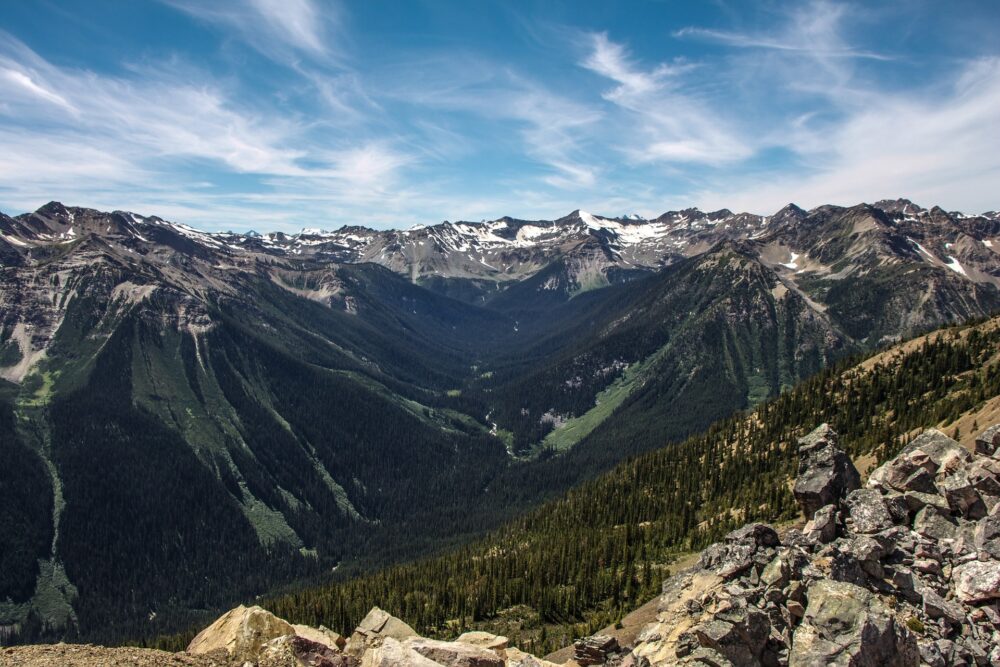
Okanagan Valley detour, 2 additional days
For an interesting contrast to the Canadian Rockies, consider a detour to the Okanagan Valley on your road trip.
The southern interior of British Columbia is host to a spectacular landscape of dry valleys, huge lakes and grasslands. Besides being beautiful, the Okanagan Valley is also Canada’s second-largest wine region. It’s also where we live!
If starting your Canadian Rockies road trip from Vancouver , I would detour via the Okanagan Valley on the way to/from the main loop described in this post. Plan to spend one night in Penticton, Peachland, Kelowna or Vernon.
Highway 97 travels through the centre of the Okanagan and then connects with Highway 1 near Sicamous (west of Revelstoke).
Read our suggestions for things to do between Vancouver and the Okanagan Valley before starting your planning.
Road trippers starting in Calgary could detour to the Okanagan Valley from Kamloops and return to the main loop route at Sicamous. Plan to spend the night in Kelowna, Peachland or Penticton.

8 day Canadian Rockies itinerary without a loop
If the concept of the loop doesn’t interest you, consider this alternate 8 day Canadian Rockies road trip itinerary which starts and finishes in Calgary:
Day 1 : Calgary to Banff Day 2 : Banff National Park Day 3 : Banff to Jasper Day 4 : Jasper National Park
Day 5: Jasper National Park Day 6: Jasper to Golden Day 7: Golden Day 8: Golden to Calgary
The first four days would follow the same itinerary as guided in this post.
On day 5, take a day trip to the Mount Robson area from Jasper OR explore more of Jasper National Park. Day 6 involves driving the Icefields Parkway again (never a bad thing!)
I have suggested two nights in Golden as the drive from Jasper is reasonably long, especially with sightseeing stops.
During the full day in Golden, explore the optional activities mentioned in this post OR take a day trip to Glacier National Park.

15 of the Best Day Hikes in British Columbia Ultimate 2 Week Western Canada Road Trip from Vancouver: Itinerary, Tips & Map What To Do in Wells Gray Provincial Park, British Columbia Toronto to Vancouver Road Trip: 24+ Great Places to Stop 5 Awesome Alternatives to Banff, Alberta The Best Hot Springs in BC: Complete Guide + Map
Adventure in your inbox
Subscribe to our monthly email newsletter and receive a round-up of our latest outdoor adventures plus other exciting beyond the beaten path destinations
We never share your information with third parties and will protect it in accordance with our Privacy Policy
Check out these recently published posts:

Little Peters Lake and Big Peters Lake, BC: Hiking Guide

Clearwater Lake and Azure Lake, Wells Gray: Complete Canoe Trip Guide

Rafting the Nahatlatch River: Unmissable Whitewater Rafting in BC
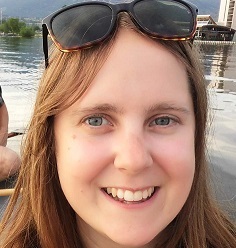
One half of the Canadian/British couple behind Off Track Travel, Gemma is happiest when hiking on the trail or planning the next big travel adventure. JR and Gemma are currently based in the beautiful Okanagan Valley, British Columbia, Canada
Andy & Linda Nette
Thursday 7th of December 2023
Thank you for this Canadian Rockies tours suggestions. For our 50th wedding anniversary, my wife and I have booked and paid a deposit on a 14 day river cruise in April ‘24 on the Danube, but have been unable to generate any excitement about it. After looking at your site, we have decided to forego our deposit, stay in Canada, and book as per your suggestions above. We appreciate the thoroughness of your research.
Hi Andy and Linda,
Wow, what a compliment! I'm sorry that your planned trip failed to inspire you but I'm so glad you've found an alternative! Happy to help :) Make sure you check out our 2 week Western Canada road trip itinerary as well.

COMMENTS
An unforgettable RV roadtrip experience! This 3-week Canadian Rockies Itinerary shows you the best places of British Columbia and Alberta.
The Ultimate Road Trip Itinerary for the Canadian Rockies. Updated: Jan 24. A 6-week hybrid road trip from California to Jasper showcasing the areas most scenic hiking trails and photography spots.
Two Weeks In The Canadian Rockies – An Epic Road Trip Guide for Motorhome Travellers and Nature Lovers (2024 Update) Thousands of kilometres of breathtaking mountain valleys and icefields three times the size of Paris, as well as more unique photography locations than you can visit in your lifetime.
A Breathtaking RV Road Trip in the Canadian Rockies. Tag along on a breathtaking RV tour of Banff, Jasper, Kootenay and Yoho, four Canadian national parks that exceed all expectations for eye-popping scenery.
Day 1: Calgary to Canmore. Day 2: Hiking in Canmore. Day 3: Banff Town & Iconic Sights. Day 4: Hiking in Banff National Park. Day 5: Lake Louise, Moraine Lake, & Johnston Canyon. Day 6: Icefields Parkway. Day 7: Hiking in Jasper. Day 8: Jasper Town & Iconic Sights. Day 9: Hiking & Sightseeing in Yoho National Park. Day 10: Return to Calgary.
Day-by-day Canadian Rockies loop road trip guide. Read on to discover a detailed breakdown of this Canadian Rockies loop road trip itinerary, including where to stay and what to do each day. Day 1: Banff. Calgary to Banff driving distance: 127km Driving time without activities: 1 hour 30 minutes